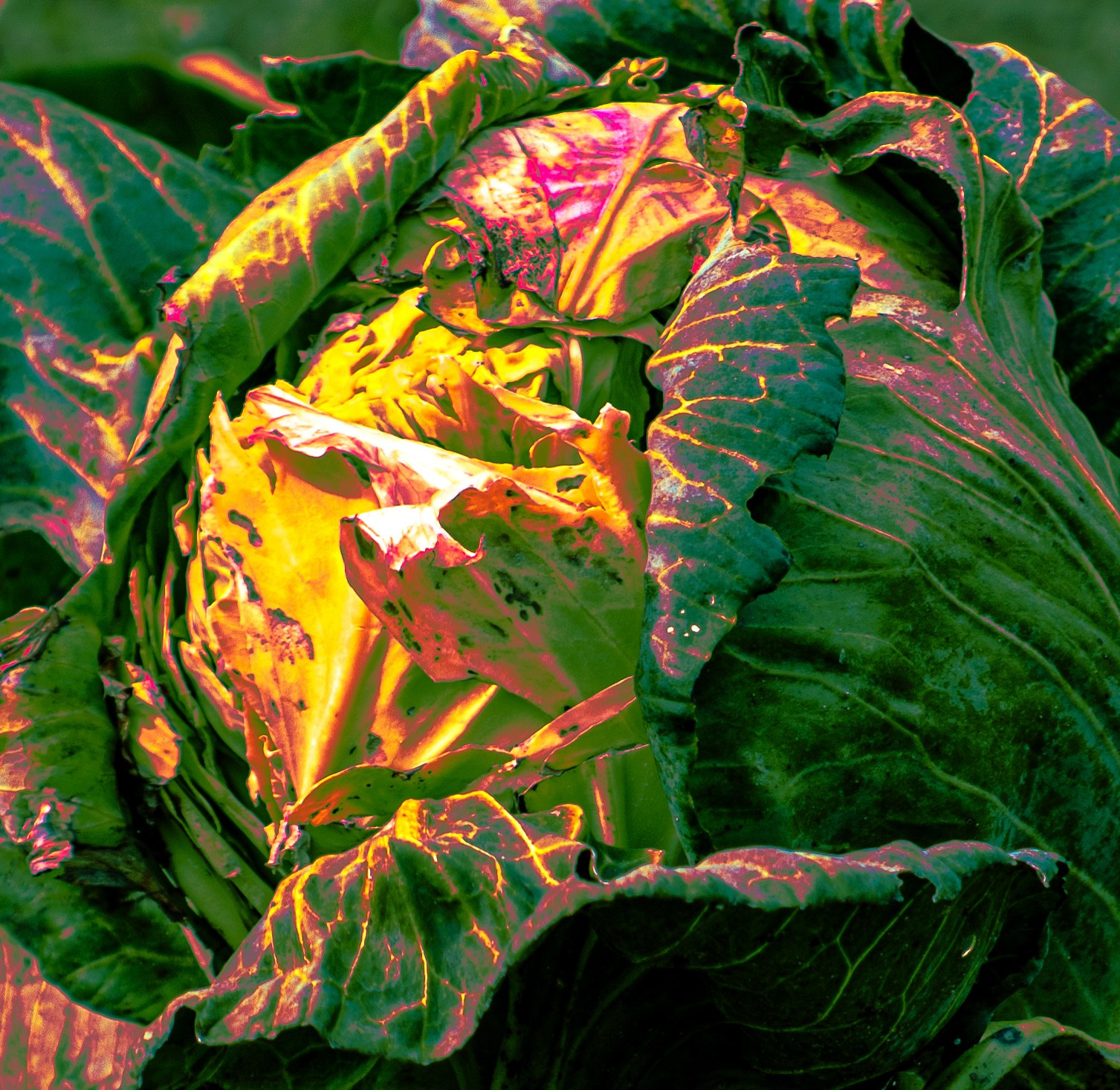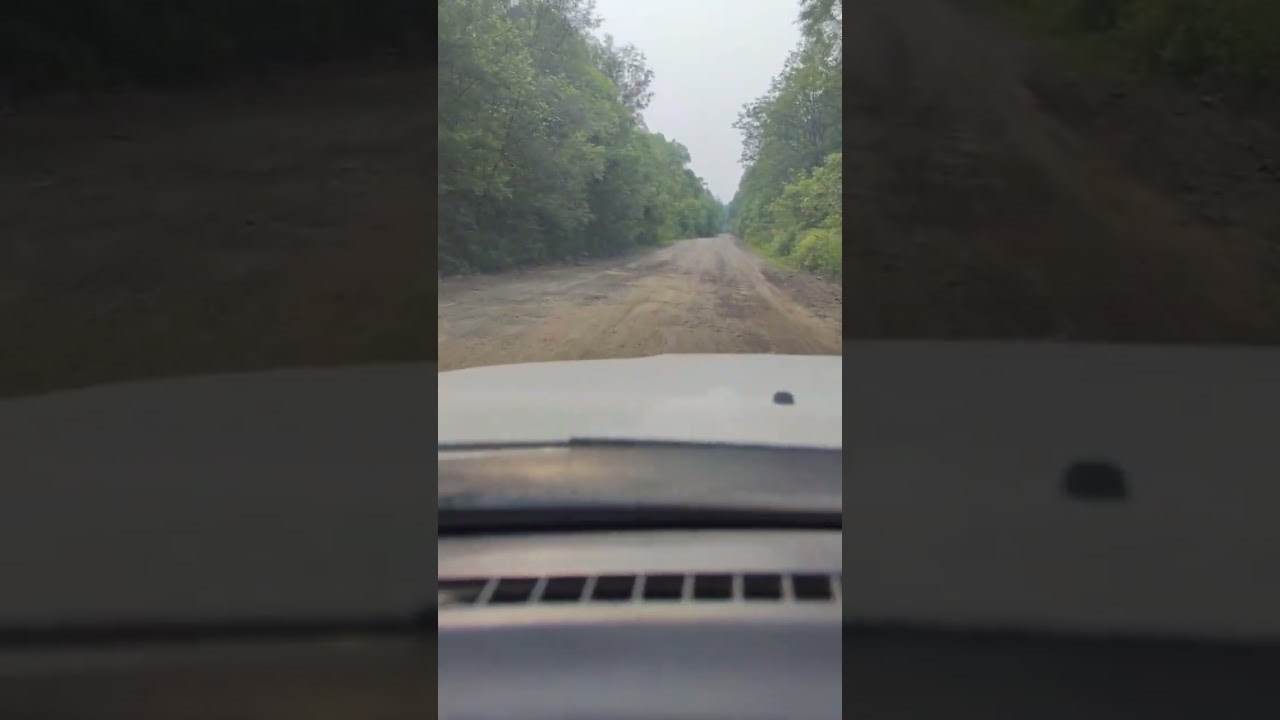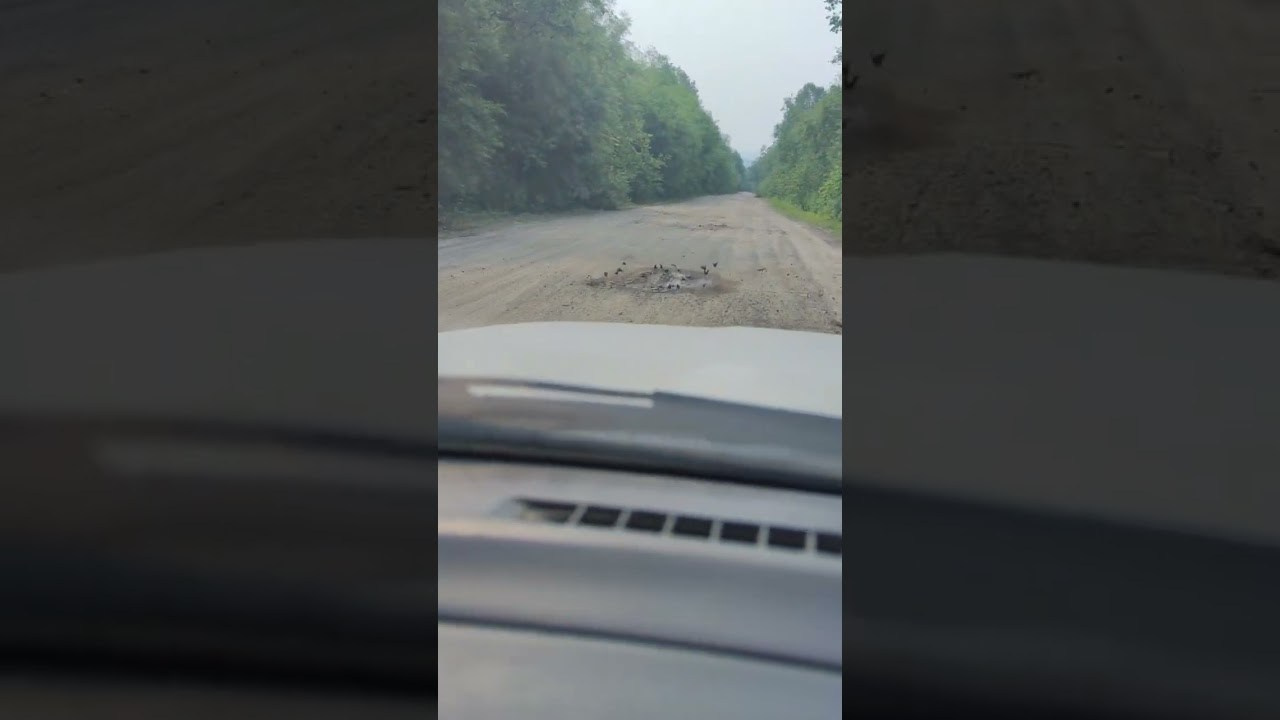
The ancient Udege people. An ancient people of the Far East. They engaged in hunting, fishing, and gathering. They roamed along rivers, through the taiga, facing wild animals, bad weather, illnesses, and hardships head-on.
“The homeland of grandfathers, fathers — the Sukpay River. My great-grandfathers found you. My great-grandfathers followed the otter’s trail from the Samarga River to you. They went to your very sources, and before that they saw large mountains and began to climb the pass. It was lower than Ulya Mountain. Ulya Mountain is the highest of all the Sukpay peaks, its bald peaks gleaming, and on its summit, where there used to be a lake, now the Kyakhta gleams white. On clear days, stars can be seen from the top of Ulya Mountain. Who knows when this was? Ancient legends are as scarce as the light of the morning star” from the book “Where the Sukpay Flows” by Dzhansi Kimonko.
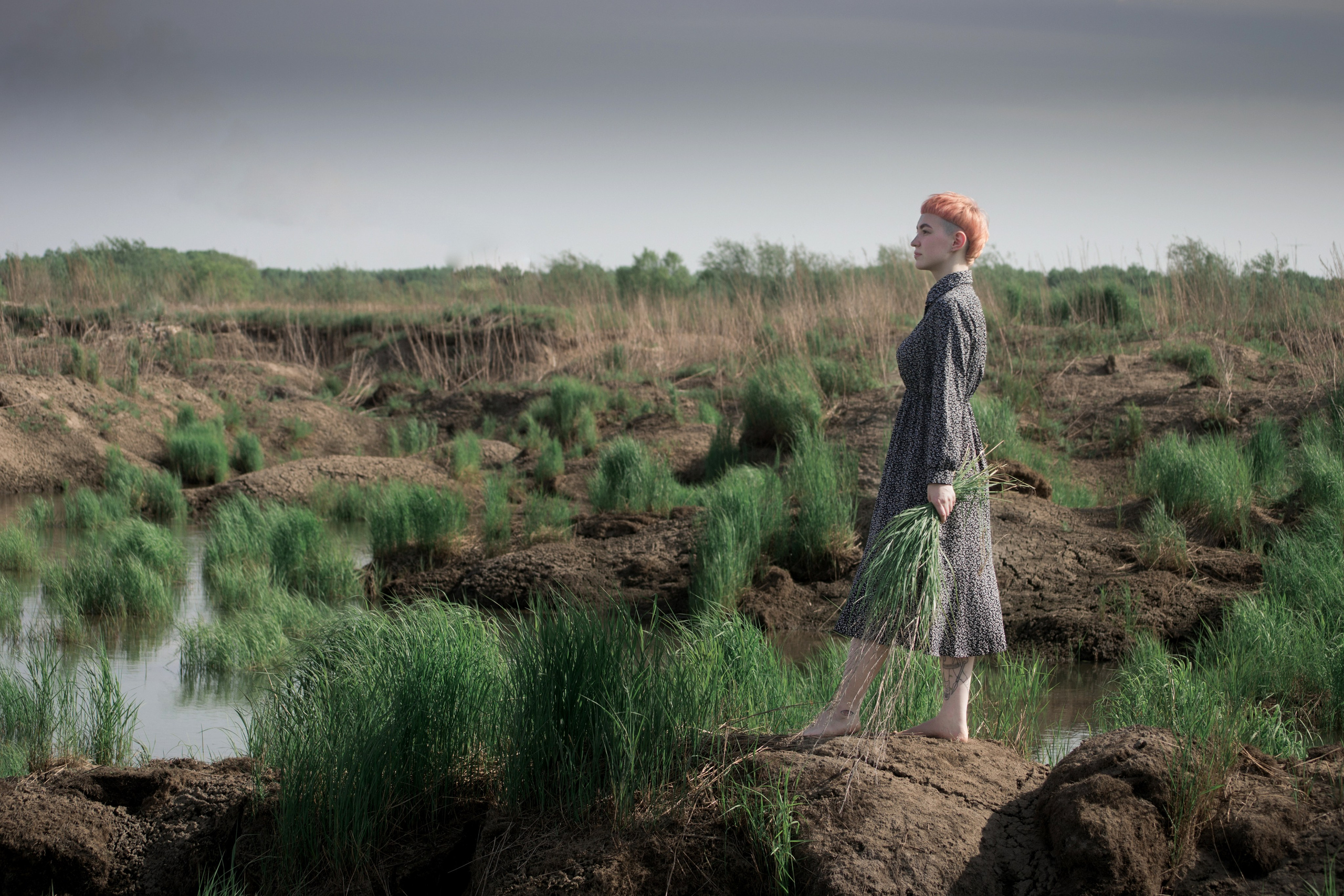
Descendant of an ancient lineage
I saw her at the medical college I had enrolled in, having left photography behind. She was striking, and everything about her drew attention: her clothes, her way of speaking, her poise. Back then, I knew nothing about her or her origins.
Perhaps because of my attention to Dasha’s personality, we were drawn together imperceptibly and became friends. The stronger our friendship grew, the more I learned about her and the Udege people. It was amazing to me that she knew not only the history of her people, but also the language.
No, she doesn’t speak it. There are few who can speak Udege at all. In the future, she will show me her native places and introduce me to her grandmothers: Andreyeva (Kyalyundzyuga) Nelly Ilyinichna and Kyalyundzyuga Larisa Ilyinichna. And it is here that I will understand how close the bond is between the middle daughters of the middle daughter.
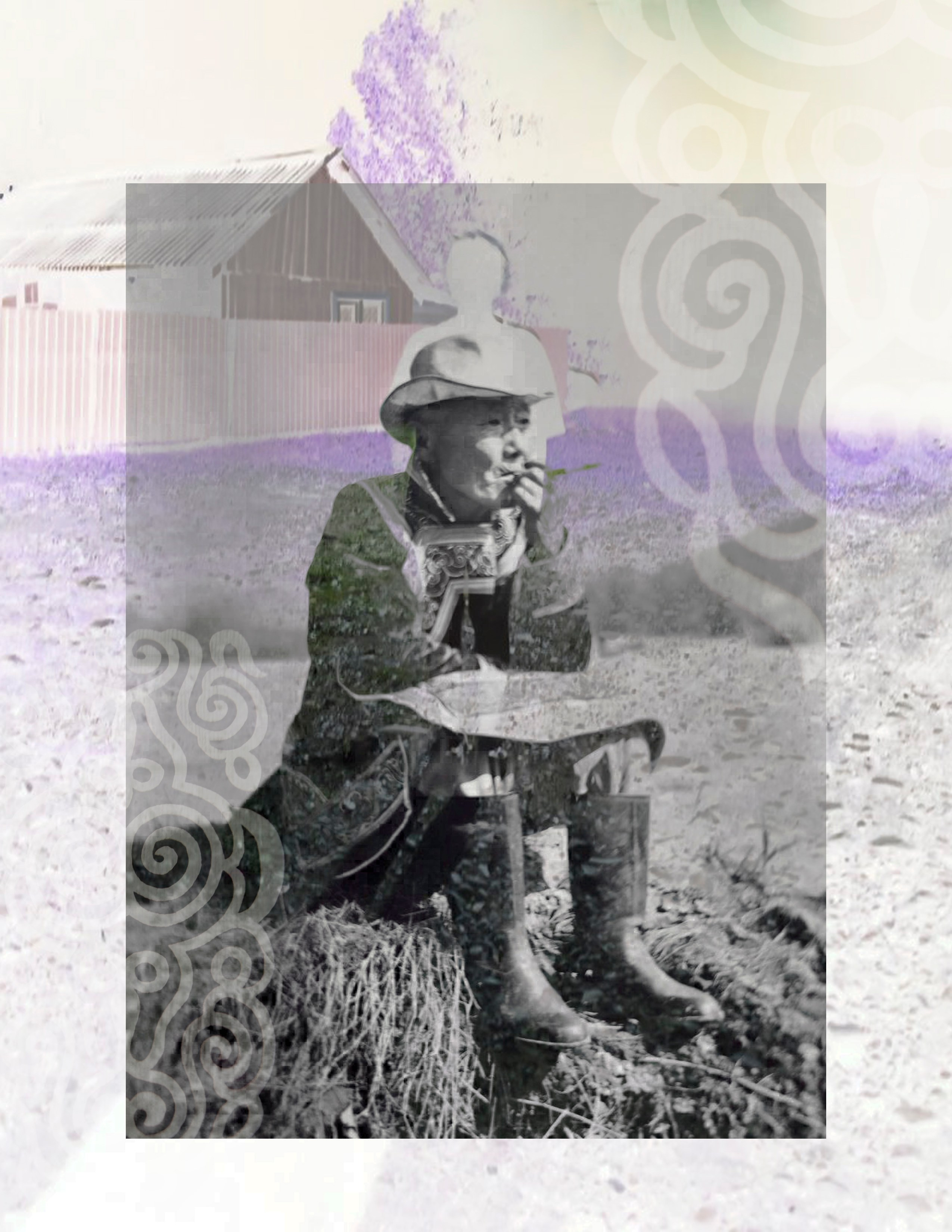
So: Udege people
The Udege people belong to the indigenous peoples of Siberia and the Far East, to the peoples of the North. Their number is approximately 1,325 people.
“There were many of them, and they were all called the Kia tribe. Once their leader, Kia, was famous for his strength and wisdom. But one day he entered into a war with another leader, Kukchinka, because of his beautiful daughter Alagda. The war was terrible. Kukchinka won. He killed Kia. He scattered his tribe across the mountains and forests.” “Where Sukpai Runs” by Jansi Kimonko.
The main occupations of the Udege people were hunting and fishing. Women were engaged in gathering, the home, and children. The Udege settled in the taiga along the banks of rivers. They moved from place to place, built huts, where they lived with the whole family with children and the elderly.
Life in the taiga taught the ancient people to notice a lot in nature, to protect it, to understand. Like any ancient people, the Udege have their own traditions that affect all spheres of life.
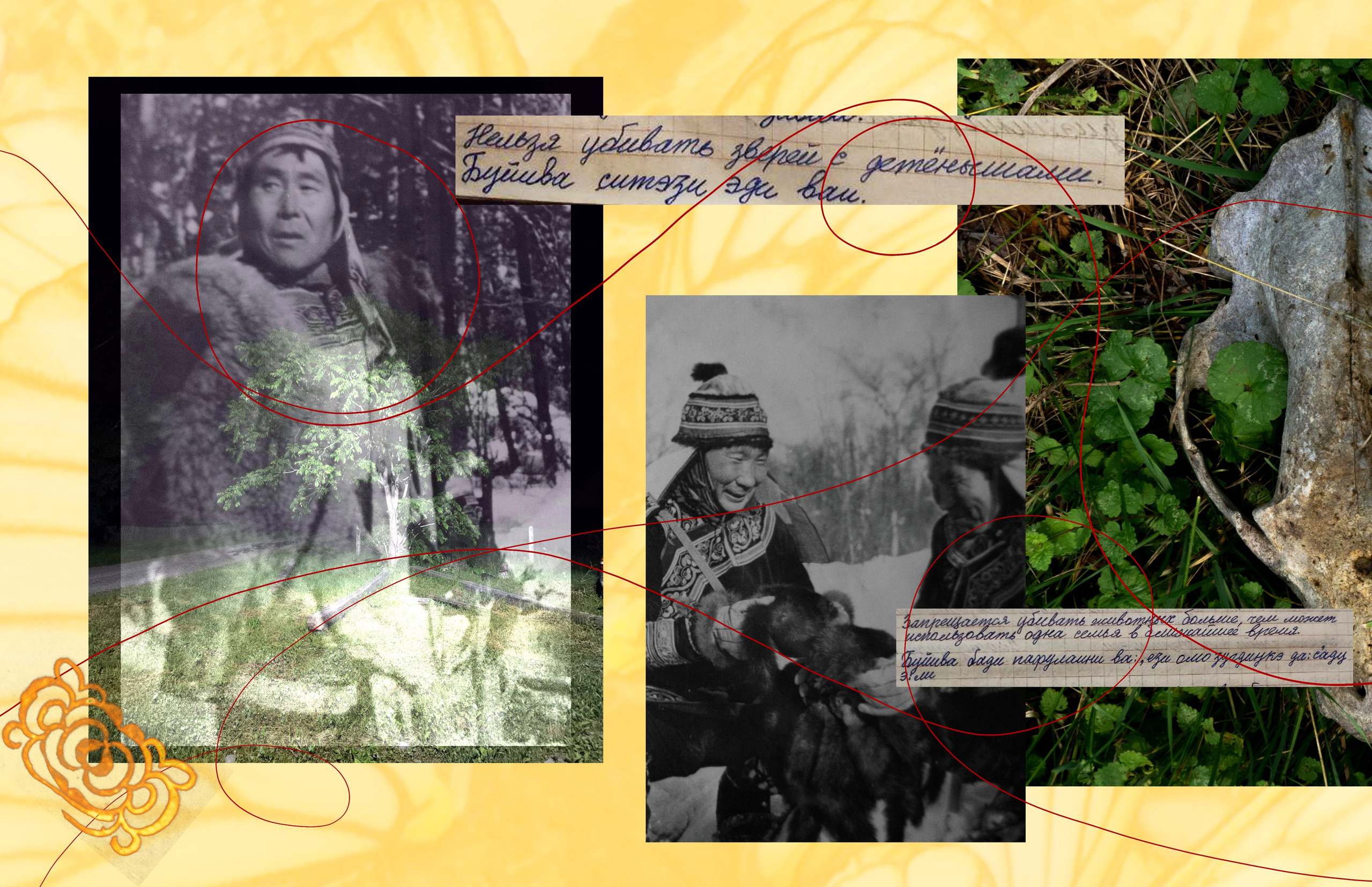
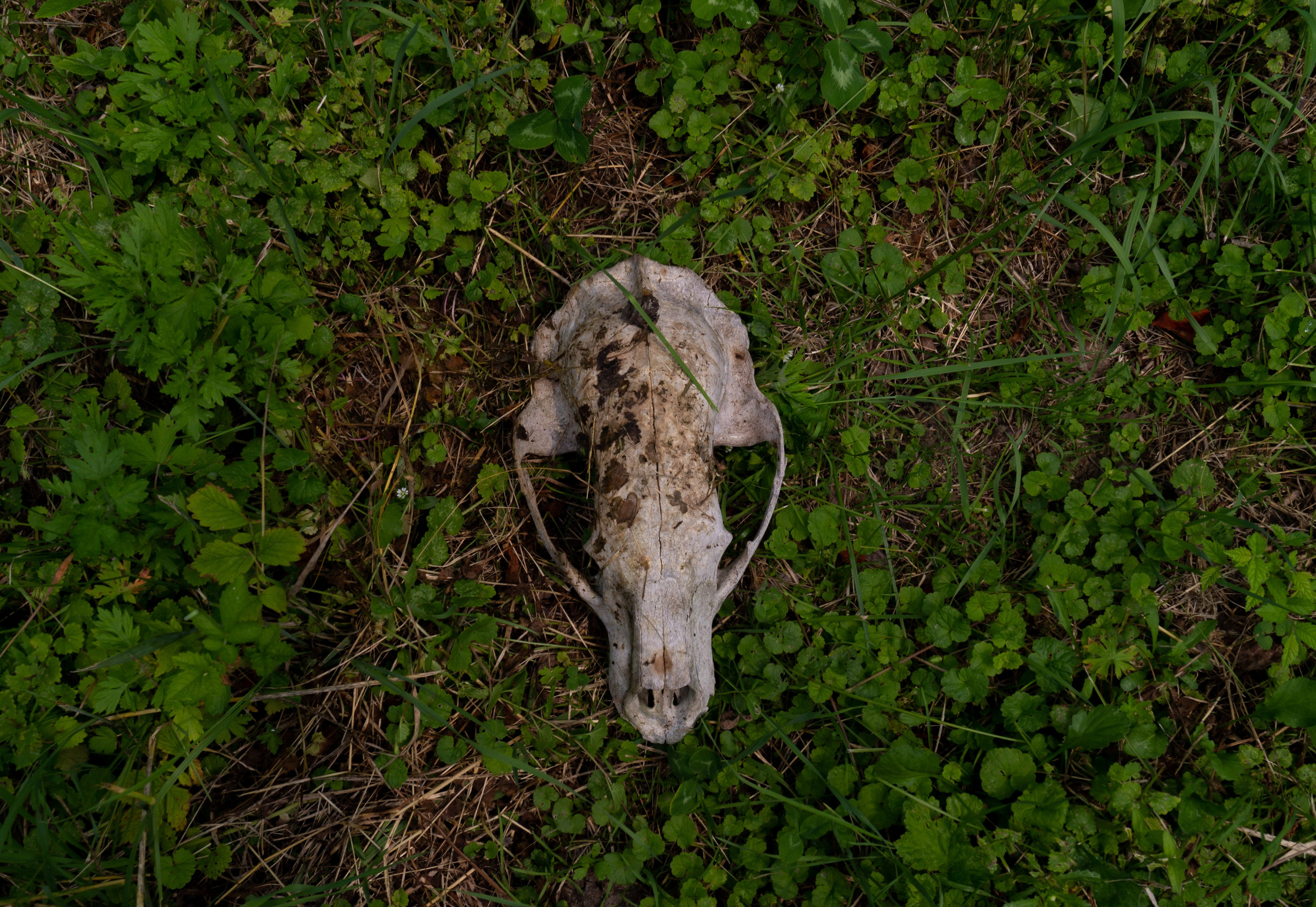
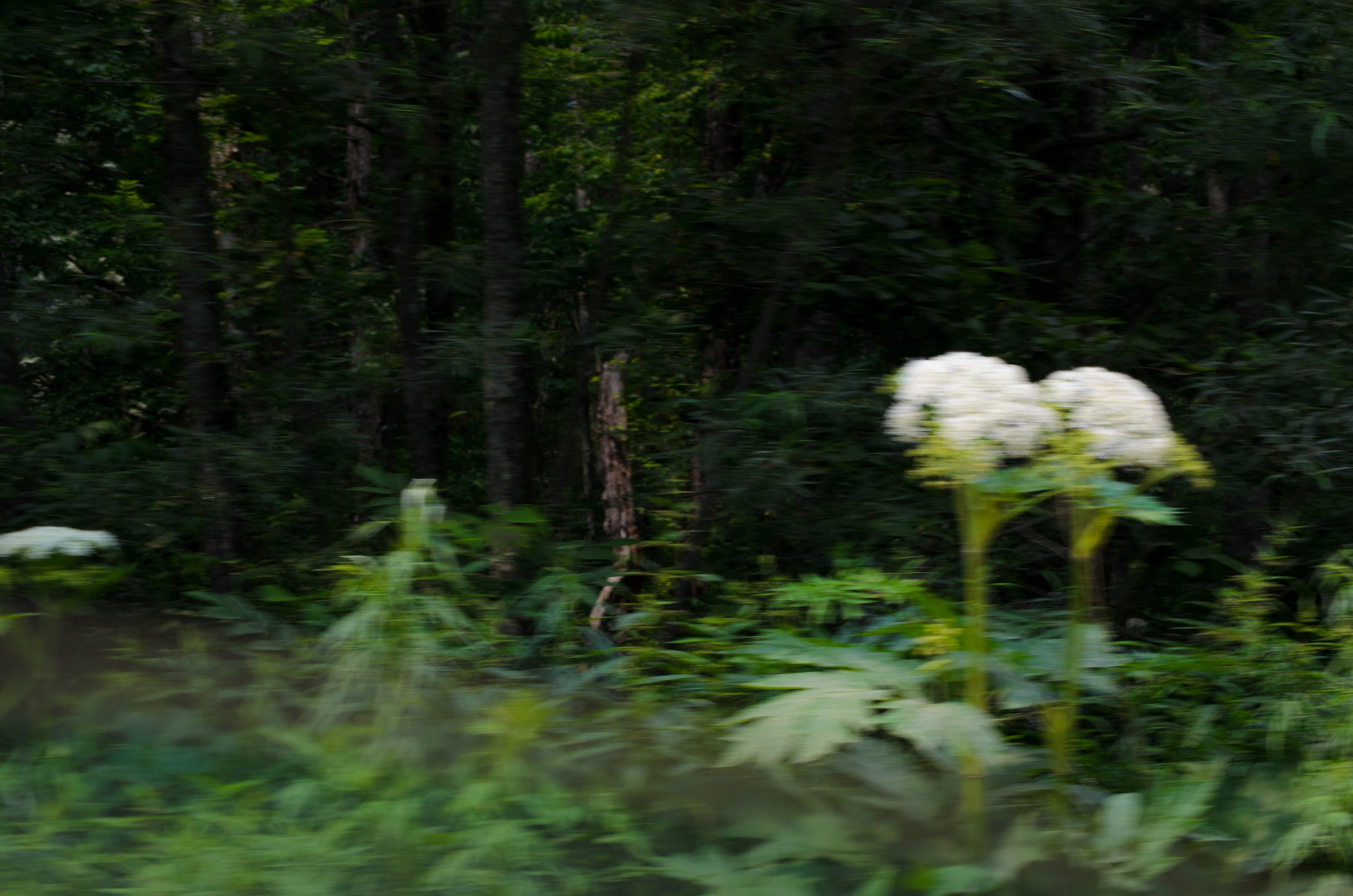
Here, Nelly Ilyinichna’s notes are used, which she has been collecting for many years to preserve the memory of her family and pass it on to her daughter and granddaughter.
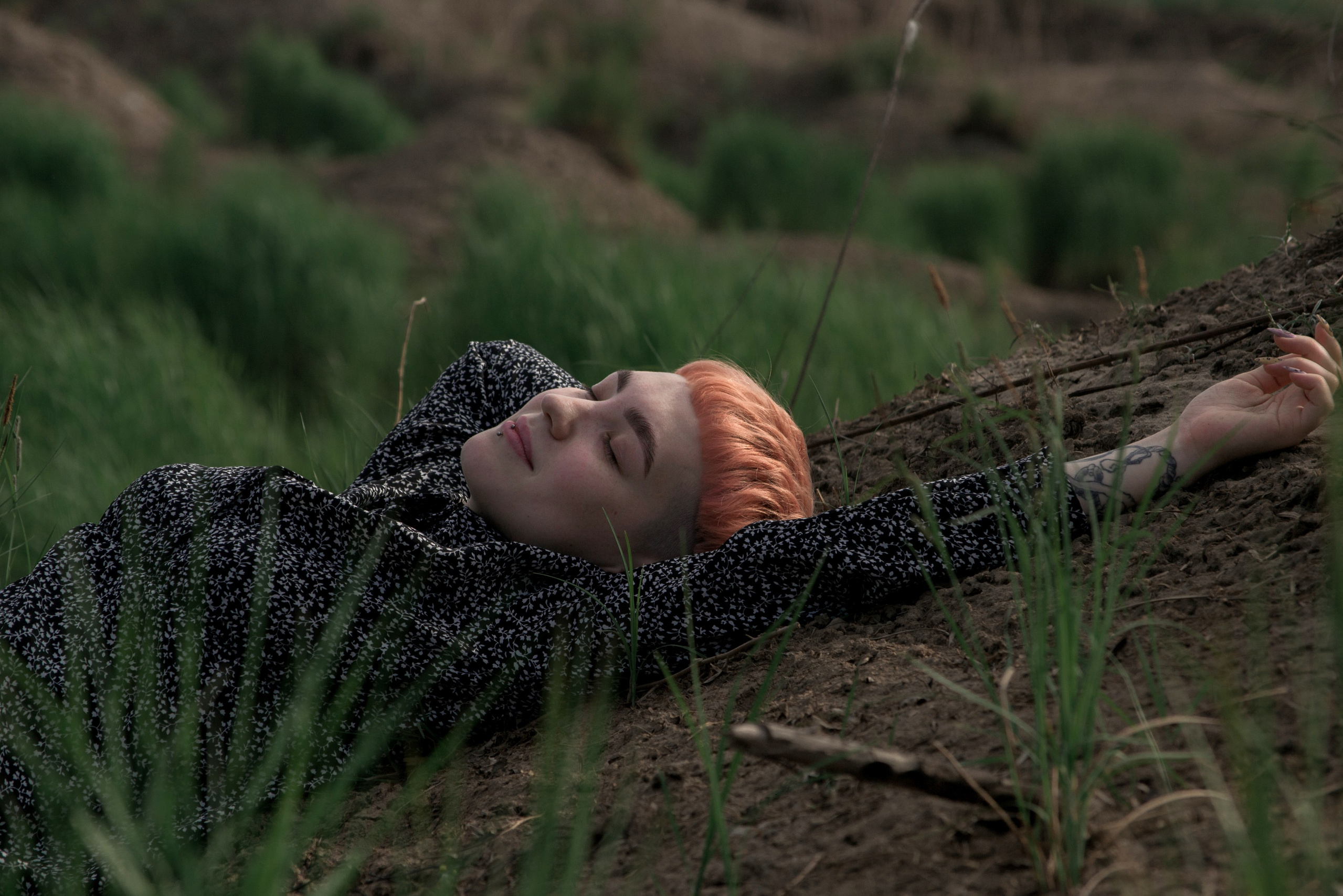
I was incredibly interested.
Darya’s Udege stories. Her friend gladly shared everything her grandmother had passed on to her. I wanted to go to the “capital of the Udege, ” as Dasha’s grandmother called Gvasyugi. I wanted to talk to Nelly Ilyinichna and see how modern Udege people live now.
I was lucky that Nelly Ilyinichna gave me permission to come, because she doesn’t really like such curious guests. Reporters had come to Gvasyugi many times, “they didn’t even give a single photograph back, ” Dasha’s grandmother used to say. I’m still afraid of not living up to the trust of a descendant of an ancient clan.
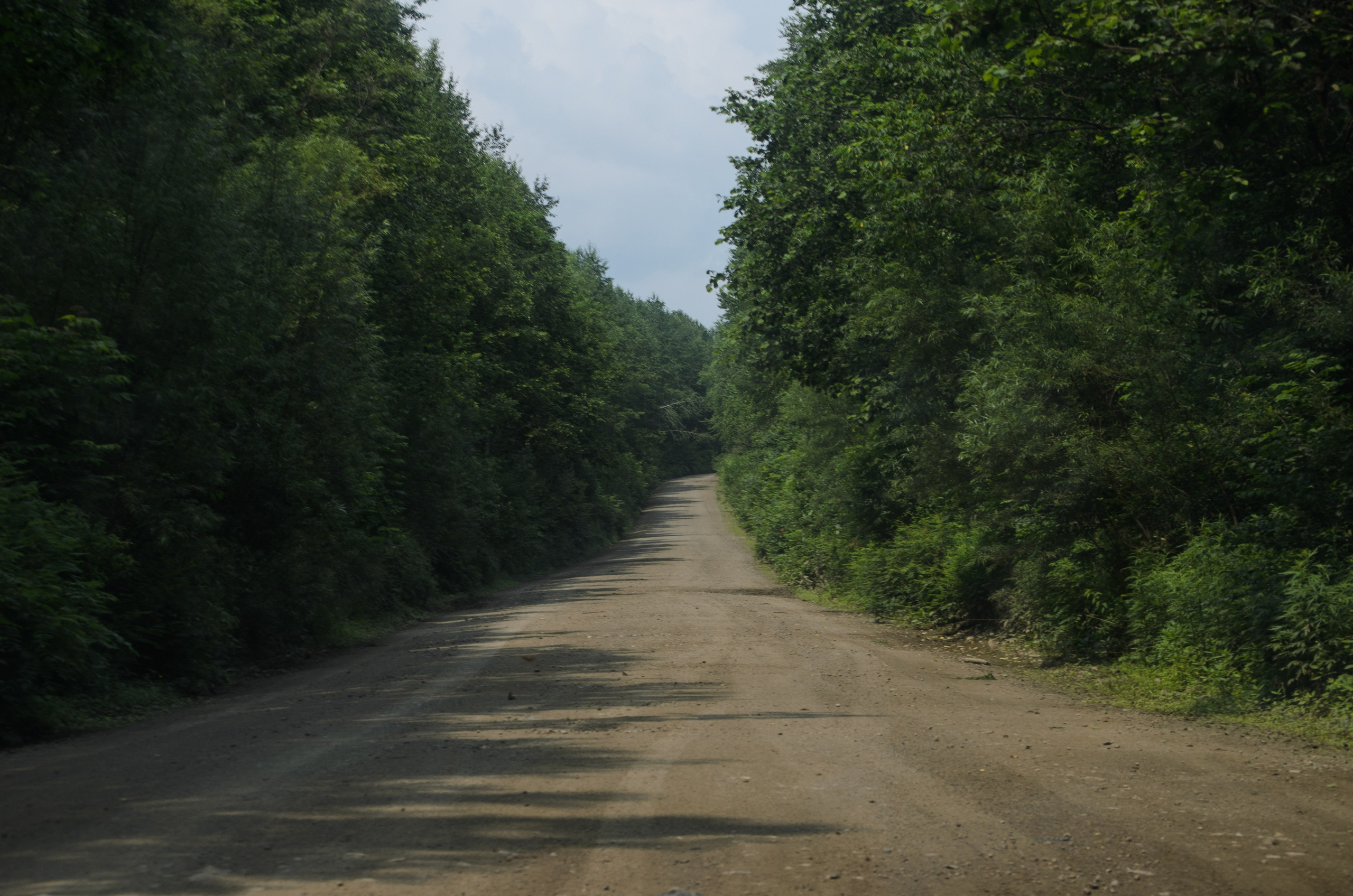
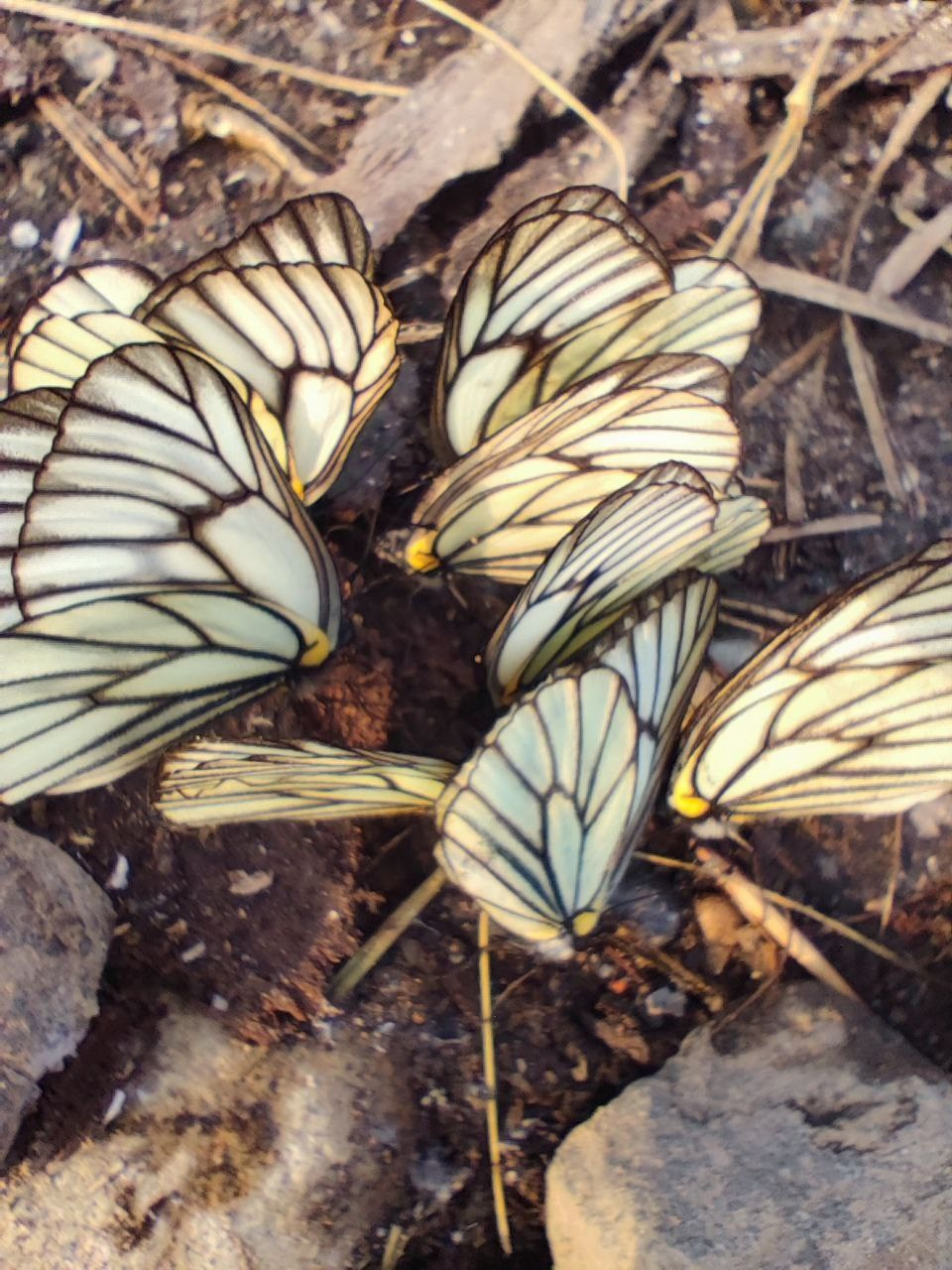
The Butterfly Road
That’s what I mentally called the route to Gvasyugi. Although, the road is so dusty that the residents of Gvasyugi, as soon as they reach its earthen part, change into robes and put on headscarves to avoid arriving after 52 kilometers completely covered in dust.
Cars drove past us, the color of which couldn’t even be determined due to the dust. We arrived at our destination, looking like travelers who had been caught in a sandstorm. Even on my eyelashes, the dust settled like fanciful mascara. The road is washed away by the river during the flood period, and you can often see fallen trees on the road.
The locals saw them and dragged them to the side of the road. Huge logging trucks rush towards us like dragons, raising clouds of dust and swaying their sides on the bumpy road. And with all this, after the rain, the road is covered with butterflies: swallowtails, cabbage whites, peacock eyes.
“These aren’t even the butterflies, ” says Nelly Ilyinichna in a teacher’s voice. I can’t even imagine that there used to be more butterflies and they were bigger — for me, this phenomenon already looks like something magical.
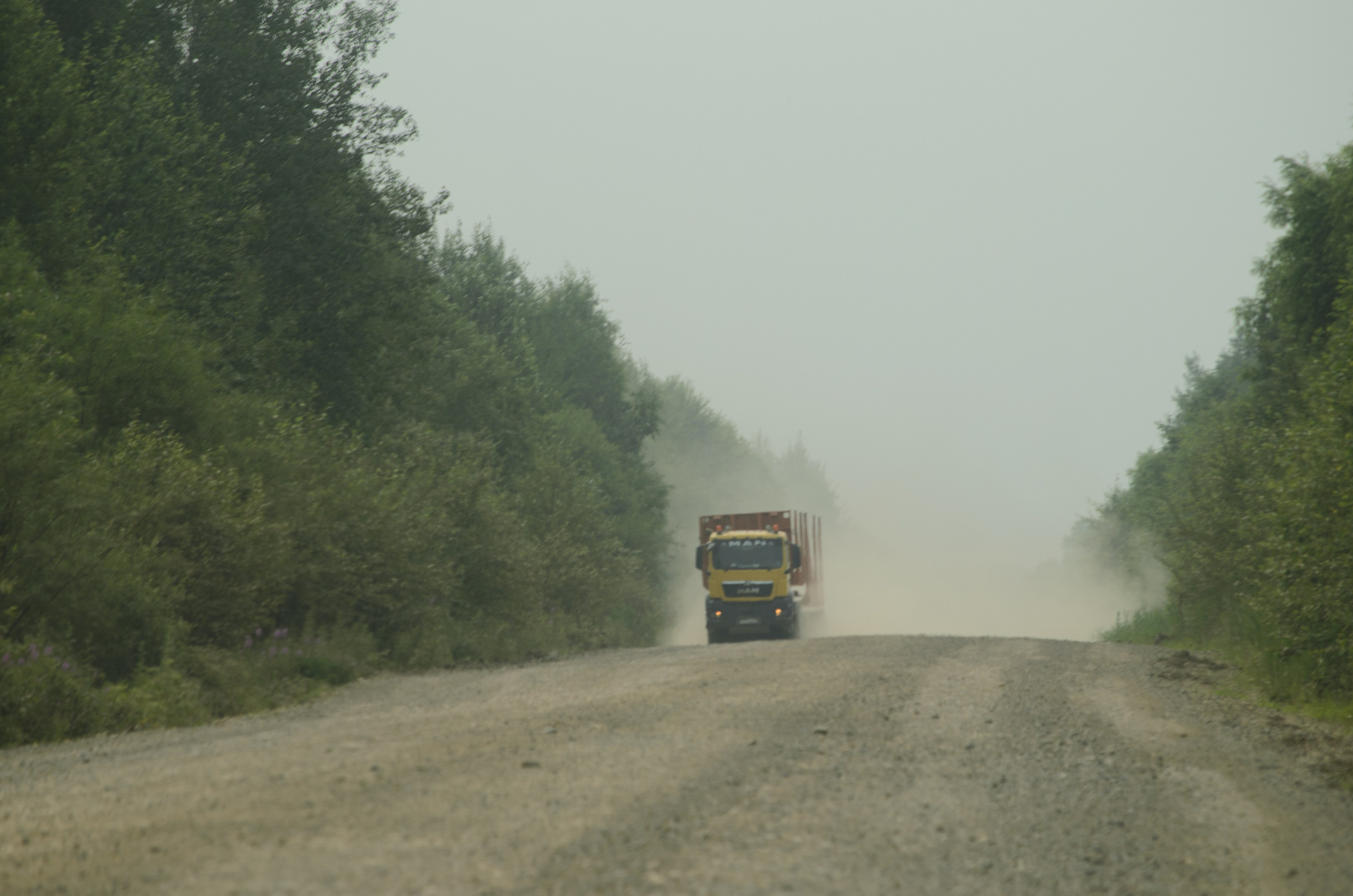
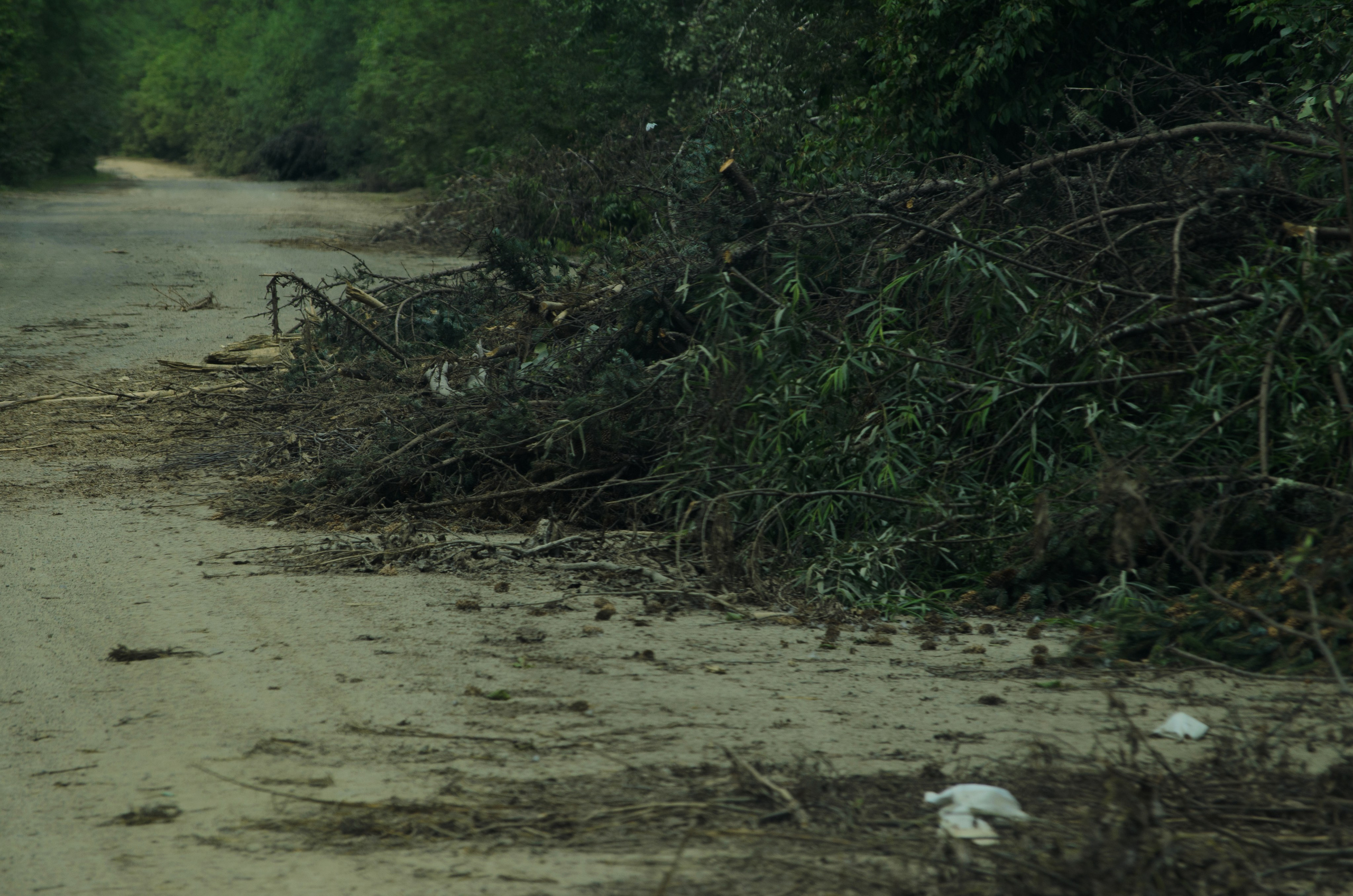

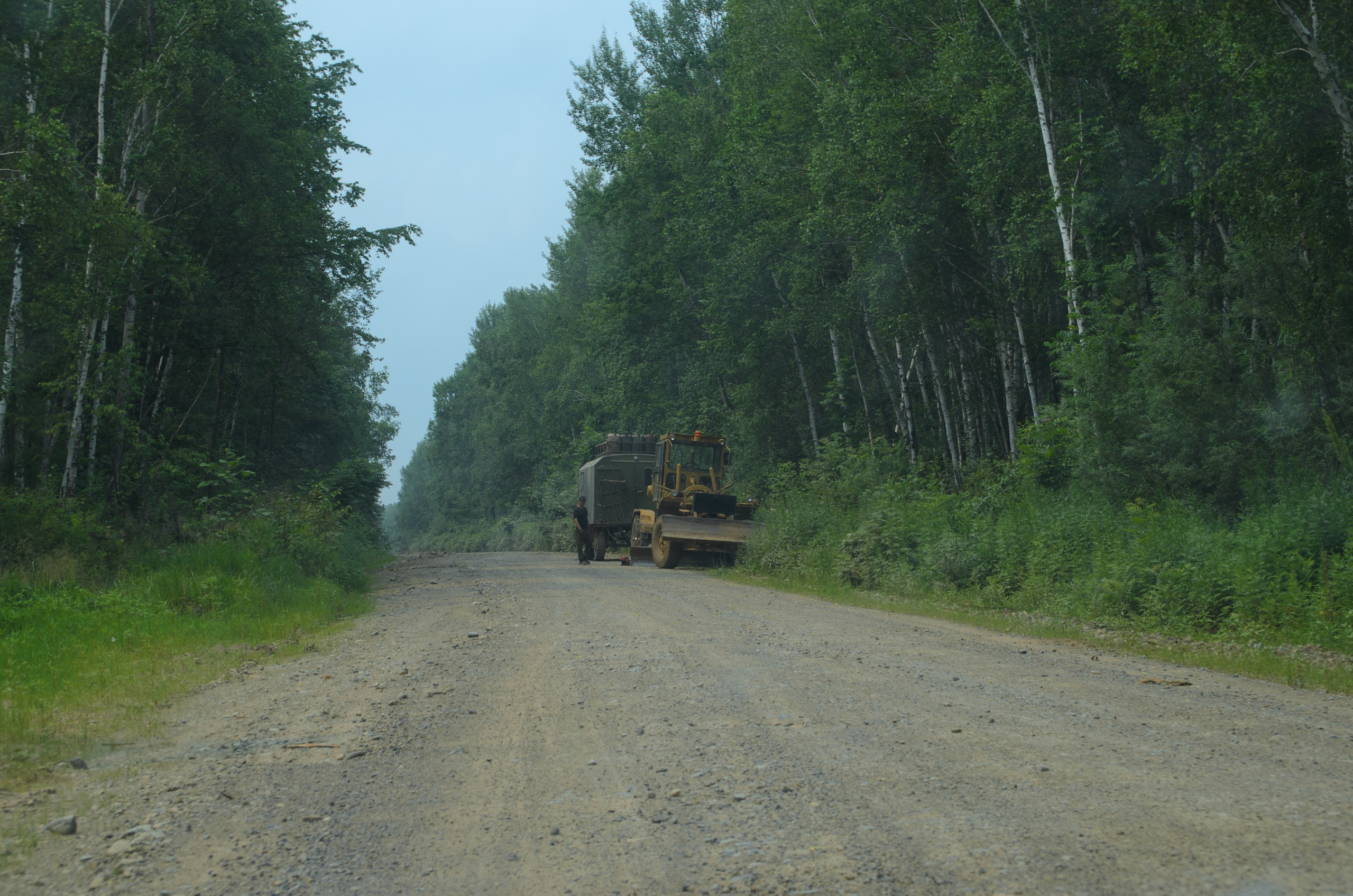
A road story
We picked up Dasha’s grandmothers early in the morning. They had been staying at their daughter’s in Khabarovsk.
Two sprightly, tanned women emerged from the house, got into the car, and after introductions, the stories began, which Nelly Ilyinichna would tell me for my entire stay in Gvasyugi.
In fact, Nelly and Larisa’s patronymics were given by the Soviet Union, just like their passports. Their father’s name was Ilma. “I think that if young people now started giving their children Udege names, it would become fashionable, ” Nelly Ilyinichna observes. The names are indeed very beautiful: Ilma, Kansi, Dzhanzi, Udzulya, Yarba, Dimalin (here a nasal “n”), Yegadya.
Udege is also a beautiful language. Even rabbit droppings sound beautiful — tuksa amani. We laugh, discussing many things. And I am amazed at how beautiful Nelly Ilyinichna and Larisa Ilyinichna speak.
(The photo shows a grader that was supposed to level the road but broke down. I felt sorry for the driver, although, judging by the cabin he was pulling with the grader, the man was ready for “life’s ups and downs”.)
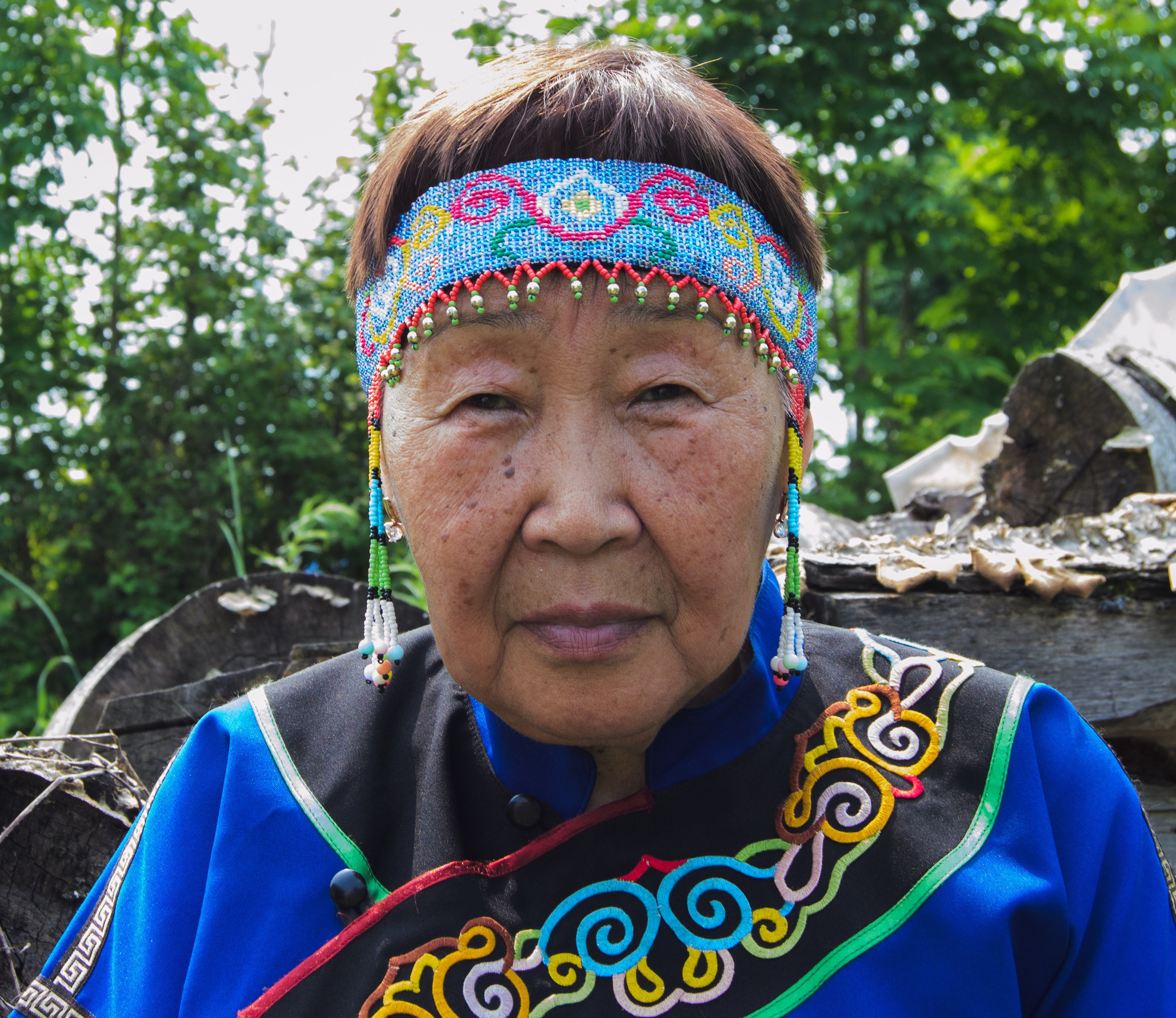
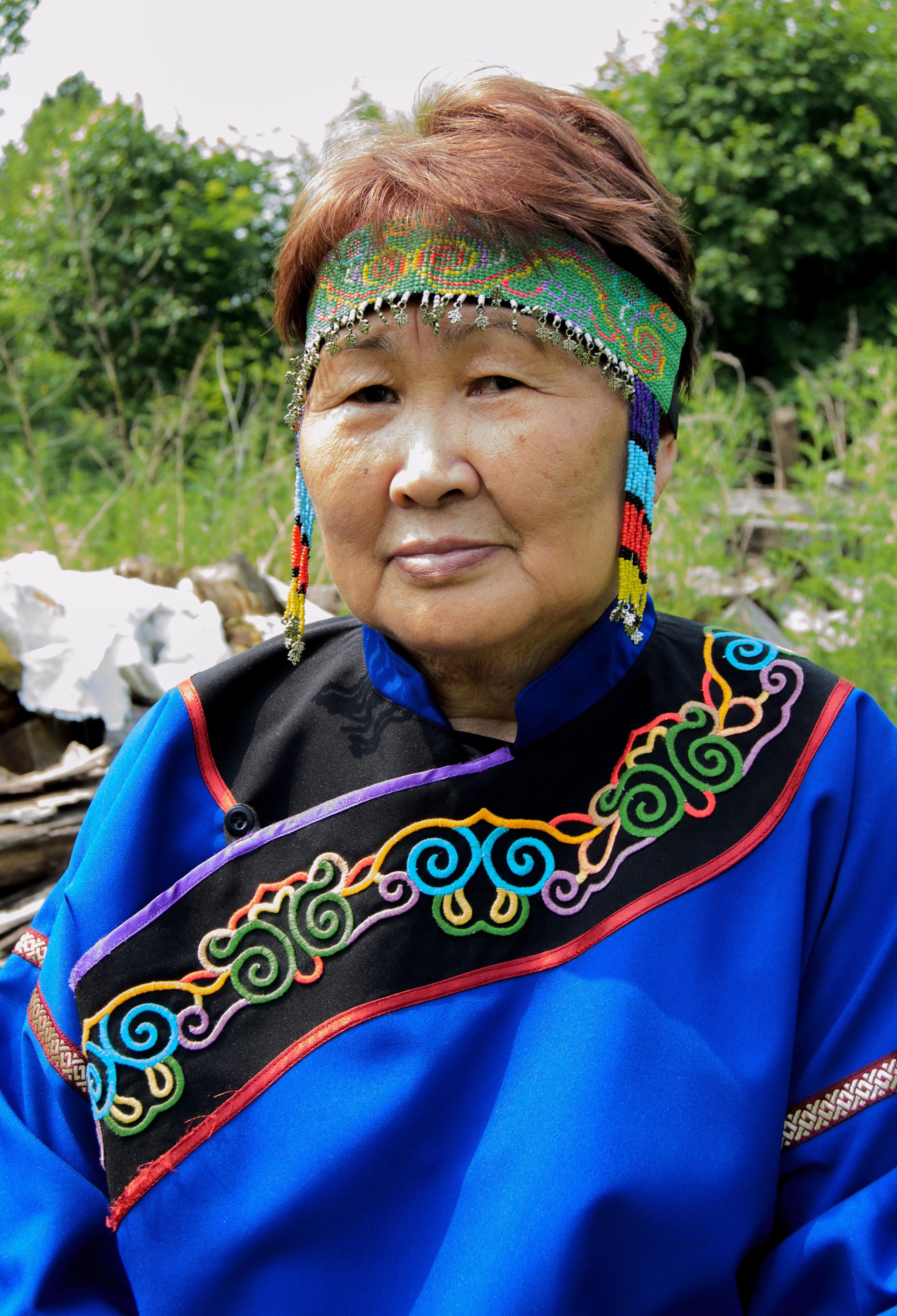
Left, Nelli Ilyinichna, right, Larisa Ilyinichna, in national dresses, made in the style of a robe and decorated with Udege ornaments embroidered with satin stitch.
Nelli Ilyinichna is a primary school and native language (Udege) teacher, Larisa Ilyinichna is a Russian language and literature teacher.
“She, my sister Lora, graduated from Herzen University in St. Petersburg, ” Nelli Ilyinichna proudly announces.
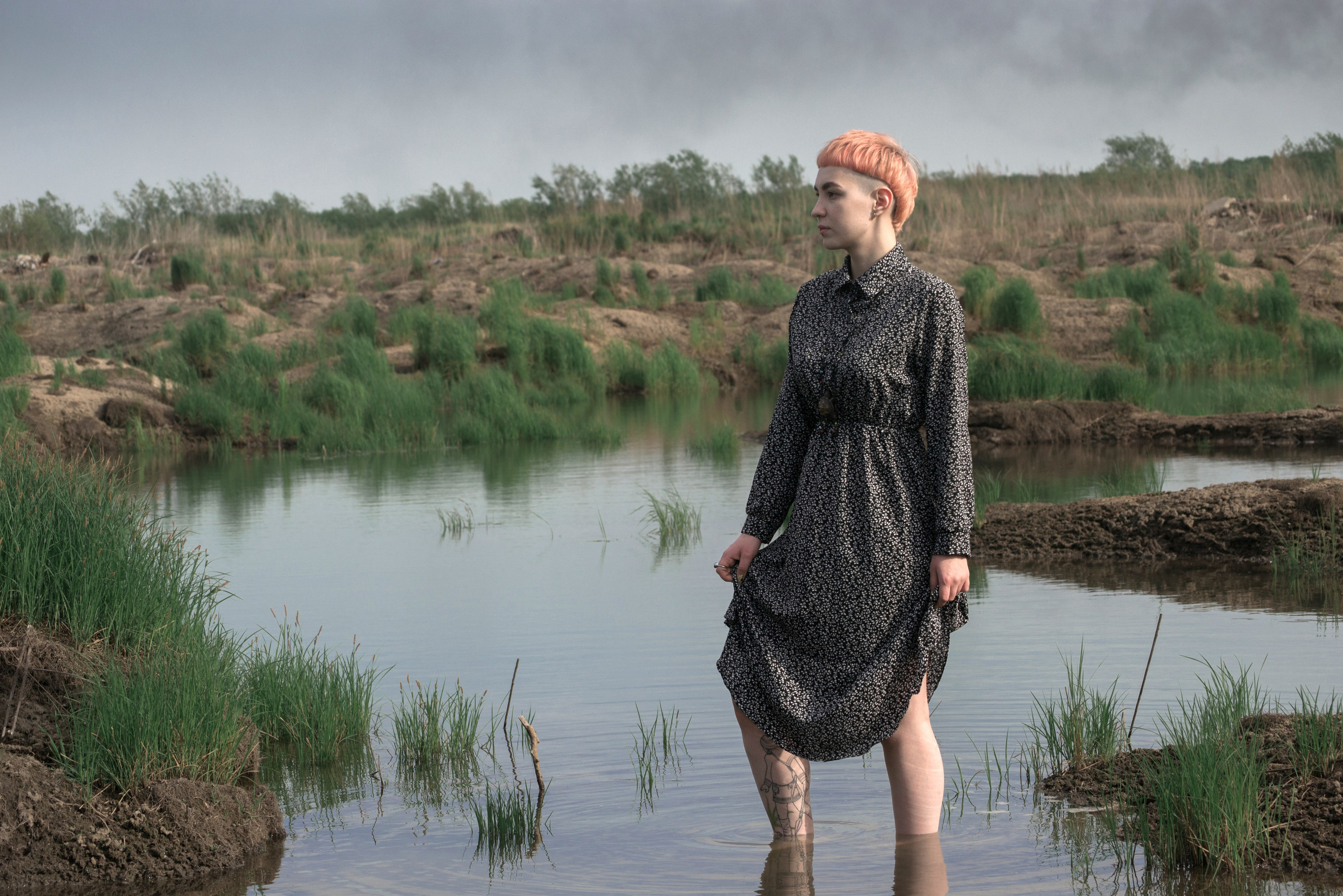
Listening to the speech of the two Udege women, I understand all of Darya’s pride. I understand why Dasha herself writes and reads a lot. This amazing and close bond between the women of one family evokes envy (in a good way).
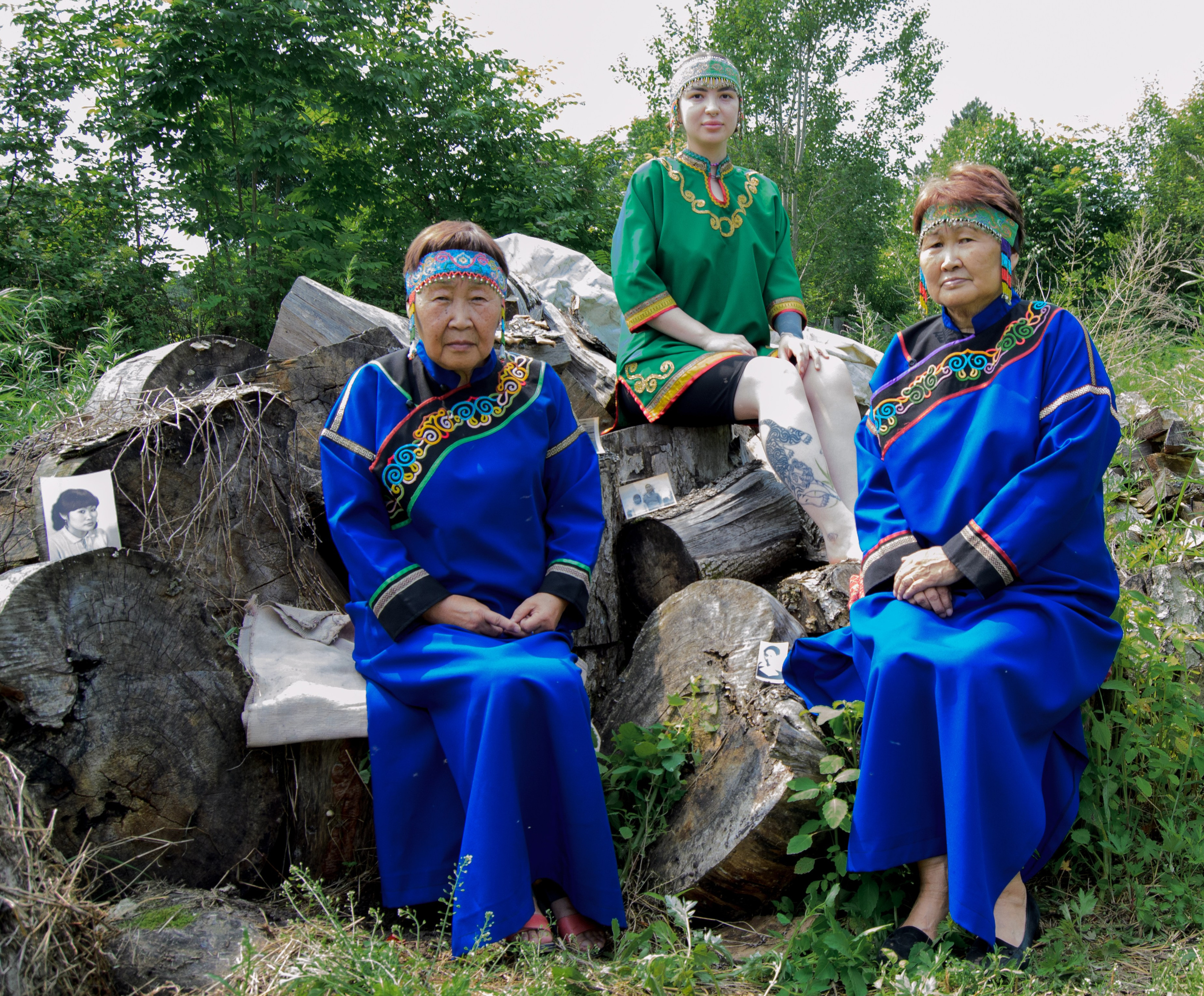
link
Perhaps this female solidarity and connection is dictated by the long history of the Udege people. A woman in the Udege community meant as little as she meant universally much. The hard life of Udege women may have brought female members of the clan closer within the family and community.
from the book “Where Sukpay Runs” by Jansi Kimonko
“— You were born in winter, ” the grandmother began, puffing on her long pipe. “Your hunting shelter was made of fir branches. Three days before you came into the world, your mother went off just like this, into a hut. I brought her some flatcakes and fish, gathered dry fallen branches, lit a fire, and left her alone. It was cold in the forest. At that time of year, the trees crackled with frost, and blizzards swept through. An old fir tree was rustling right above the hut.
I remember barely managing to trample a path to your 'catch'. I brought flour for the flatcakes. It was sinful to enter the hut. Forbidden. I poked a small bag of flour through the door and heard you cry. I quietly asked your mother: who was born? She said: 'Bata! ' 'Well, now we have another provider, ' I thought. And the cold was terrible.”
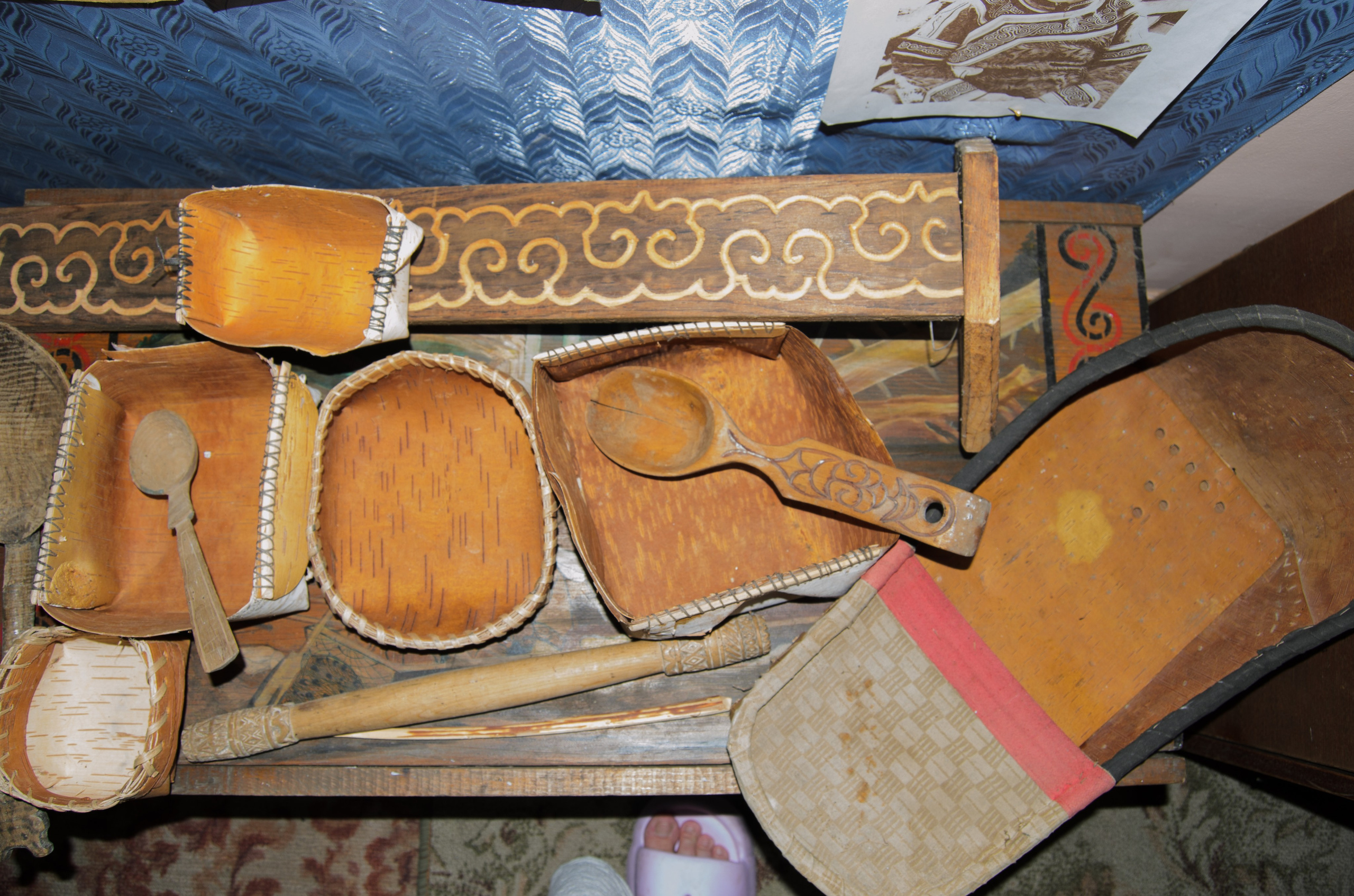
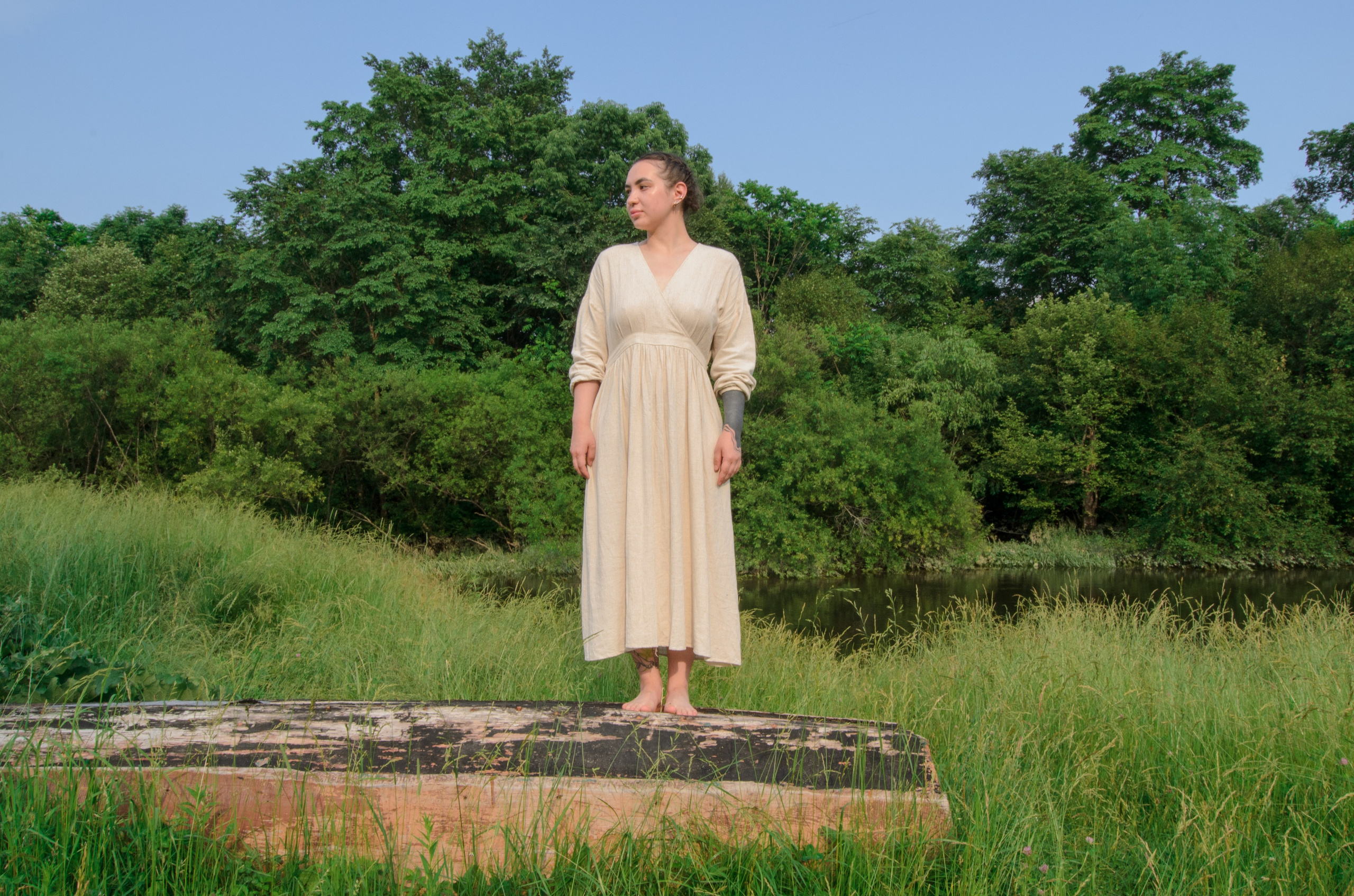
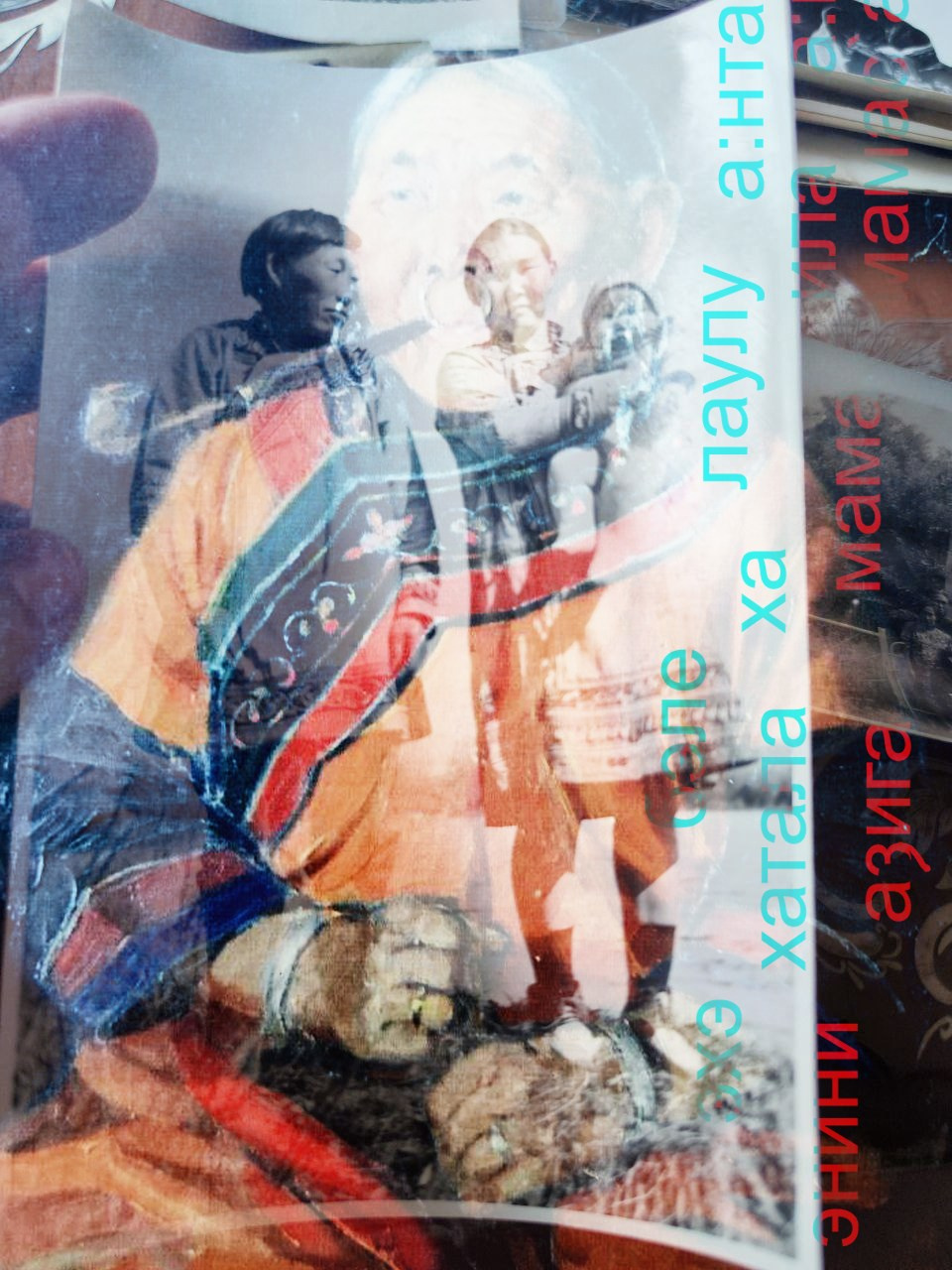
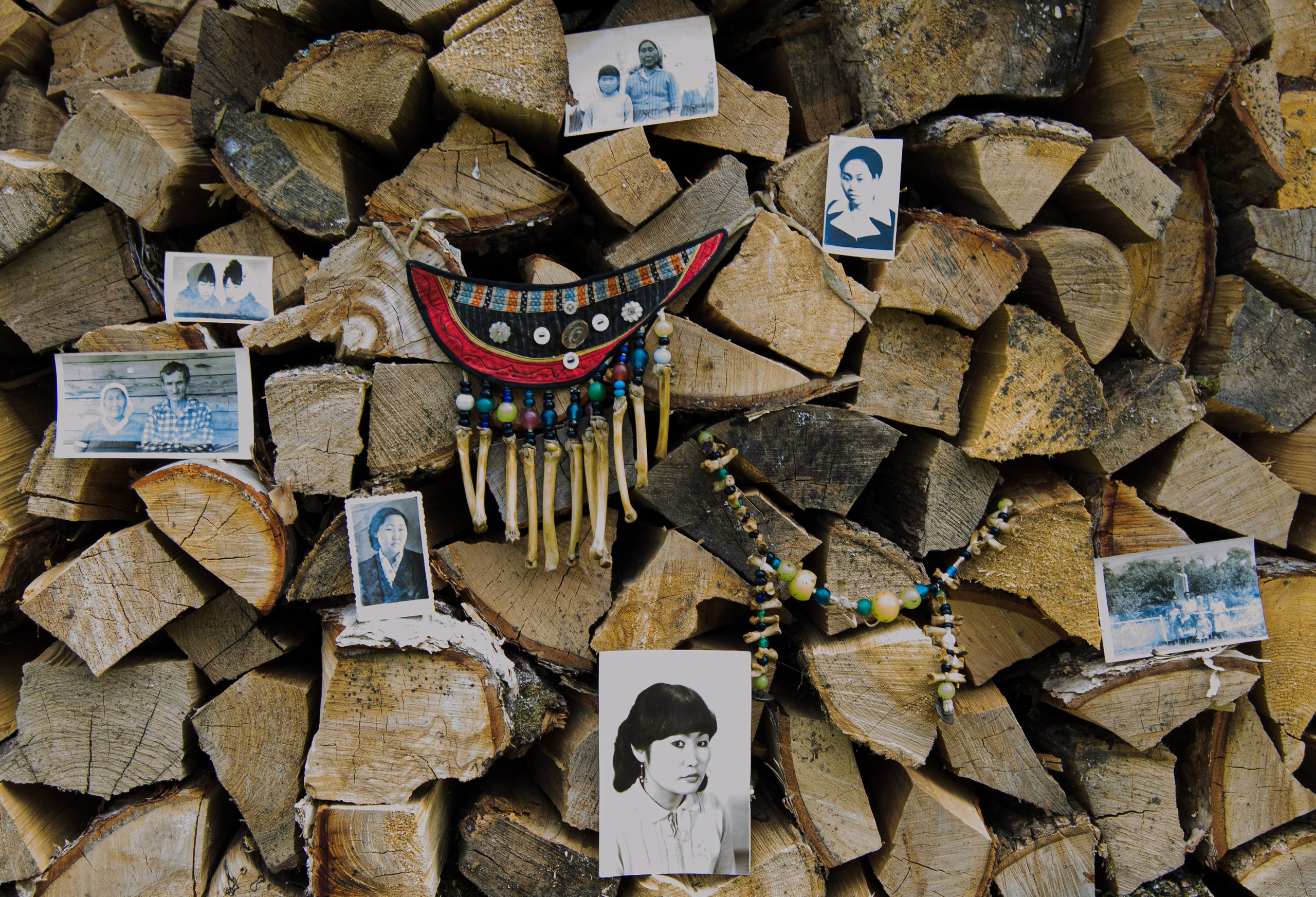
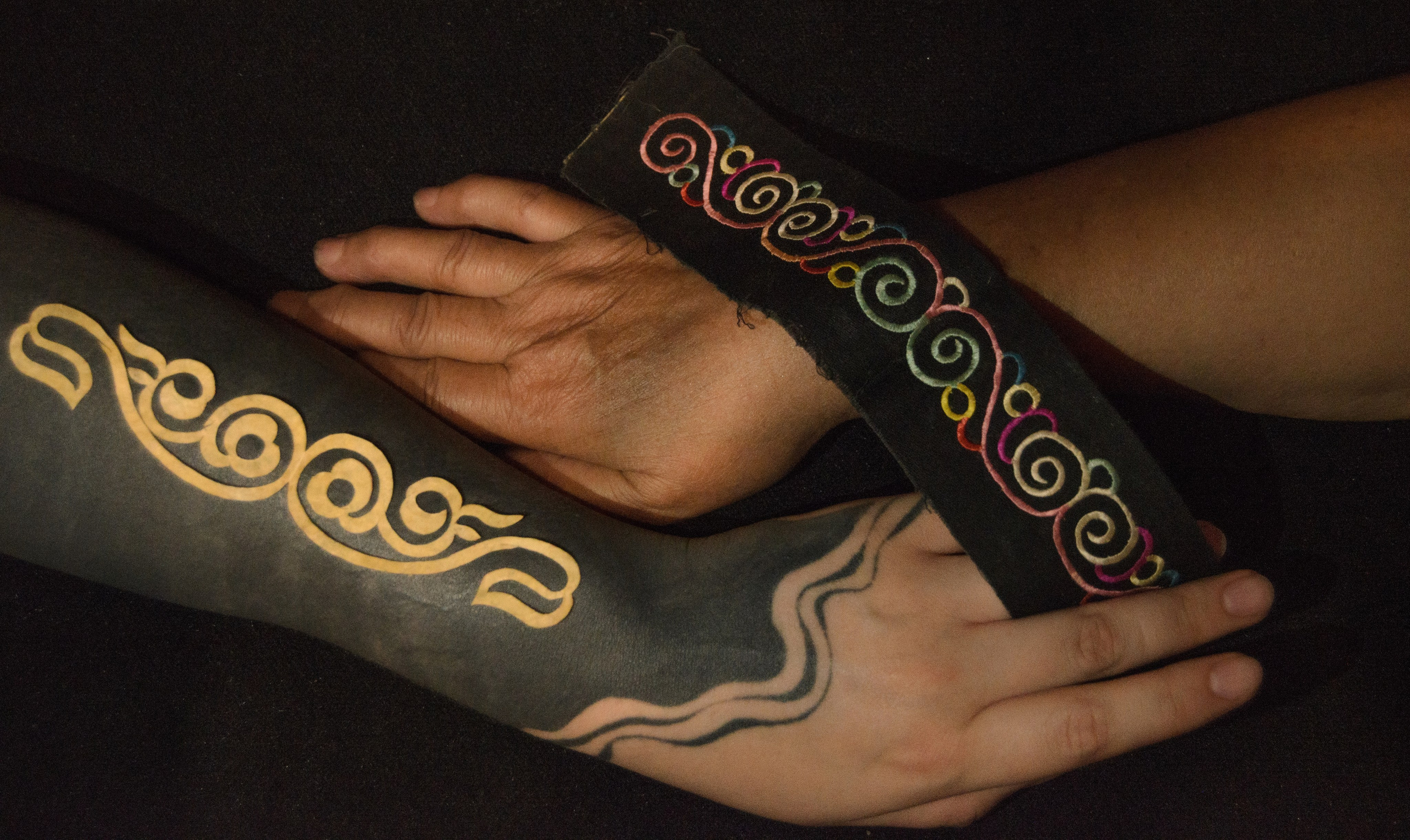
I thought about it for a long time, I imagined
The life of an Udege woman. Harsh taiga, hard living. How she gave birth alone, how she nursed her infant. How many died in childbirth, never giving birth…
“Someday, ask your mother how she kept you warm on those freezing nights. You were shivering with cold, crying. Your mother would take you on her lap, wrap you in the hem of her robe, press you to her chest. She would breathe on your blue hands and was afraid of only one thing, that the fire would go out. Tears flowed from her eyes day and night, but looking at you, she smiled and talked to you as if you were grown up. The elm rot gave little warmth. Your mother would hold out her feet, then her hands, to the fire, turning from side to side. She prepared her own food. It was sinful to cook for a woman in labor. So that’s how she ‘hunted’ with you for fifteen days and nights. She lived in a hut, with one tattered chintz robe and one robe made of fish skin. One side would freeze, she’d turn that side to the fire, the other side would freeze, she’d turn the other side to the fire. It was cold. But she held you in her arms and rejoiced that you had come into the world” (from Kimonko’s “Where the Sukpay Runs”).
Udege women were married off cruelly as well. It was good if the husband turned out to be a good one. A young girl, of marriageable age, was secluded in a hut, and they waited to see what kind of husband would come to her, whether he would stay in the hut.
Nelly Ilyinichna thanked the Soviet government for giving her education and work. Nelly Ilyinichna’s family lived a hard life. An extra mouth to feed, the mother wanted to give her grown-up daughter in marriage. But her character and the times saved her from an early and unnecessary marriage. Young Nelly stamped her foot, refusing to continue the tradition. She got an education, became a teacher. I thought, could I have done the same? To stamp my foot, to refuse, to go my own way.
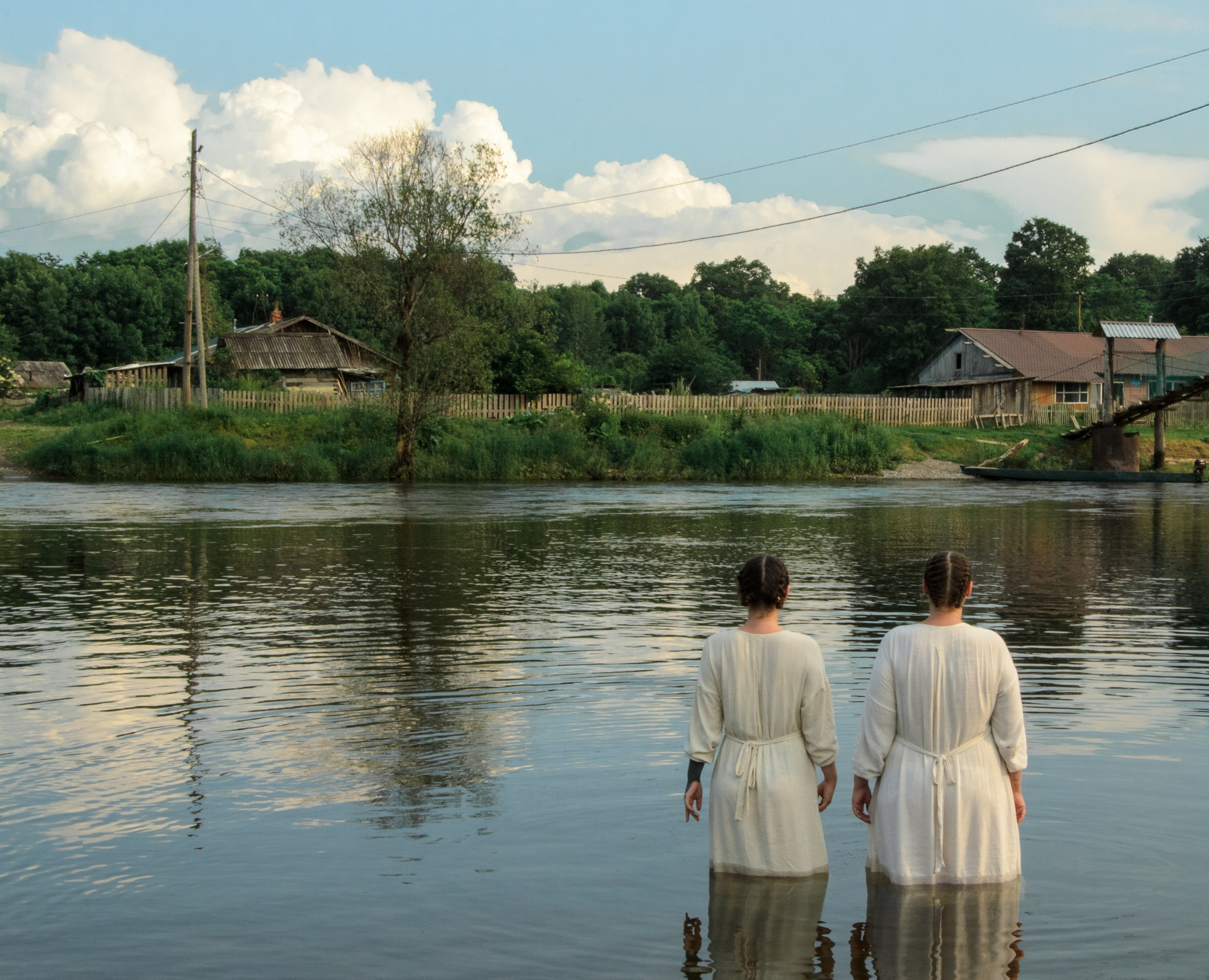
Сhildren
The children grew up alongside the adults: boys accompanied their fathers on hunts and fishing trips, while girls helped their mothers. There was much work to be done. If a husband killed a moose or a bear, the wife would get into a boat and go to butcher the meat.
Can we now imagine the strength of these women? The children were also present when their parents moved through the taiga in search of a better place, in winter and summer. The strongest survived. Mother Nelli Ilyinichna remembered a flood and the family’s urgent preparations, how they floated in a boat through the taiga, which lapped its branches in the overflowing river. The sharp nose of the boat cut through the calm water and parted the branches.
She remembered how the plague came to the village and the family had to move to escape the plague, to save their children. How they lived with their parents in a boat during the flood. With the arrival of Soviet power, children were left in boarding schools. Was this good? I don’t know. It’s not for me to discuss this. They say that child mortality decreased. Fewer small bodies were buried in trees, as was customary among the Udege.
When I heard about the way children were buried, the question arose: “And what if a pregnant woman died?”. Nelli Ilyinichna replied that the child was “freed” and also buried in a tree. “But there is a story, ” the old Udege woman tells me, “there lived a woman who died pregnant. She is restless. Out of envy, she inflicts toxemia on pregnant women.” Of course, like all children all over the world, little Udege people played with toys.
Nelli Ilyinichna told with a smile how she cut a piece of bear skin, on which they slept in a hut, to make herself a doll. There were also wooden toys that her father carved. — And how did you wash the children in winter? — Not at all, Nelli Ilyinichna answered me. In winter, both adults and children smeared themselves with fat (hair, body) and waited for spring, when they could bathe in the river. Now Nelli Ilyinichna has a bathhouse, like everyone in Gvasiugi.

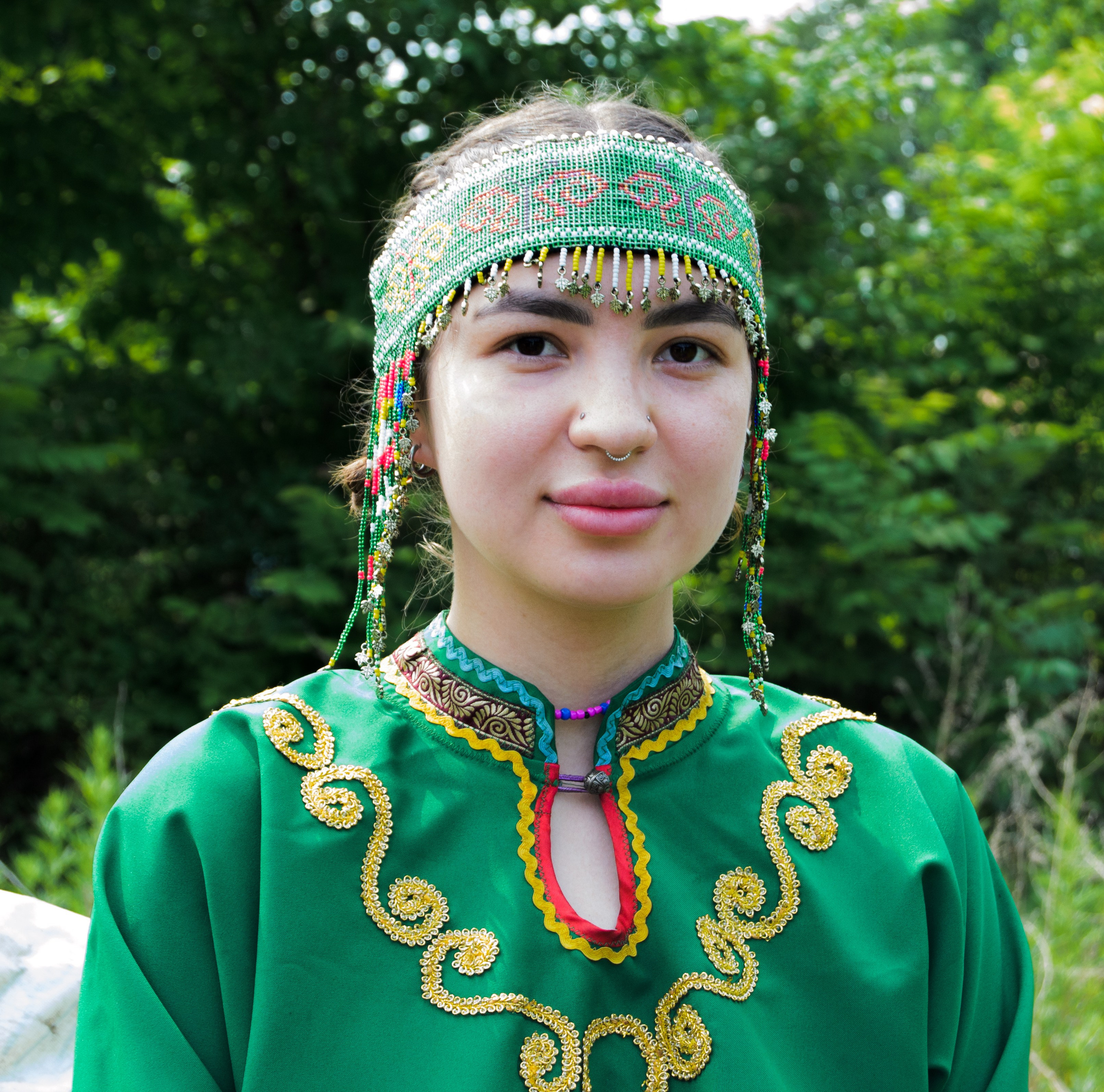
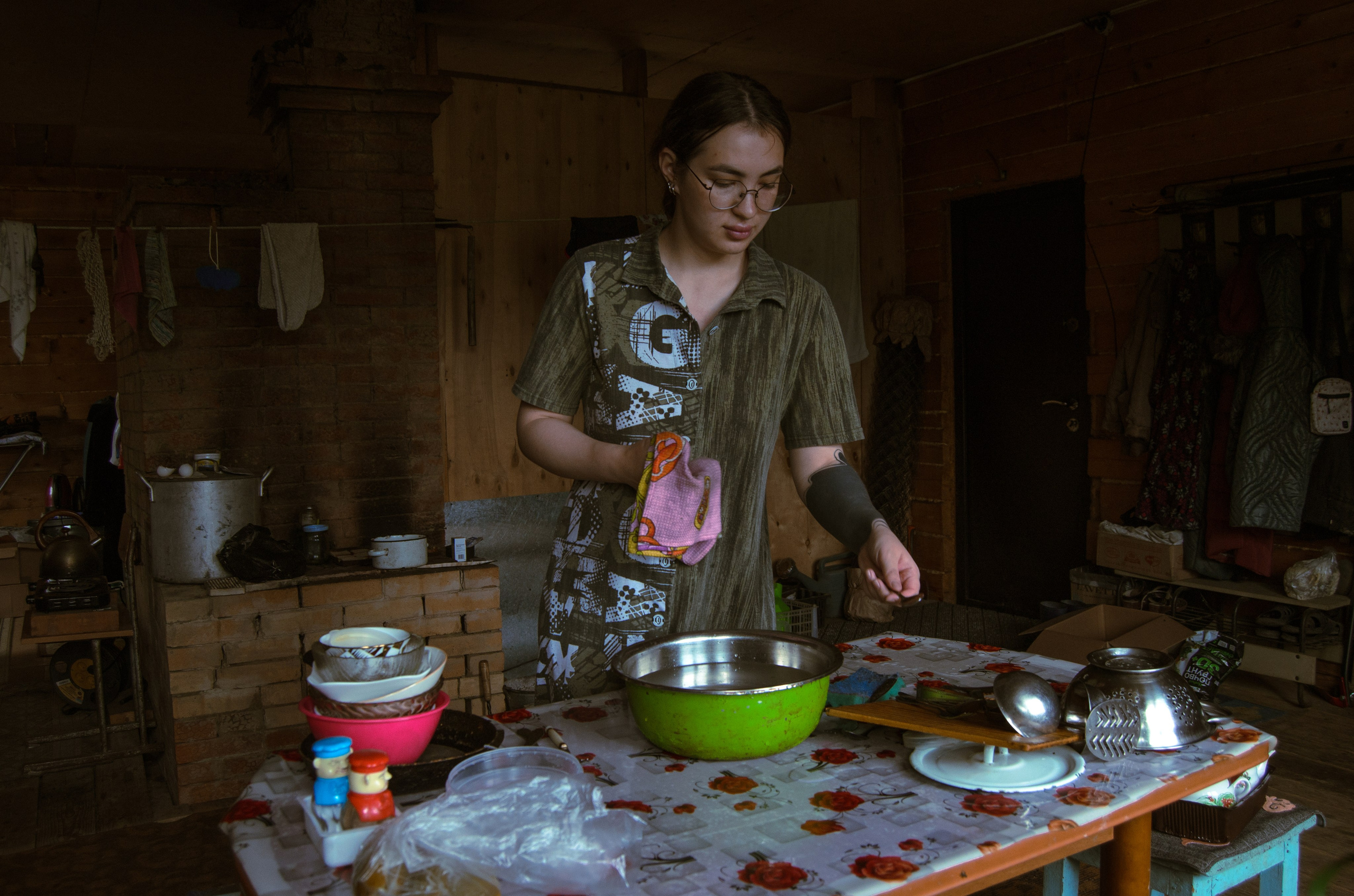
Parents passed down knowledge
To their children, everything they themselves knew, everything the taiga had taught them. Nelly Ilyinichna joked that in their family, knowledge was passed down from middle sister to middle sister. She, the middle daughter of Yegady, was initially not interested in the traditions of her ancestors, but her mother—a strong shaman—treated people with acupuncture and performed rituals when Nelly was small.
“The bog rosemary smokes, voices, sounds. It’s scary, ” Nelly Ilyinichna remembers. Over time, Nelly also became interested in the traditions and customs of her people. One might only think that the Udege are wild, without culture. But their heritage is vast: proverbs, sayings, fairy tales, songs, crafts, wood carving, embroidery…
Listening to the Udege language, I noticed a similarity to the Chinese language, which I am studying. Nelly Ilyinichna narrowed her eyes slyly, smiled. She said that it was not surprising—after all, the Udege not only traded with the Chinese, but also married them.
They were the ones who taught the Udege shamans to treat people with acupuncture. It was from them that the Udege got metal items, like the shaman’s mirror, which Nelly Ilyinichna inherited from her mother.
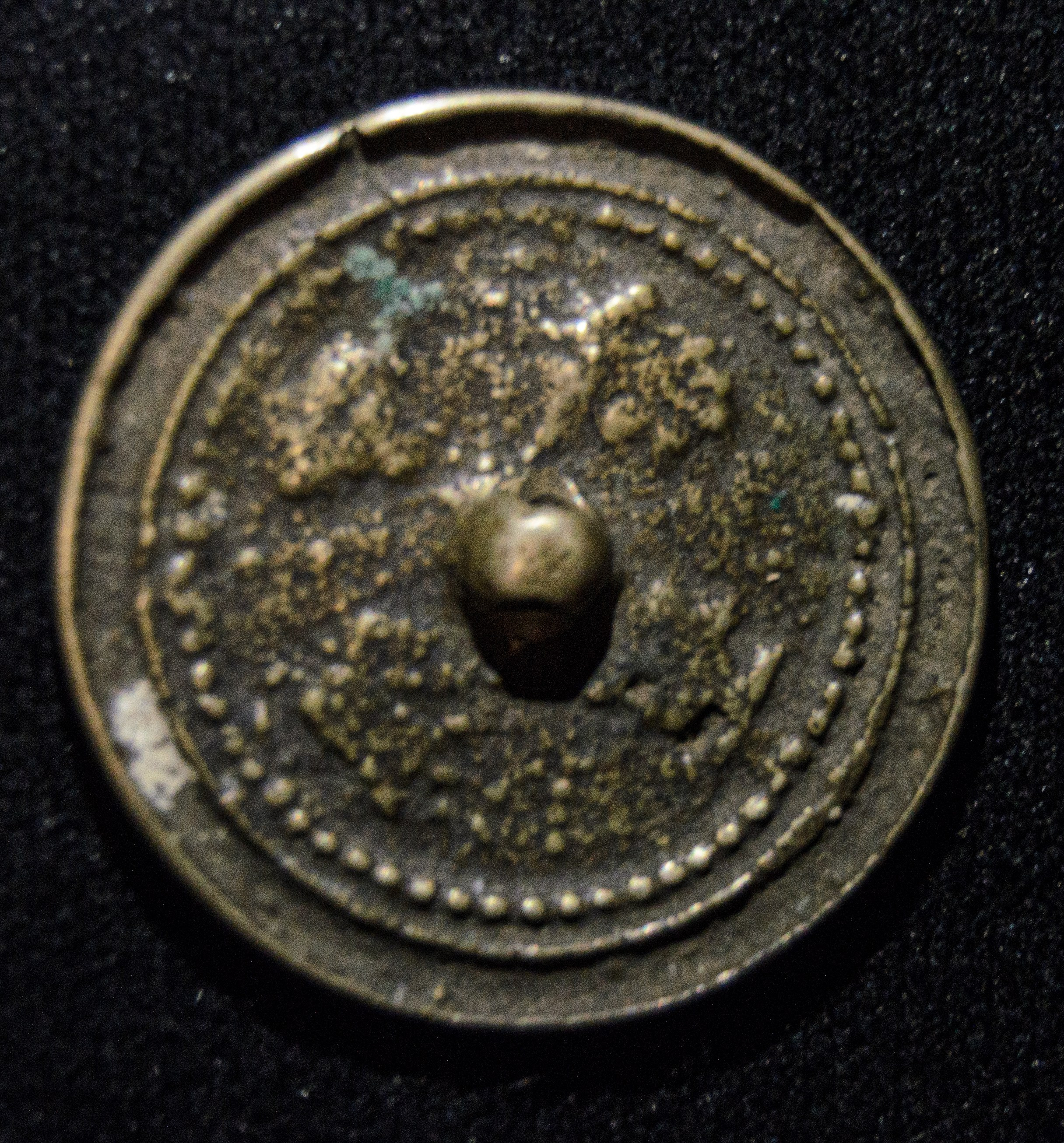
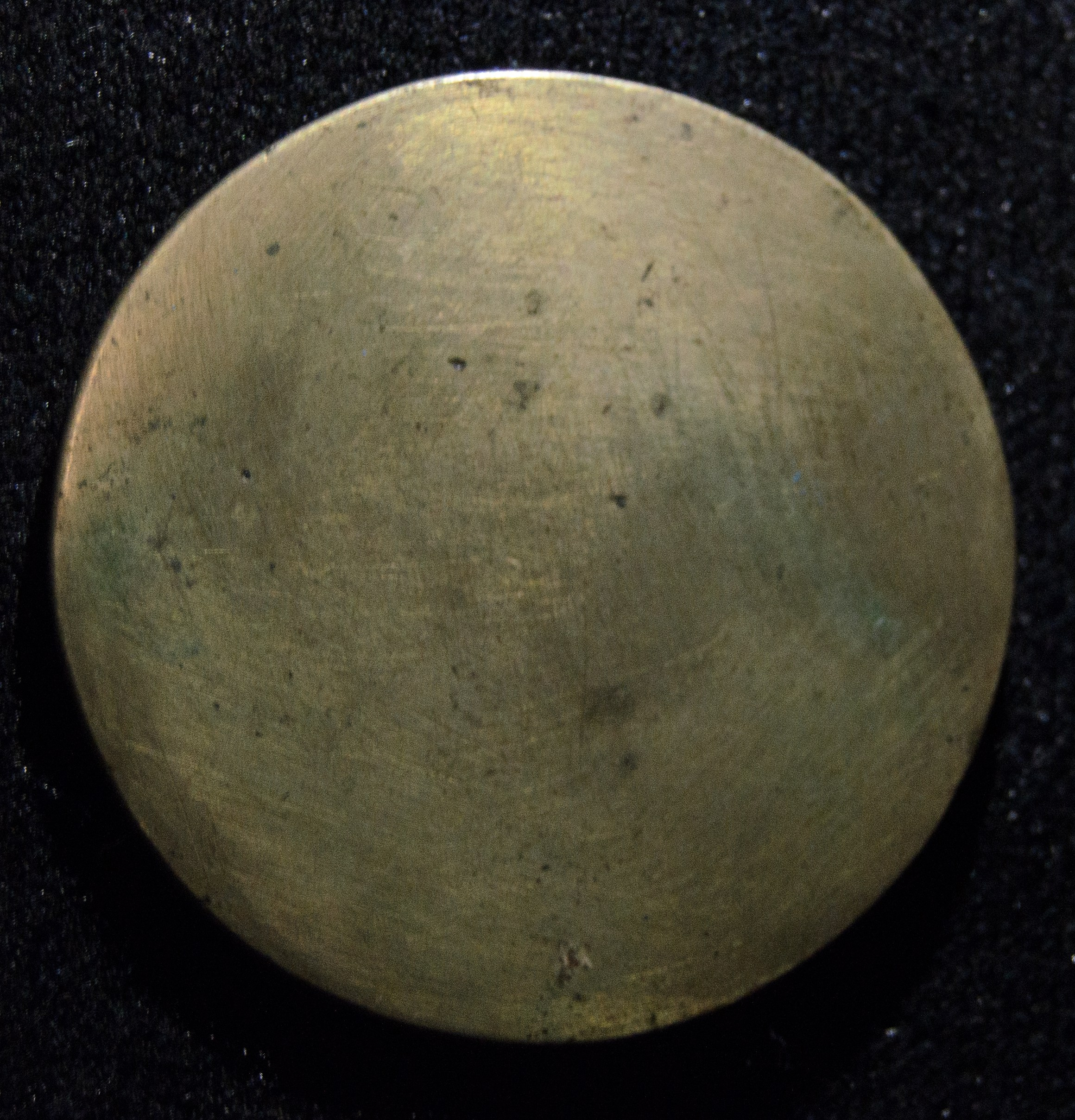
With bated breath
I heard about the shaman mother from Nelly Ilyinichna. A woman who raised children with her skills. People paid for rituals and healing with food and money, despite the fact that the Soviet government prohibited shamanism. Can you really erase from a woman what nature has given her?
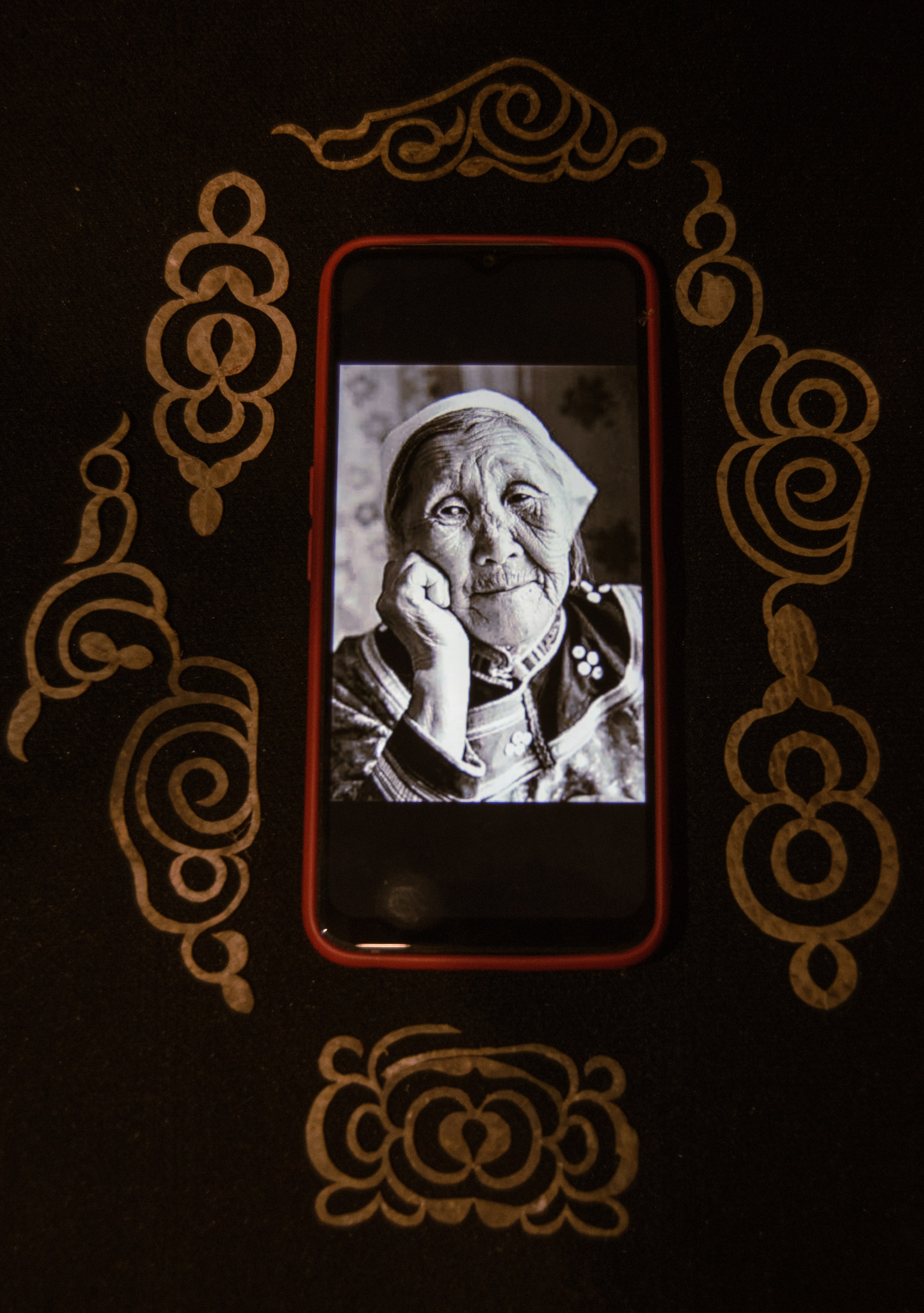
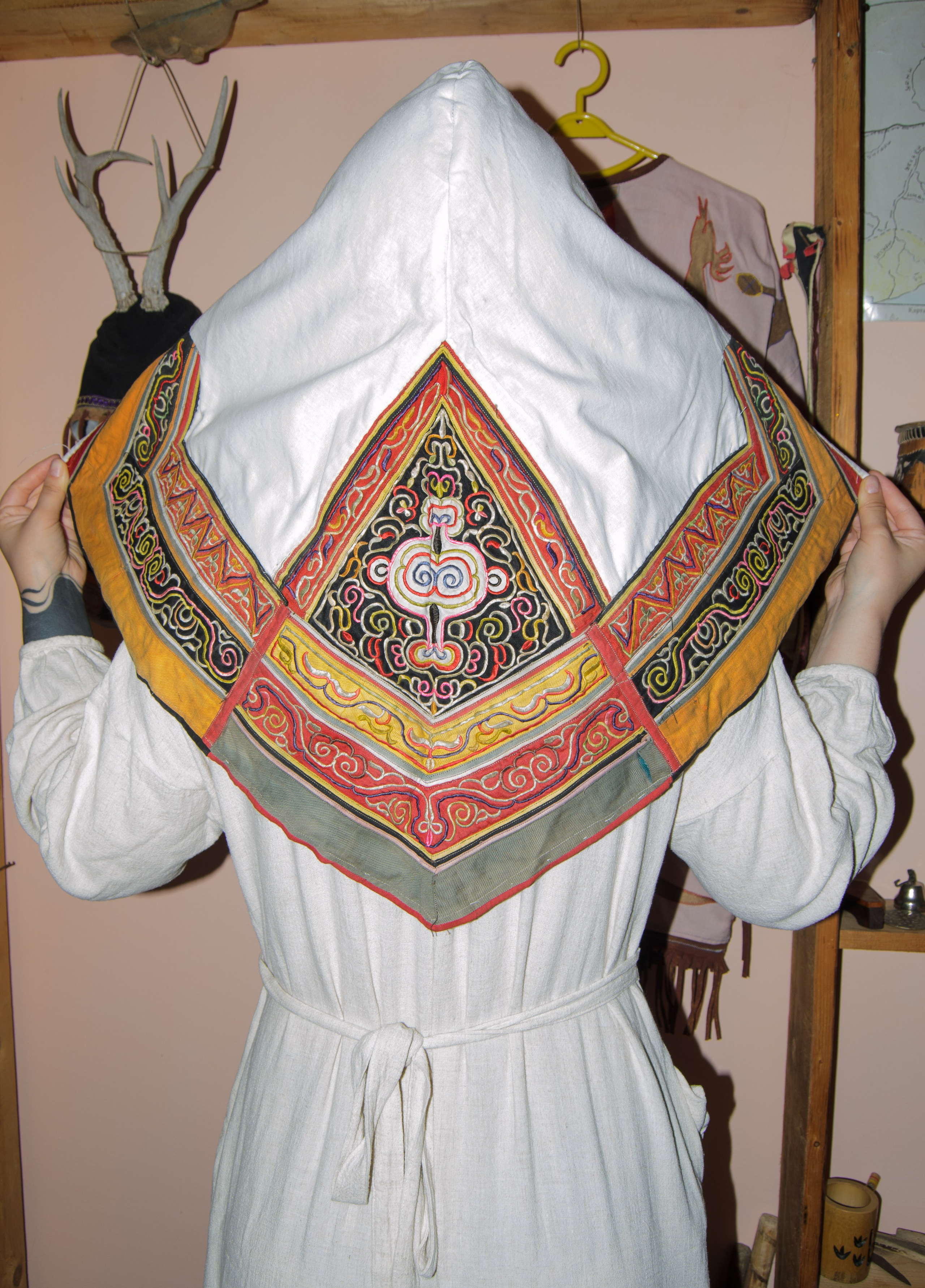
On the photo, left is Evdokiya (Yegadya), right is Dasha wearing a shaman’s headdress.
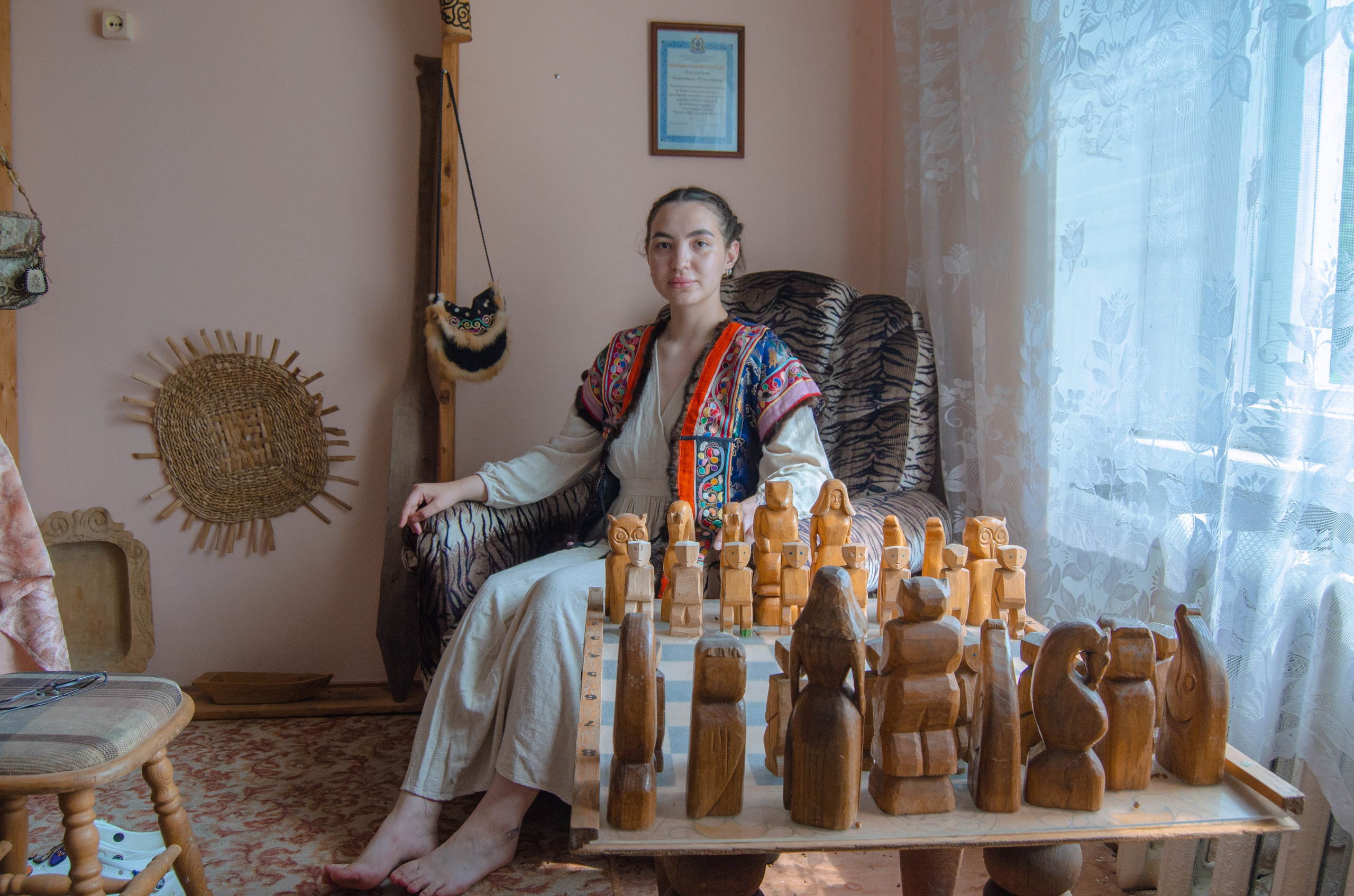
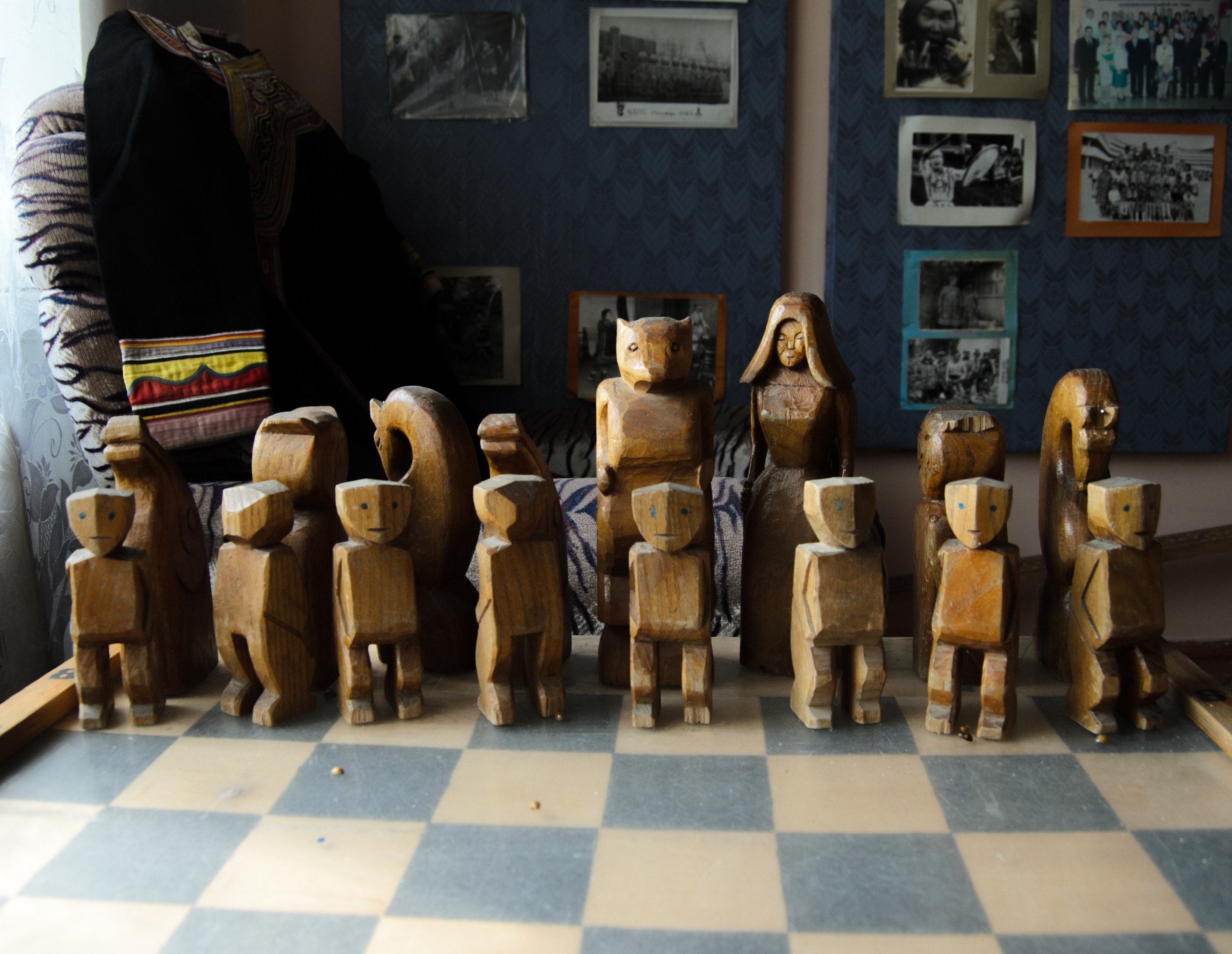
It’s unsettling to listen to my niece’s kimonos
As she tells of the Udege idols, the patrons of the clan. And, like children of the 20th century, we no longer believe in gods, but we fear ancient spirits and deities just in case. The old Udege women remember them. They absorbed the knowledge from their mothers.
I watch as Nelli Ilyinichna carefully touches the wooden figures of the idols, and her reverence involuntarily passes to me. And it seems I hear Chinese bells on the shaman’s belt and the sounds of a gong. Vividly I imagined ritual songs and whispers in the smoky darkness.
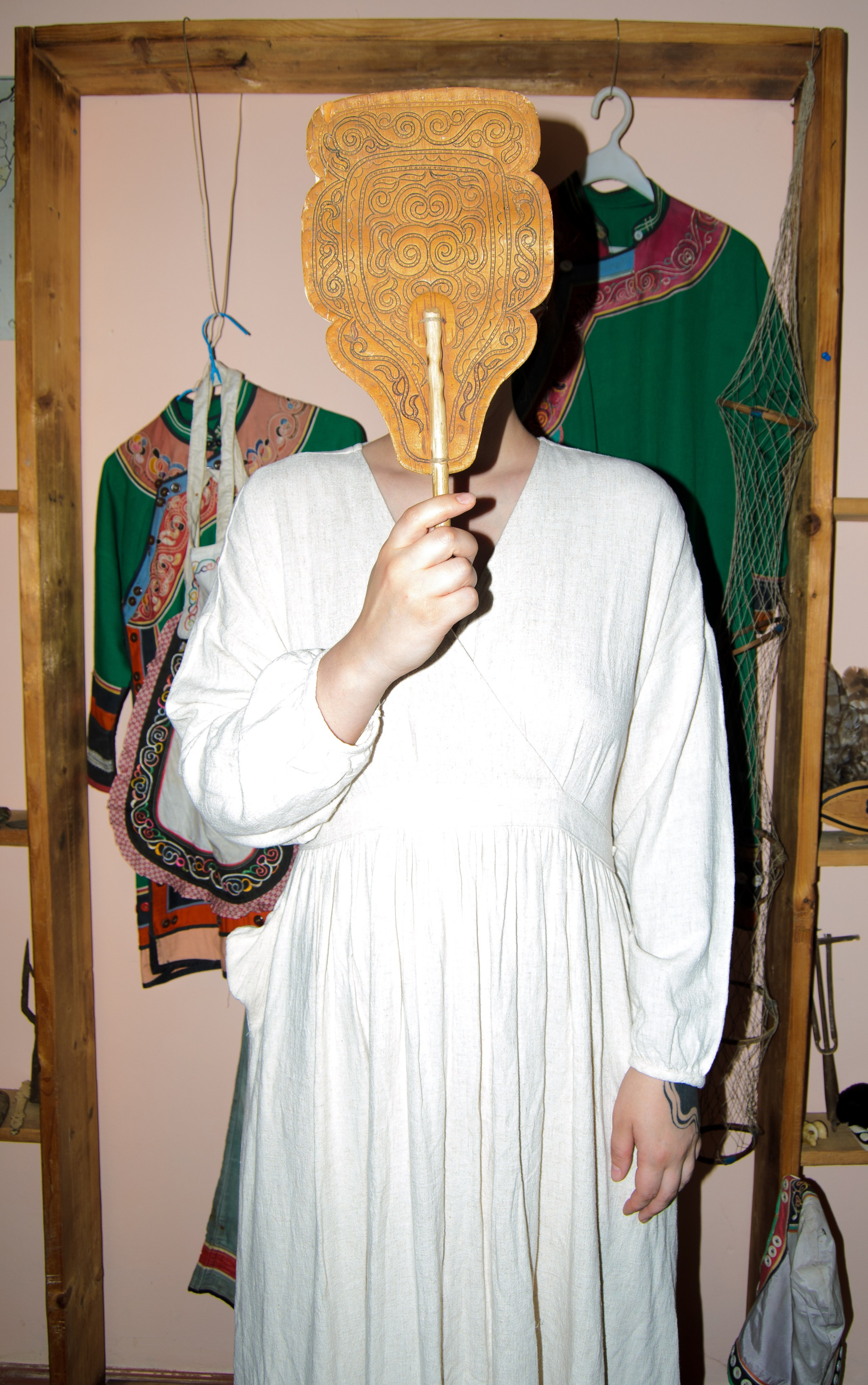
And I’m thinking, this is what I’m thinking about:
A strong woman — an Udege woman. Strong, and therefore spirits obey her requests, they hear her. She is not afraid to pay for the benevolence of the ancient gods, just as she is not afraid to go through the taiga alone to the place where the carcass of a moose killed by her husband lies, in order to butcher it. One wants to bow to the strength of this woman, who was able to give birth to a child in solitude and cold.
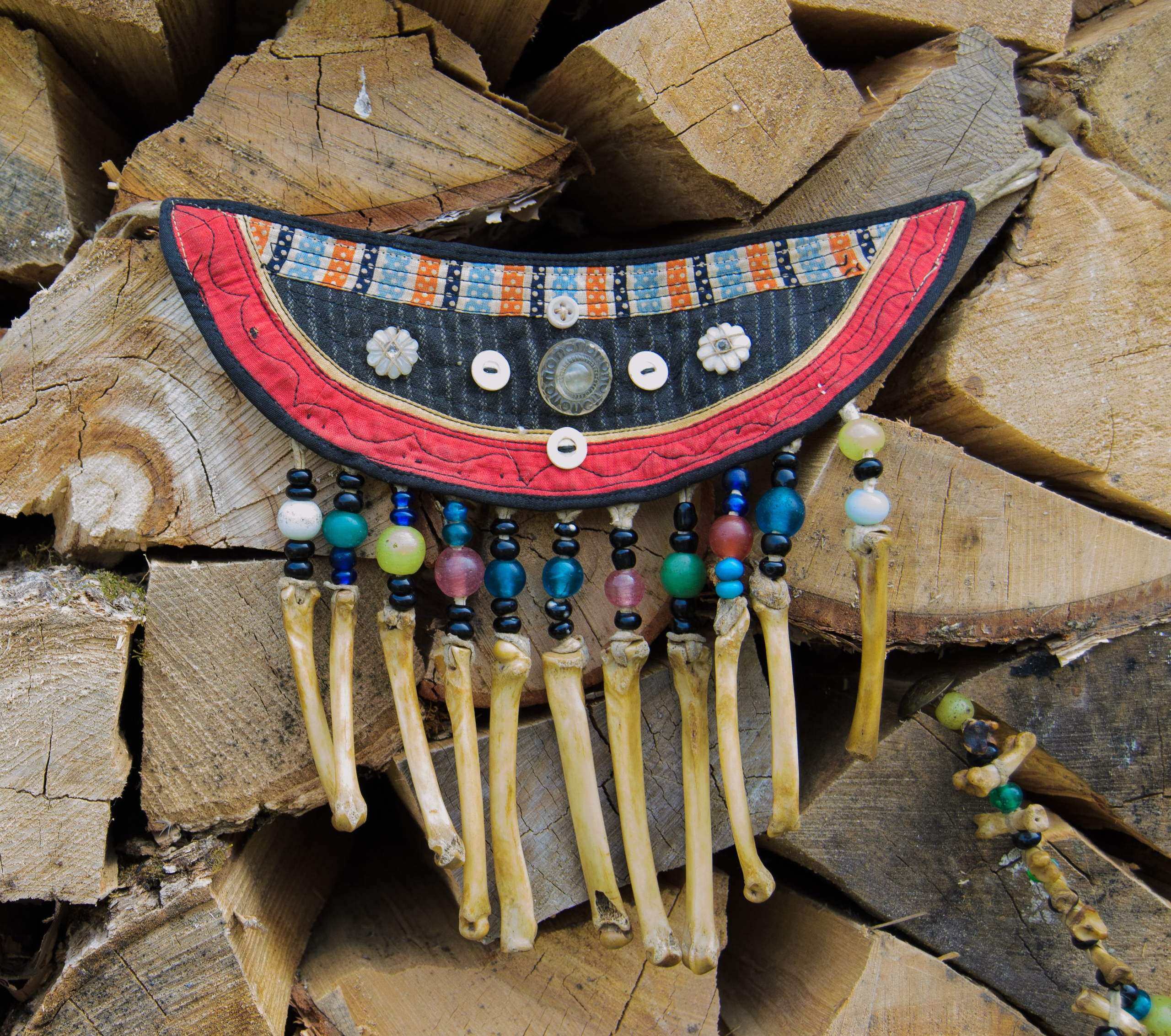
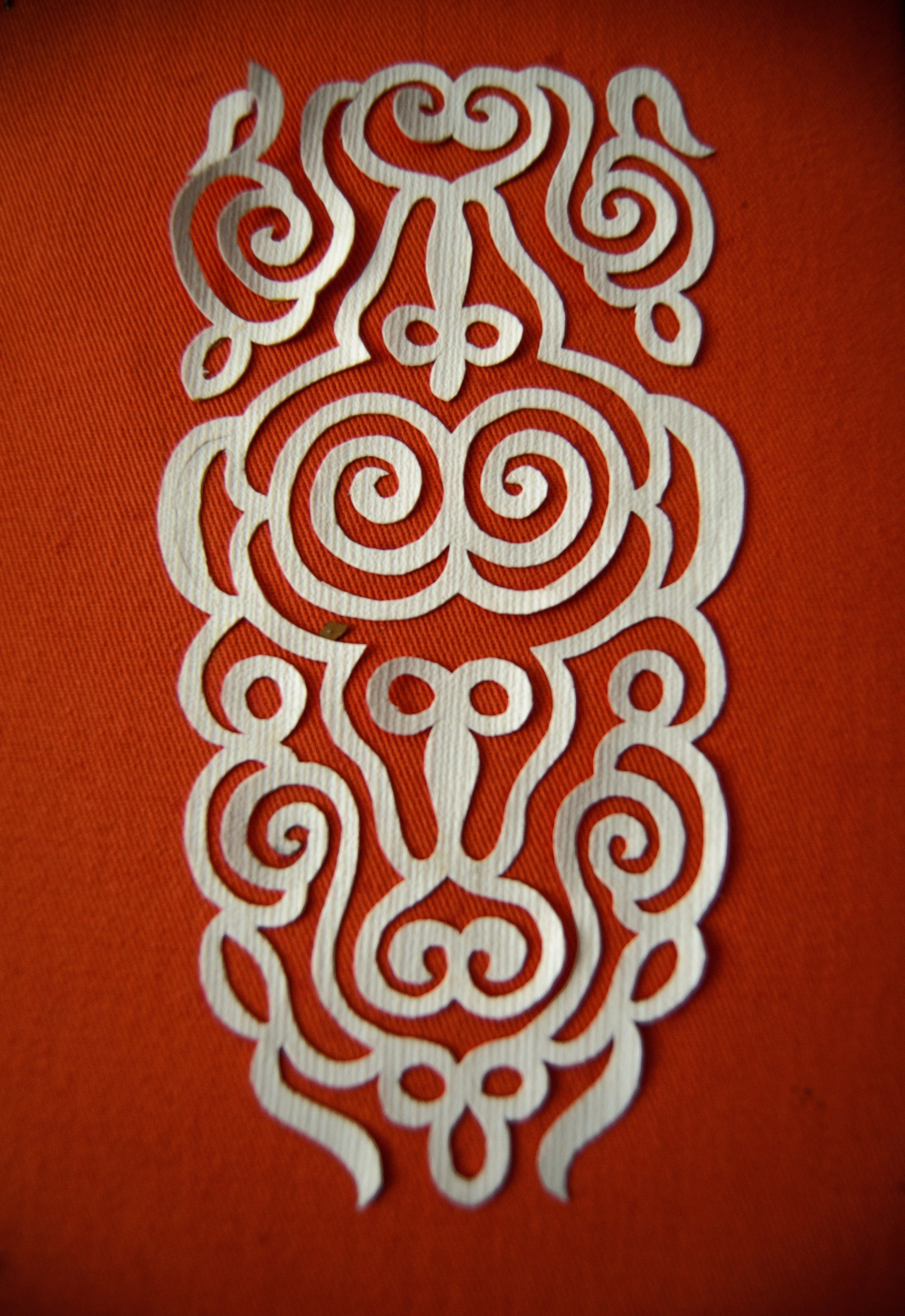
Left: rattle made of small bones for a baby crib. Right: Udege patterns carved into fish skin.
Egad mastery
I was amazed. I gasped and sighed as I touched the delicate patterns — you wouldn’t say they were on skin. Airy, they seemed to still hold the warmth of the departed shaman’s hands. I can imagine how these laces are woven, but I can’t imagine how Yagada cut them with her own hands on the skin. The work is too delicate.
Udege craftswomen are incredible. I was fortunate to meet Onisiya Alexandrovna Kyalundzyuga — a craftswoman from the village of Gvasyugi. She was invited to Moscow and Leningrad, where she held master classes and exhibited her works. She preserves ancient skill, being the only craftswoman of this level. A friendly and modest woman showed her works, looking at which I understood once again what a woman can do with her own hands.
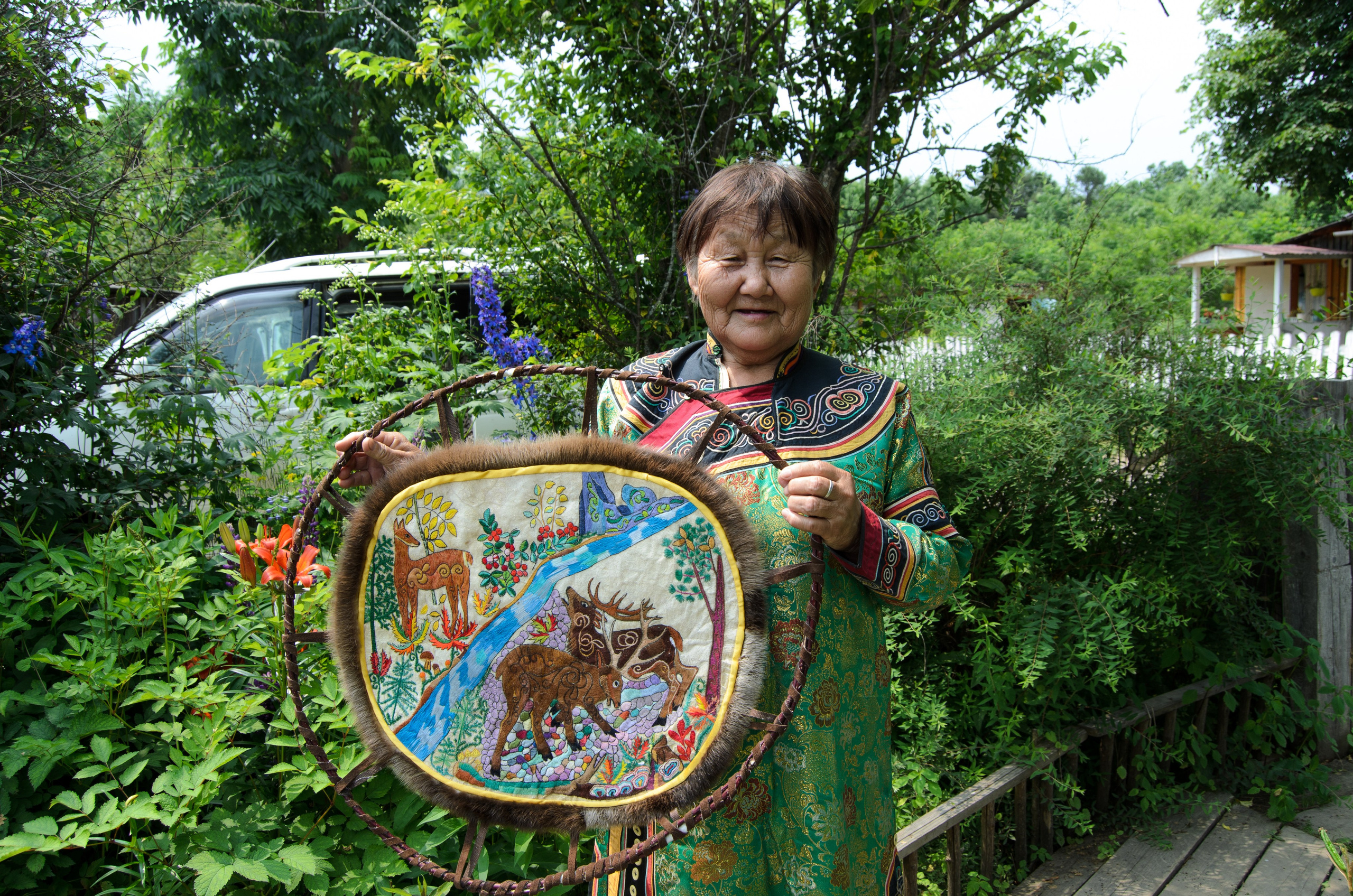
Onisiya Aleksandrovna Kyalyundzyuga
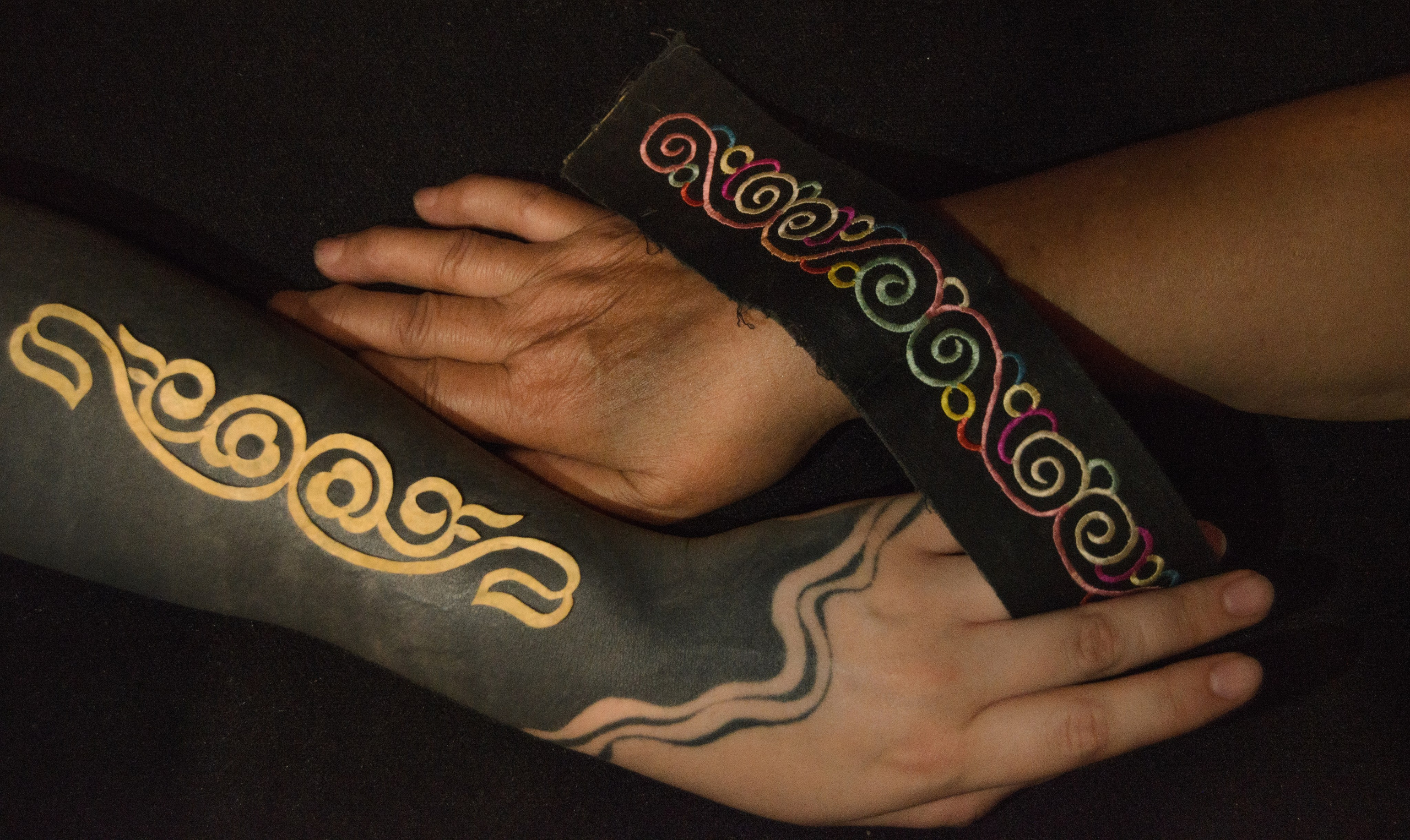
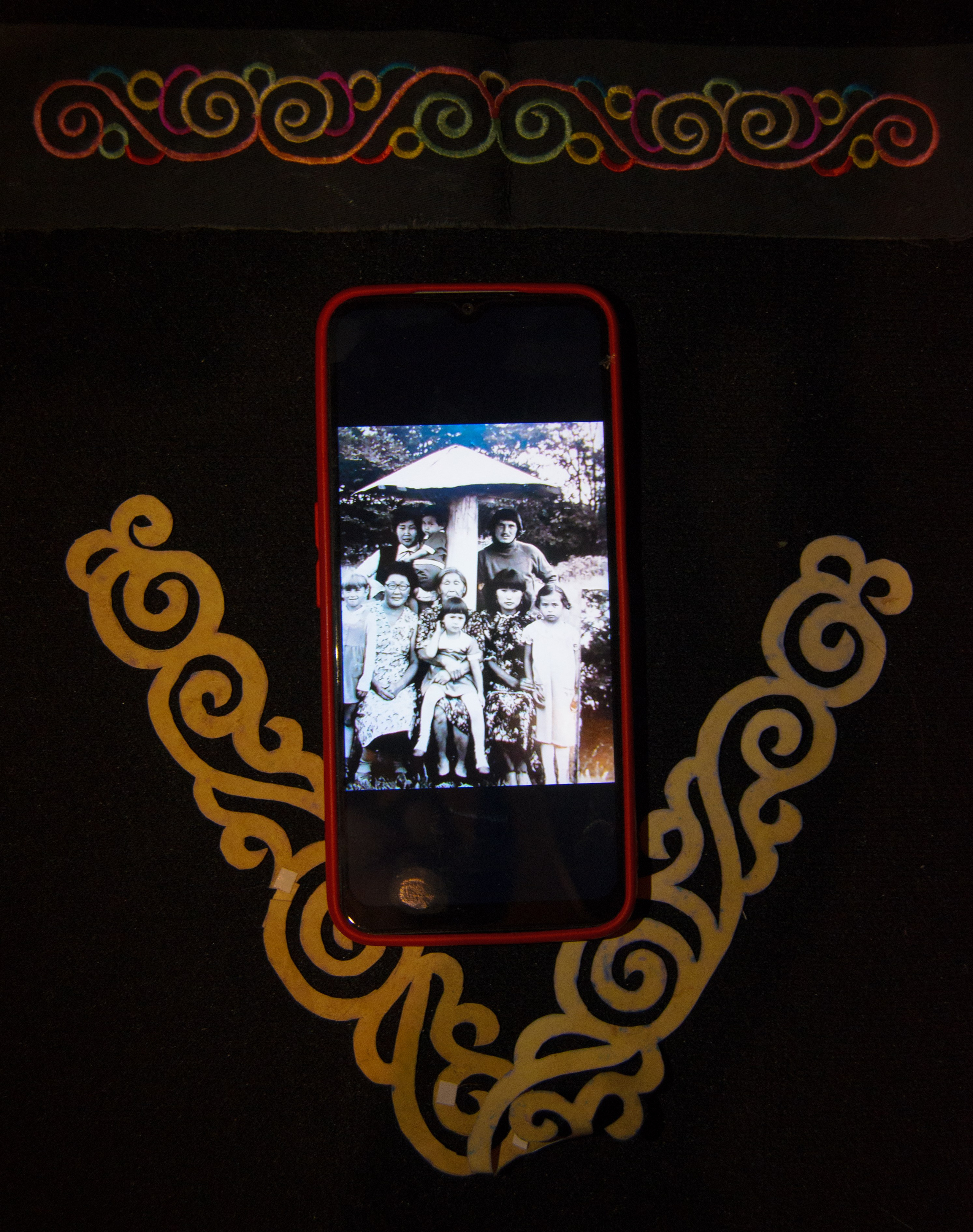
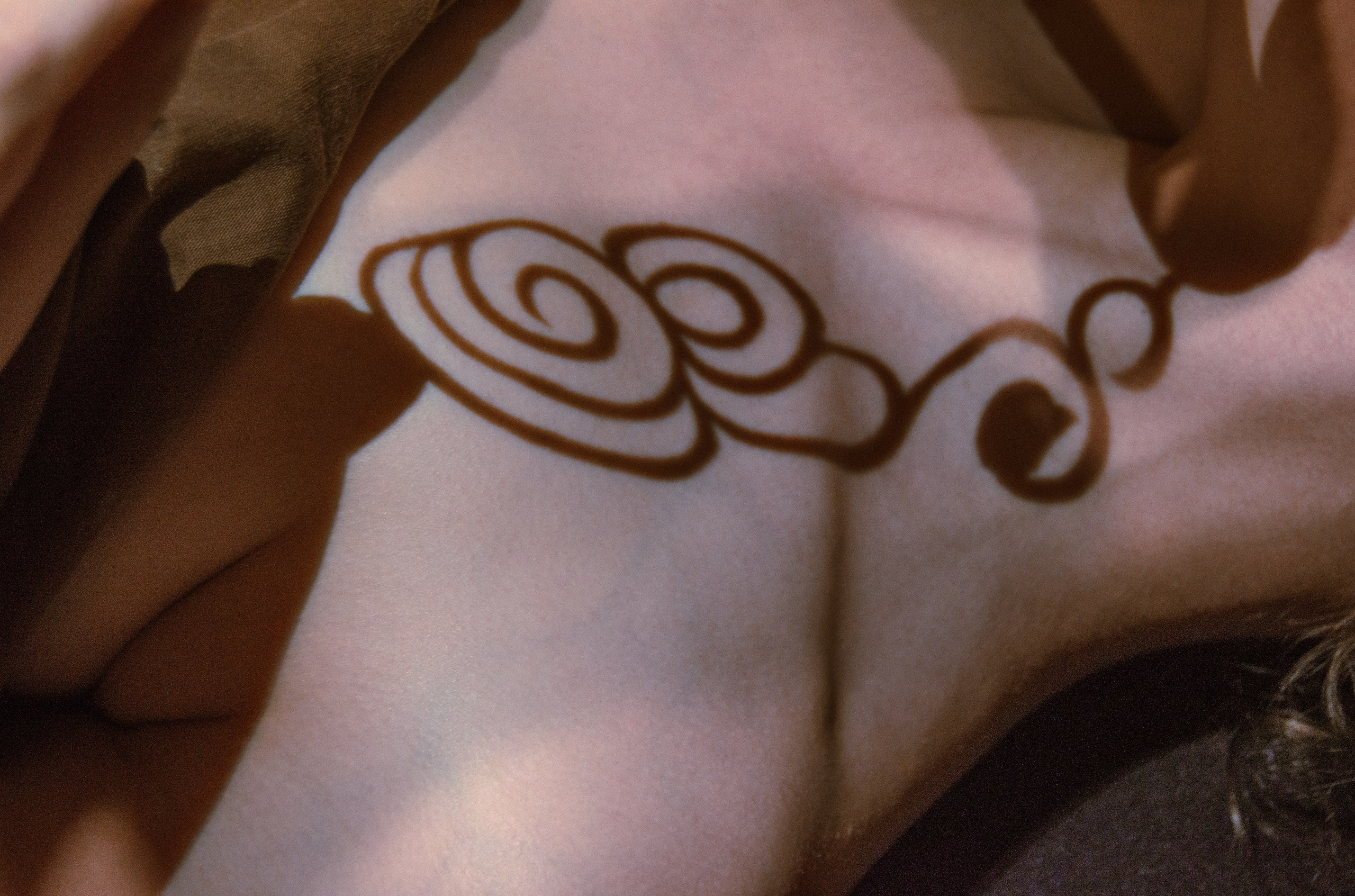
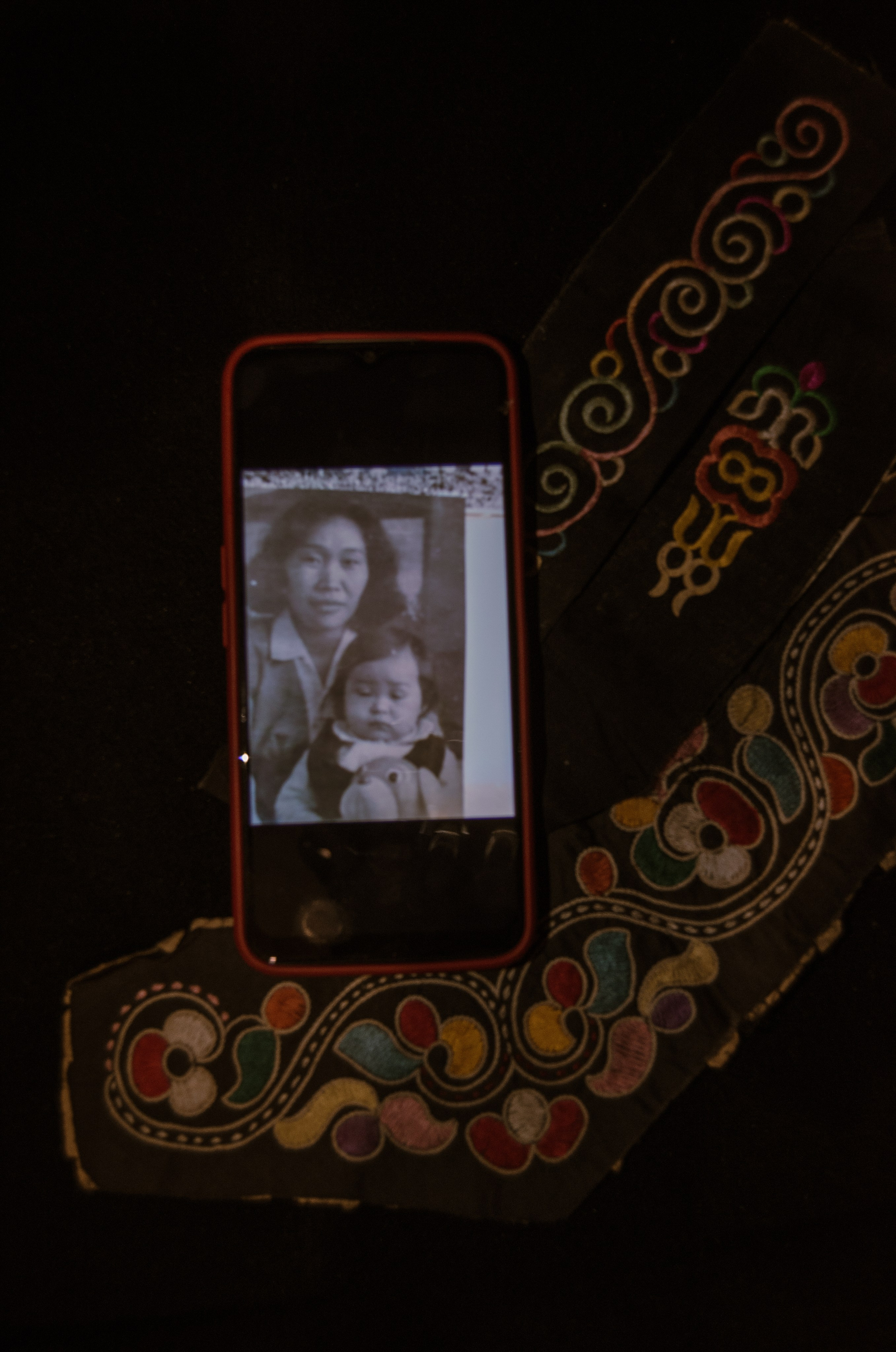
Egad ornaments
Delicate work
Her work amazed with its subtlety. Invisible stitches, delicate embroidery, pieces of fabric intertwined, creating a picture. Everything in it was harmonious: color and form. In every detail, a woman and nature were interwoven. Onisiya Alexandrovna is still on the path of a craftswoman, simultaneously translating Udege folktales.
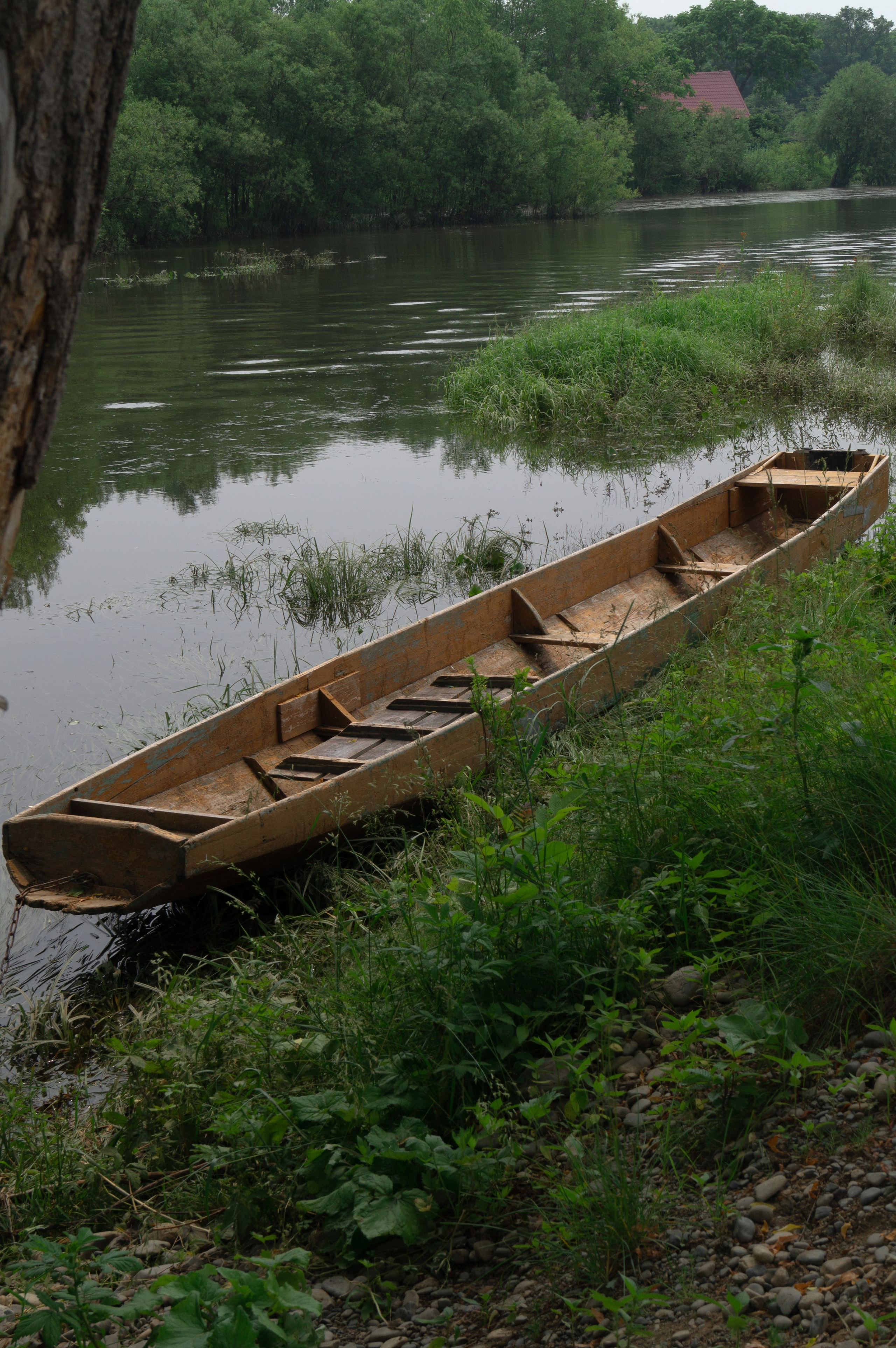
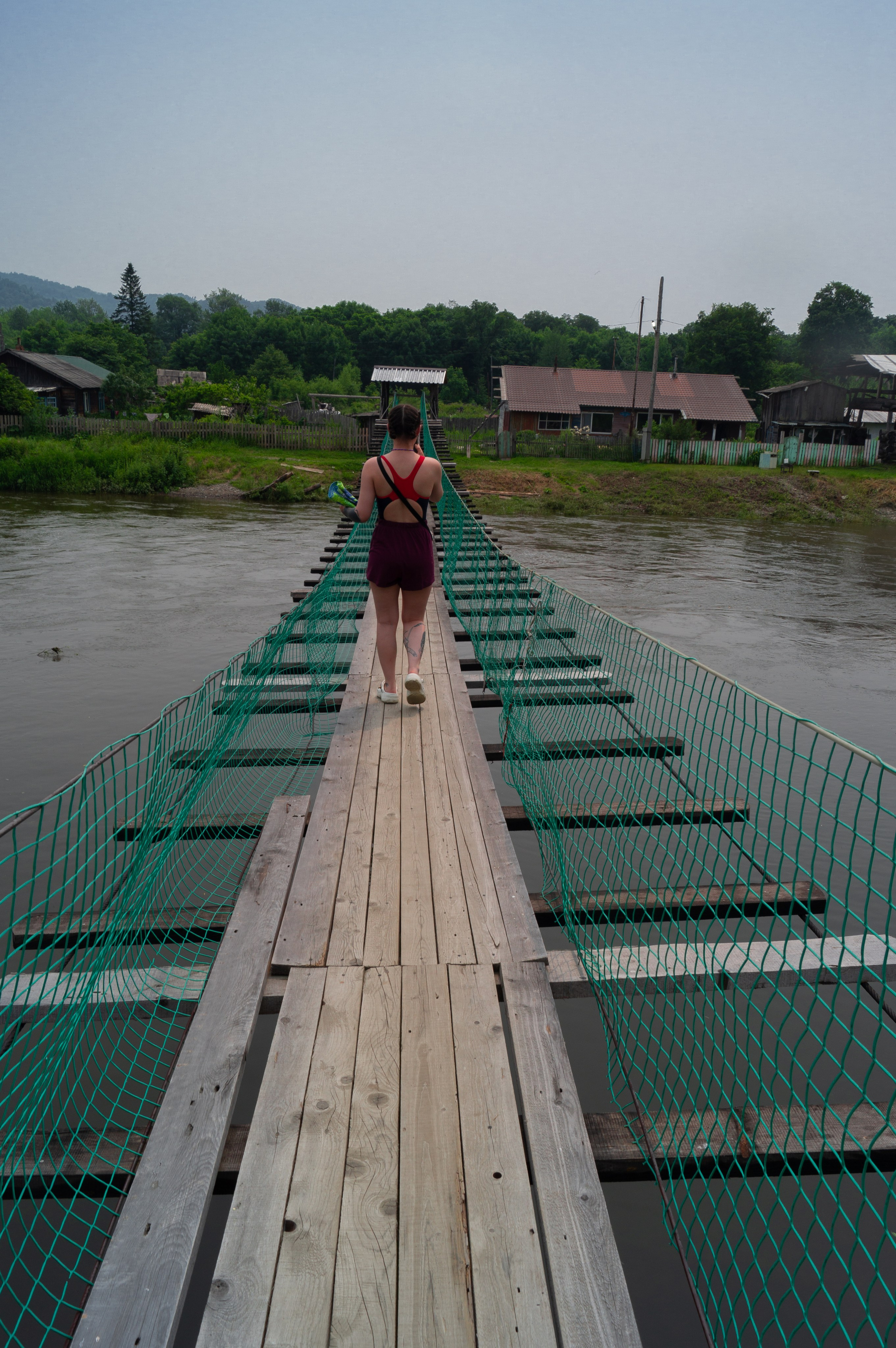
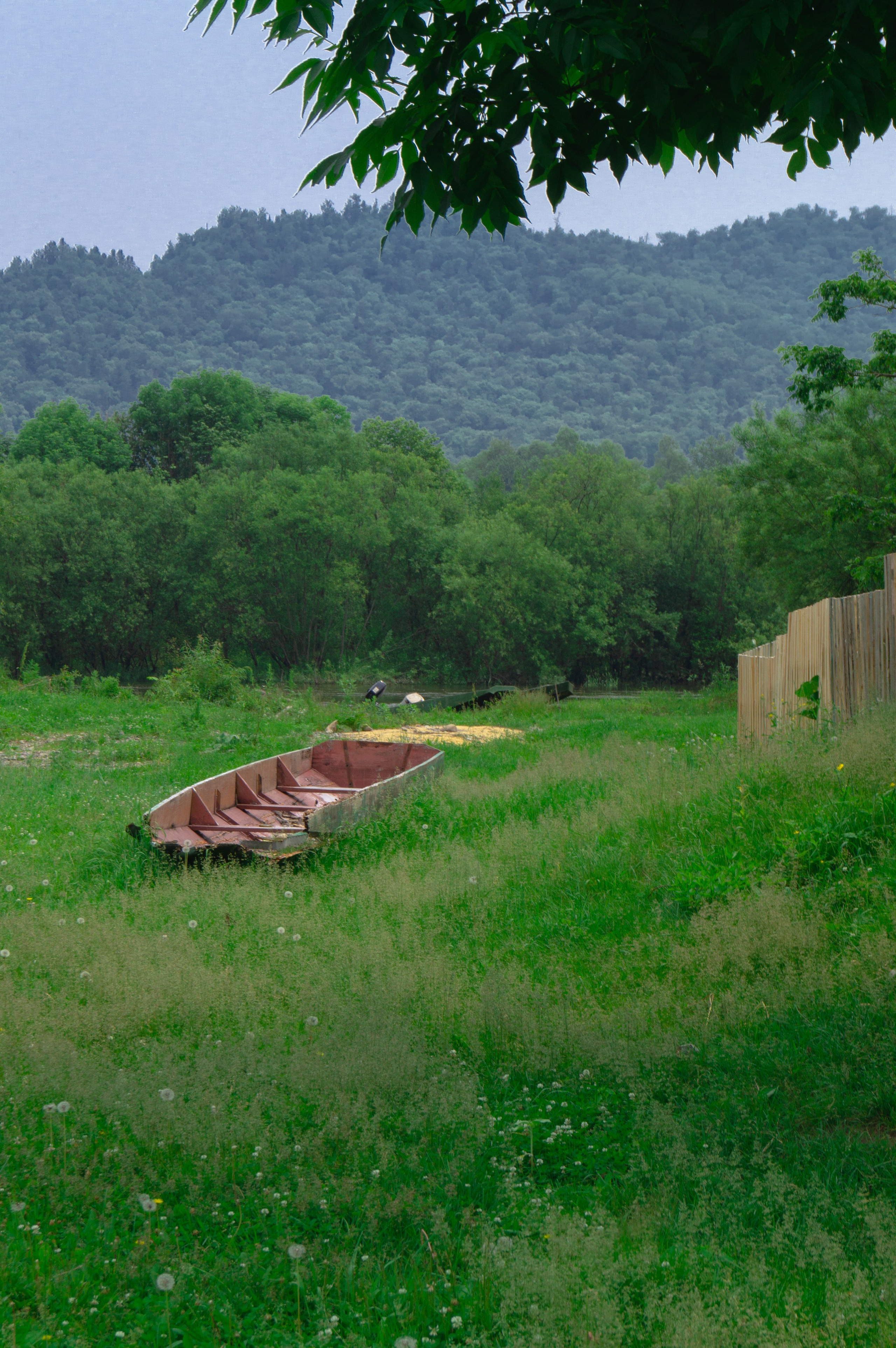
Udege fairy tales
Women often told stories to the children around the campfire in the shack. They were permeated with the smell of campfires, fish, and bear fat. They smelled of herbs boiling in the pot, of the taste of bird cherry cakes. Their melodious language, so similar to Chinese, penetrated every cell. It seemed that if you closed your eyes in a modern house, an old Udege woman, you would open them again in a shack in the middle of the taiga, behind whose walls the ancient pines were rustling.
Before the salmon run, Kanda-Mafa prepared for fishing. While he was fixing the boat, and Letiga was washing the dishes by the river, their son broke the cradle, climbed out, and came to them on his own two feet.
“I’ve already slept, ” he said.
“Give me a mokcho shirt!”
Kanda-Mafa gaped in surprise: “Tembe-be-be! Wife! Do you see what’s happening! Bata is asking for clothes, and he’s walking on his own!”
Letiga dropped the dishes, looked at her son, and couldn’t believe her eyes. She sewed him a mokcho shirt and light uli boots made of deer hide. After a few days, both the clothes and the shoes were too tight for him. They had to sew again… By the time the snow fell, Bata was already reaching the top logs of the yurt with his head. Winter stretched on long, but the boy grew quickly.
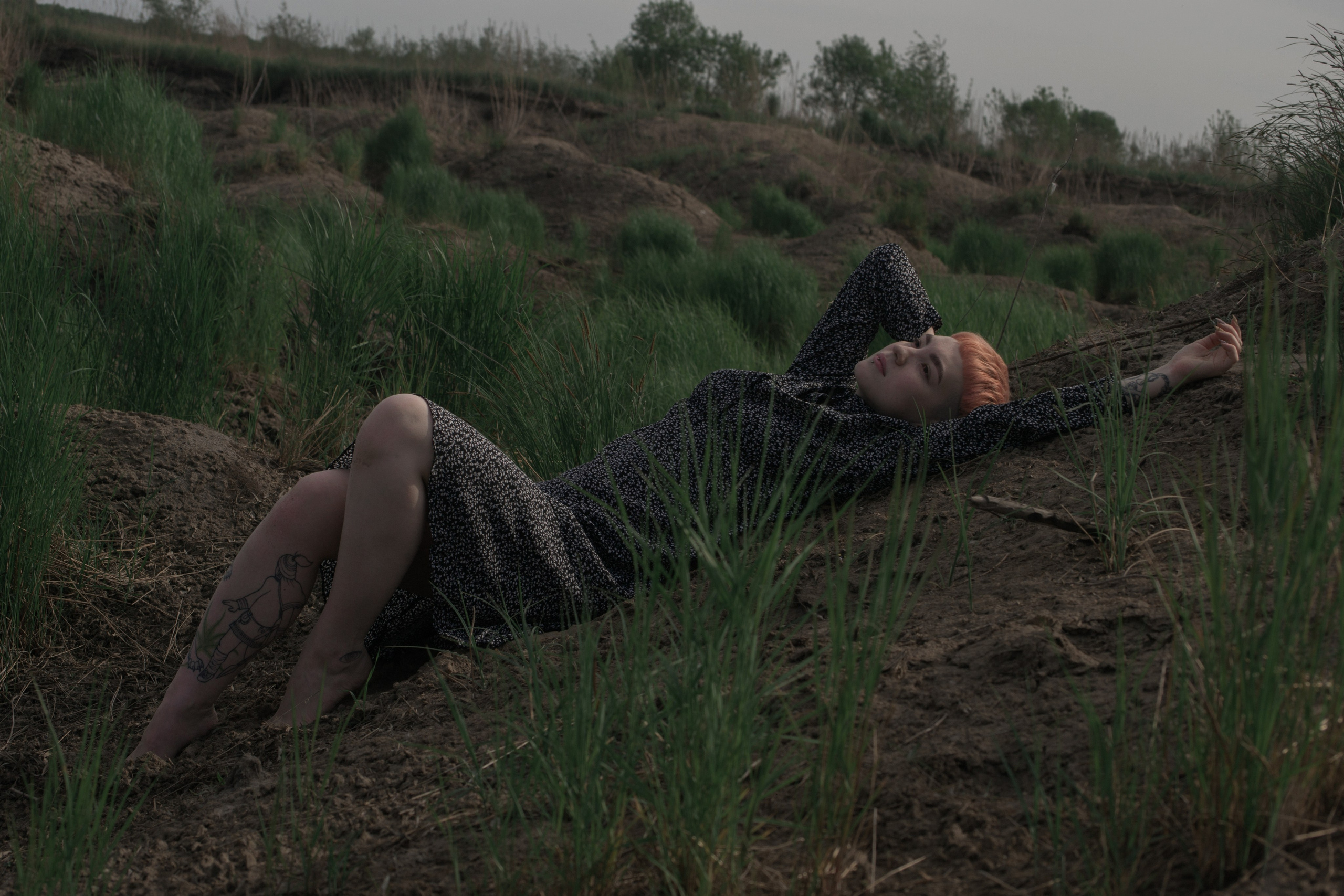
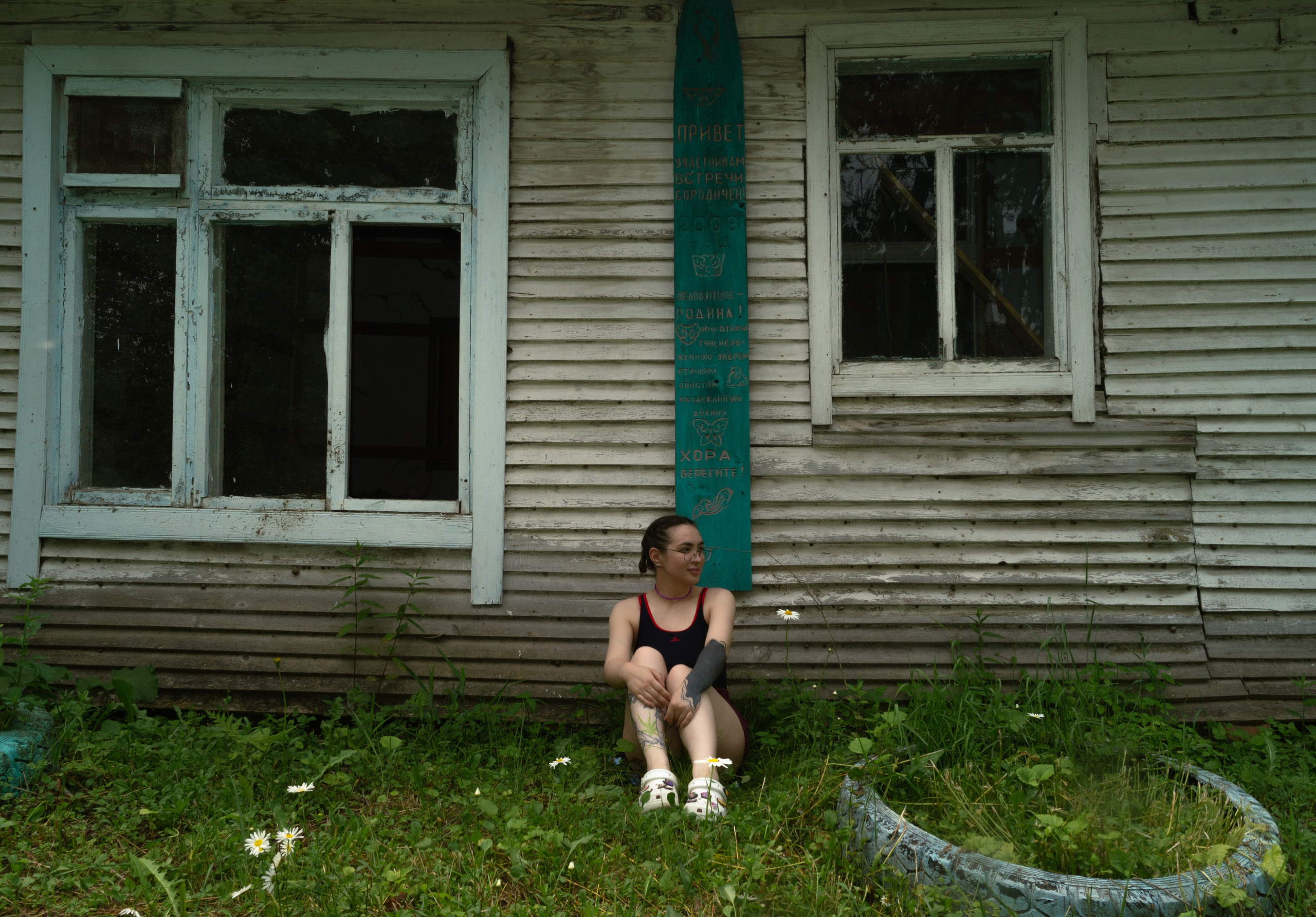
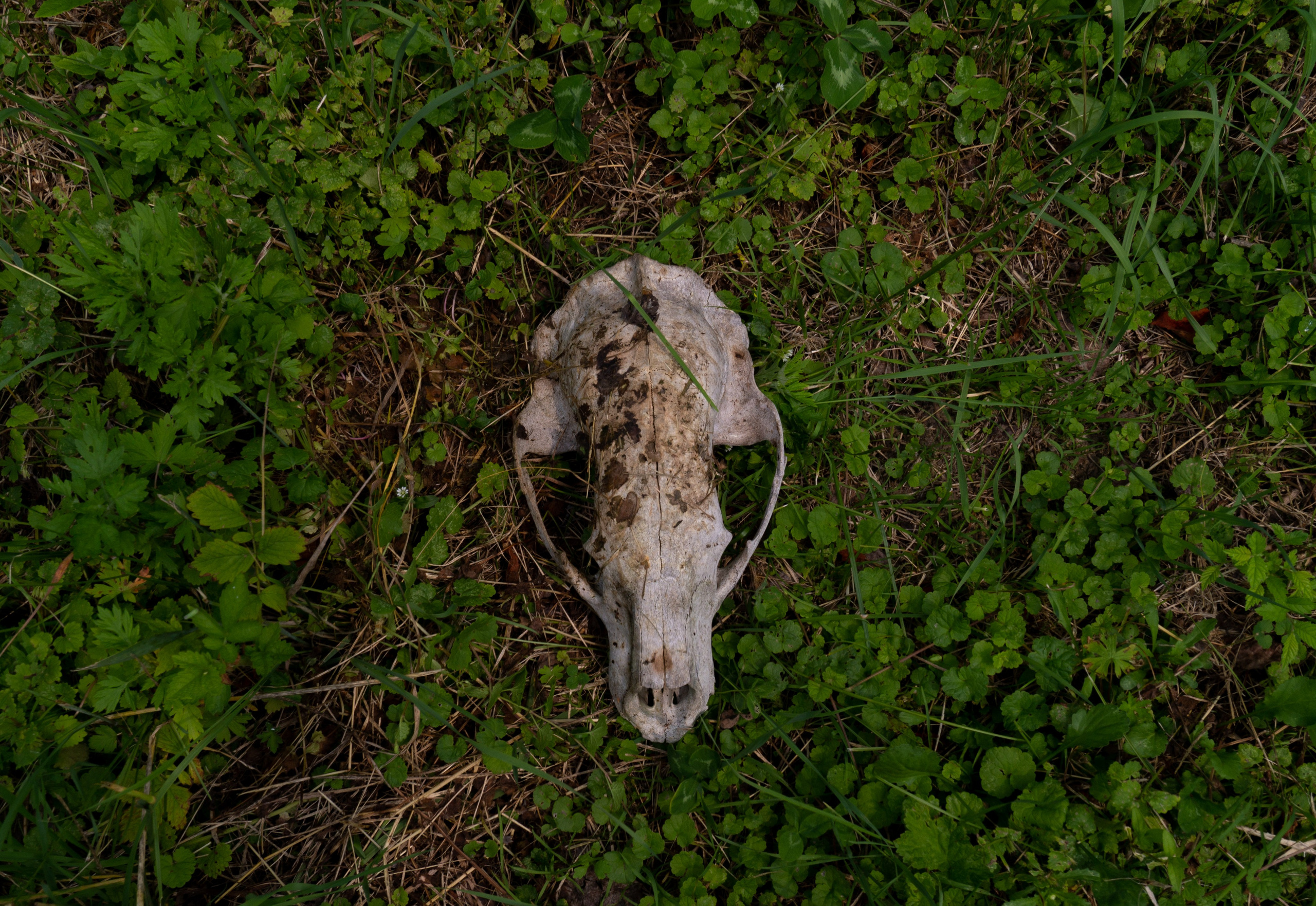
Lives a little
Gvasyugi village, even the children run in the streets. They are happy, tanned, high-cheeked, with heavy black hair that falls on delicate girl shoulders or sticks up on boys' heads. While Nelli Ilyinichna tells another story, we hear a passing neighbor shouting from behind the gate. She asks if Nelli Ilyinichna is alive and well.
“We check on each other, ” explains the Udege woman.
The neighbors support each other, checking on each other’s health. Gvasyugi is nestled by the river, in the middle of the taiga. Doctors and the nearest settlement are far away, so the women worry about each other.
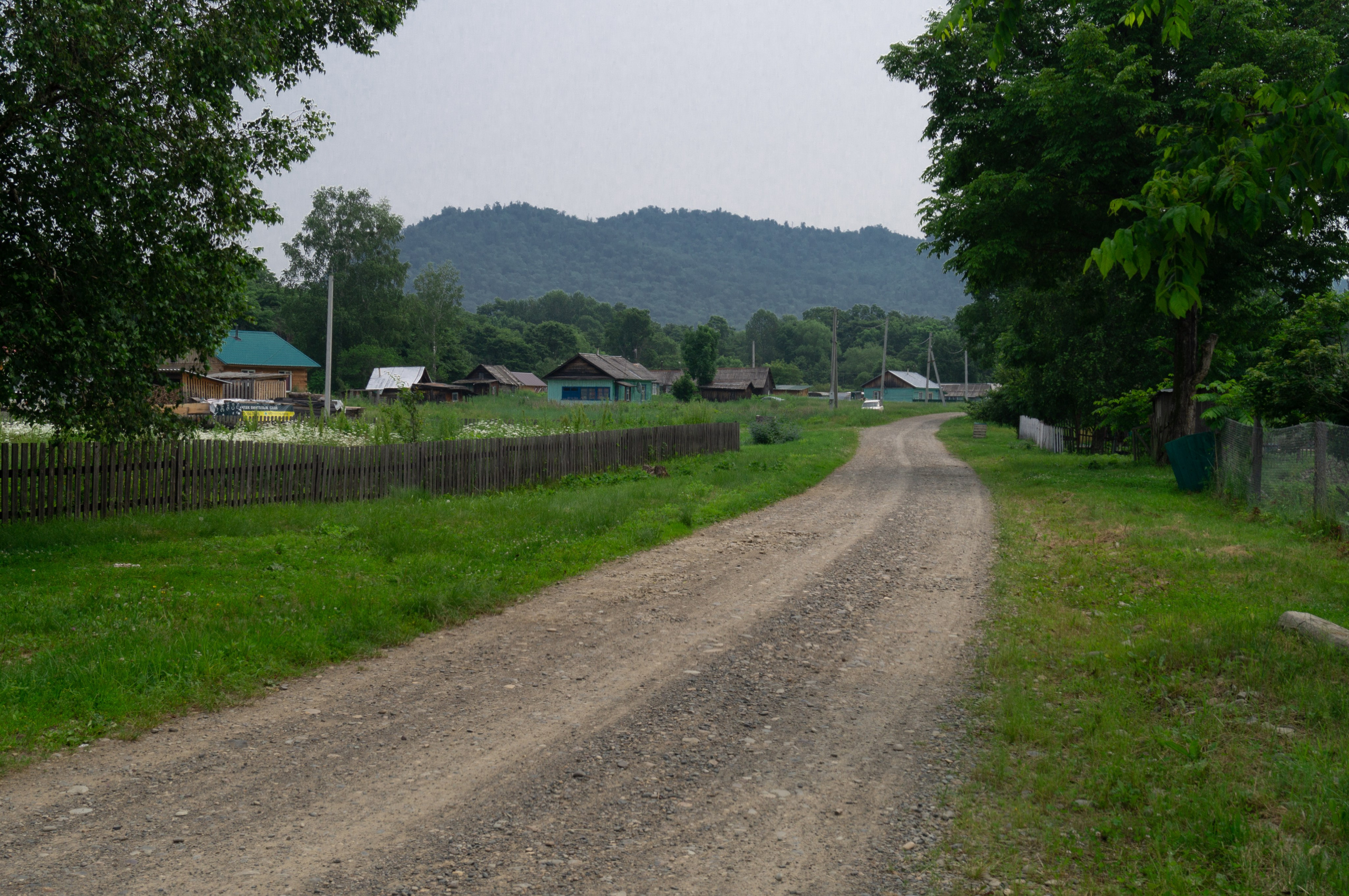

They wandered around the area, swatting at the pesky mosquitoes. They talked about various things. Dasha reminisced. About the enormous burdock leaves growing in Gvasiugi, Nelly Ilyinichna remembered how a tiger had carried off a dog, how they used to make cherry cakes.
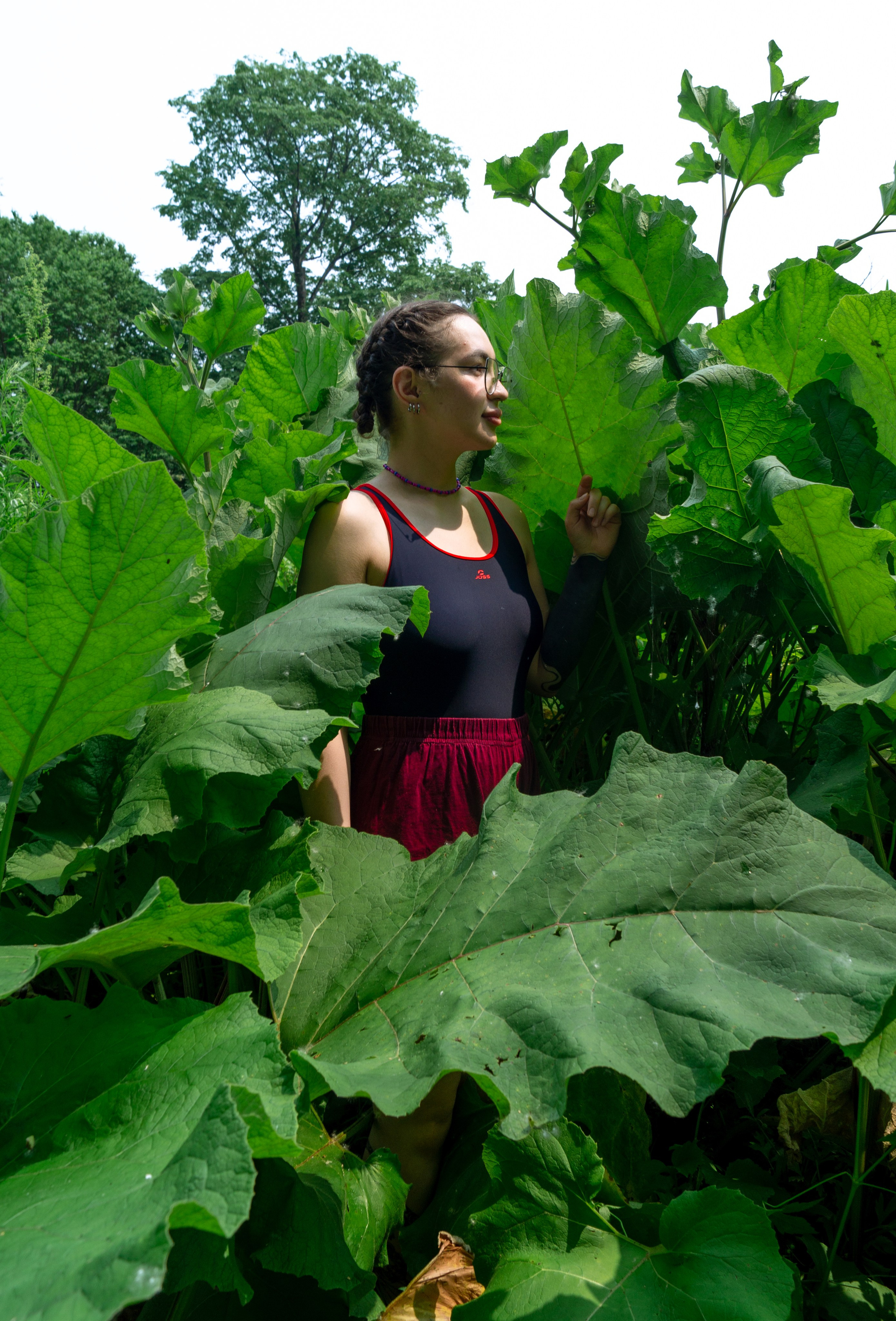
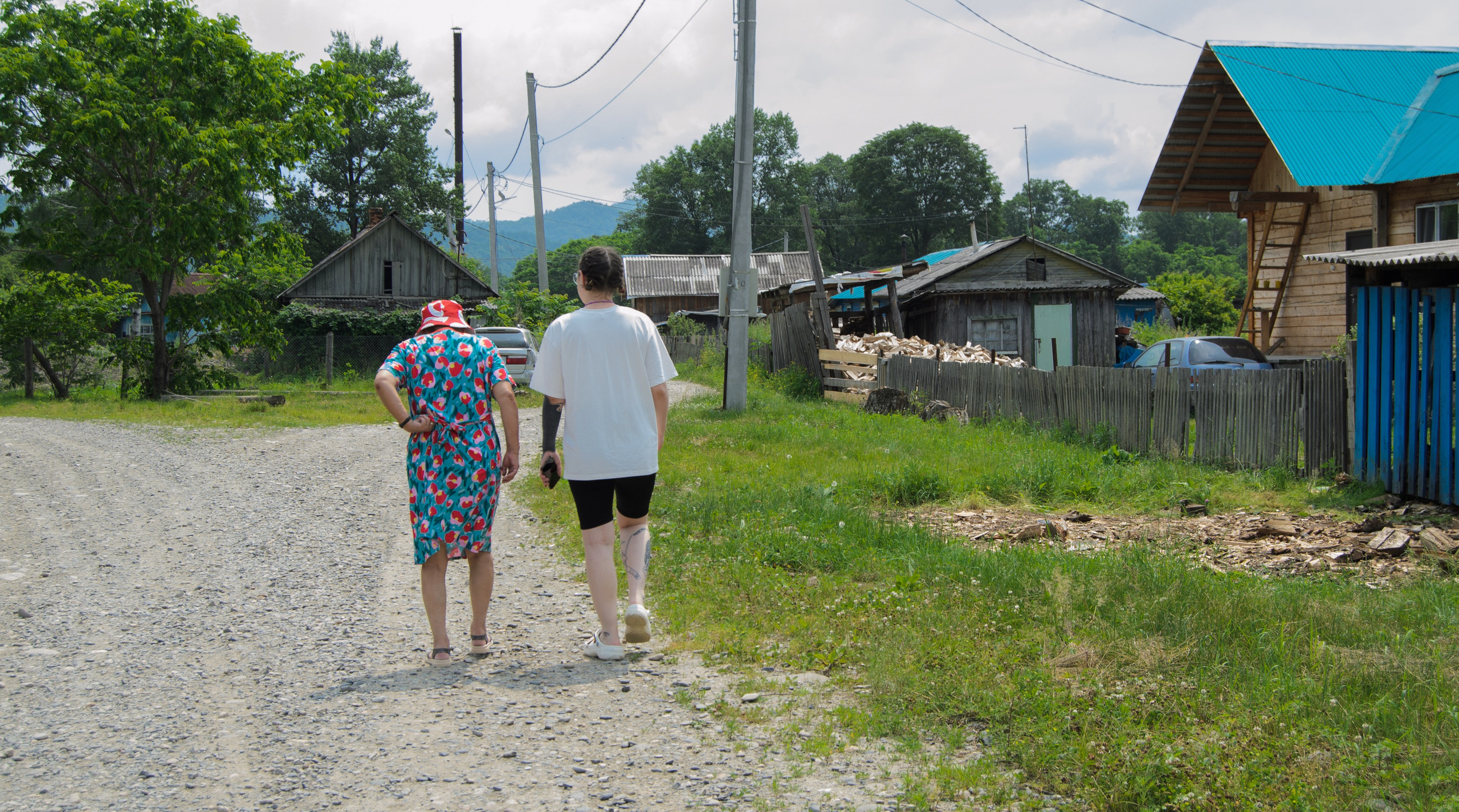
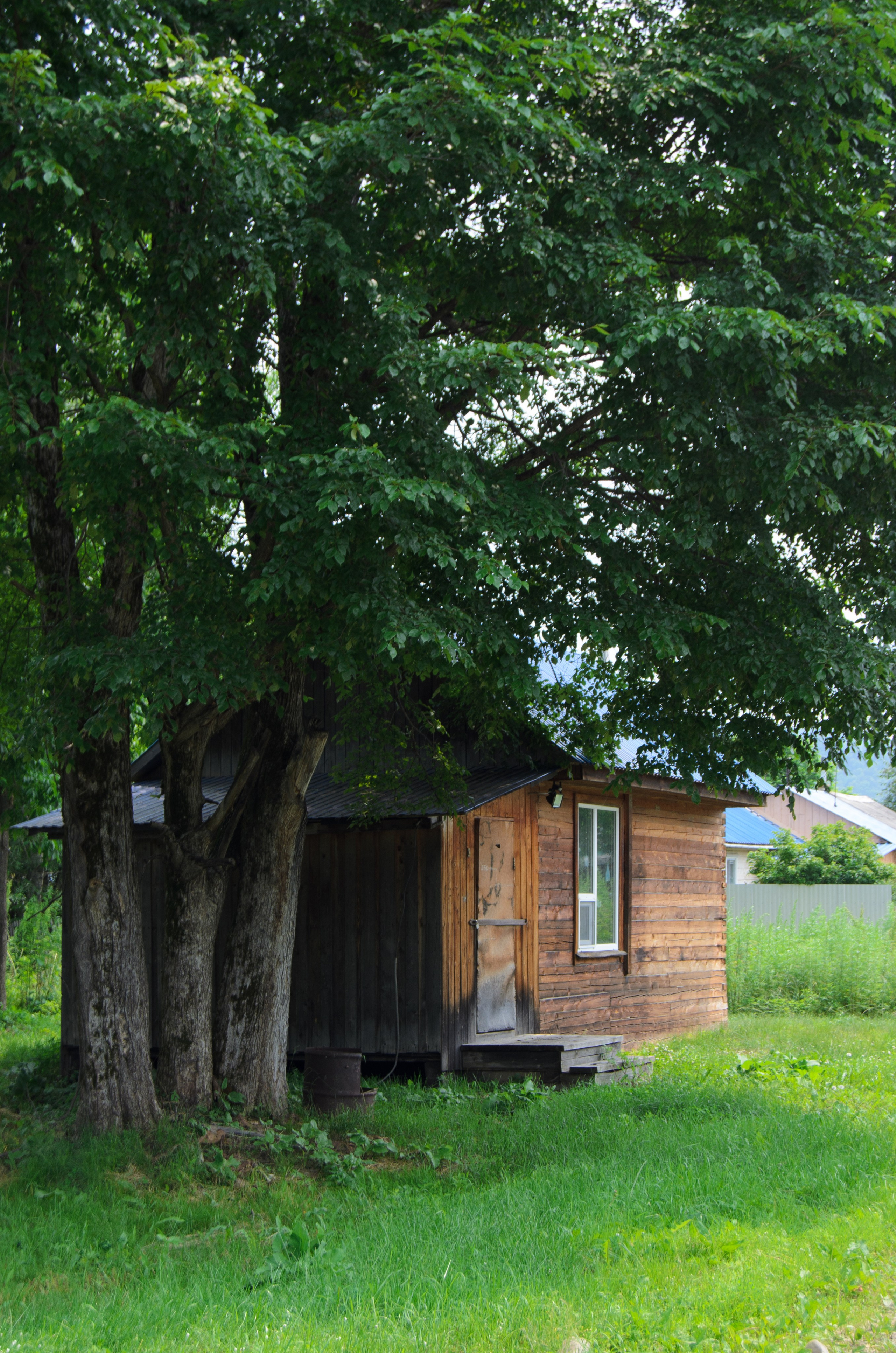
And I wanted
to take away with me a part of this life. And the tears would well up later, at home, when I suddenly missed Nelly Ilyinichna’s conversations so much, the quiet, measured life of the small Udege village, the capital of Udege — Gvasyugi.
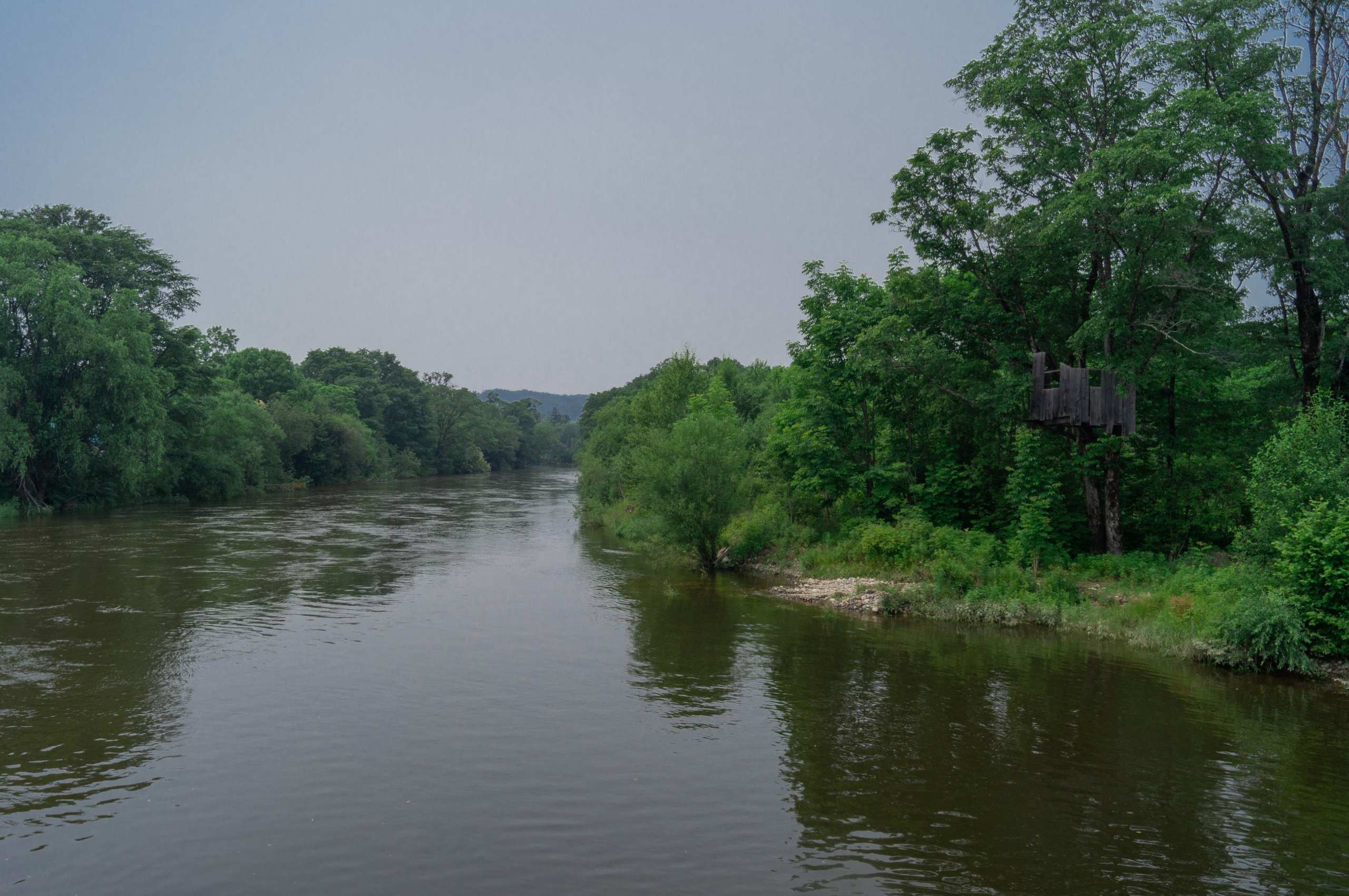

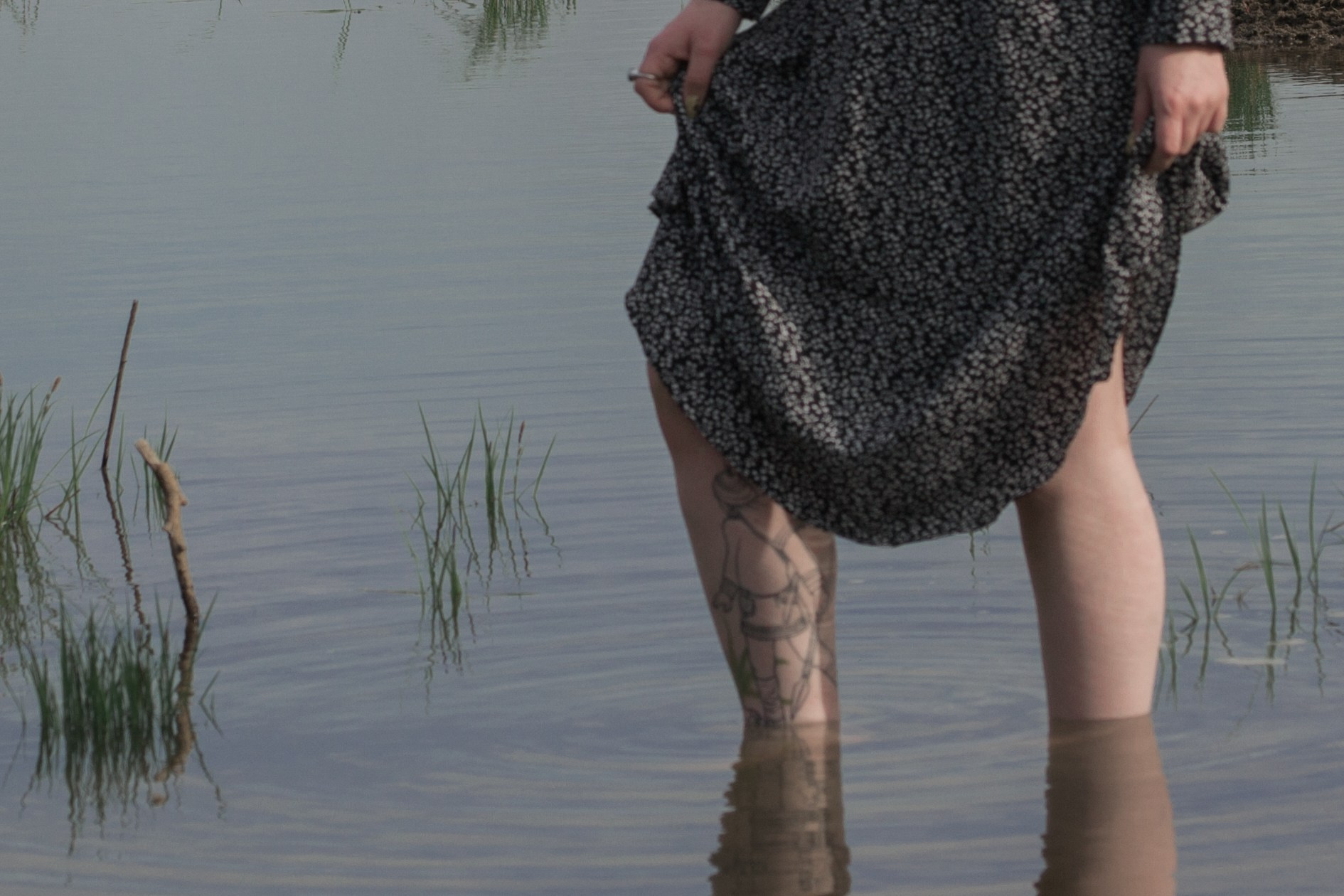
Even in the icy water, she missed the choir. To at least immerse herself in it, she had to stand in the water for a long time, getting used to the cold. They stood until their legs began to go numb, and then with a whoop, plunged into the icy river, immediately jumping out with screams and laughter, burned by the icy cold. And next to them, a little Udege girl, about 6 years old, splashed with a shy smile, like a fish in water. She was happy and not cold.

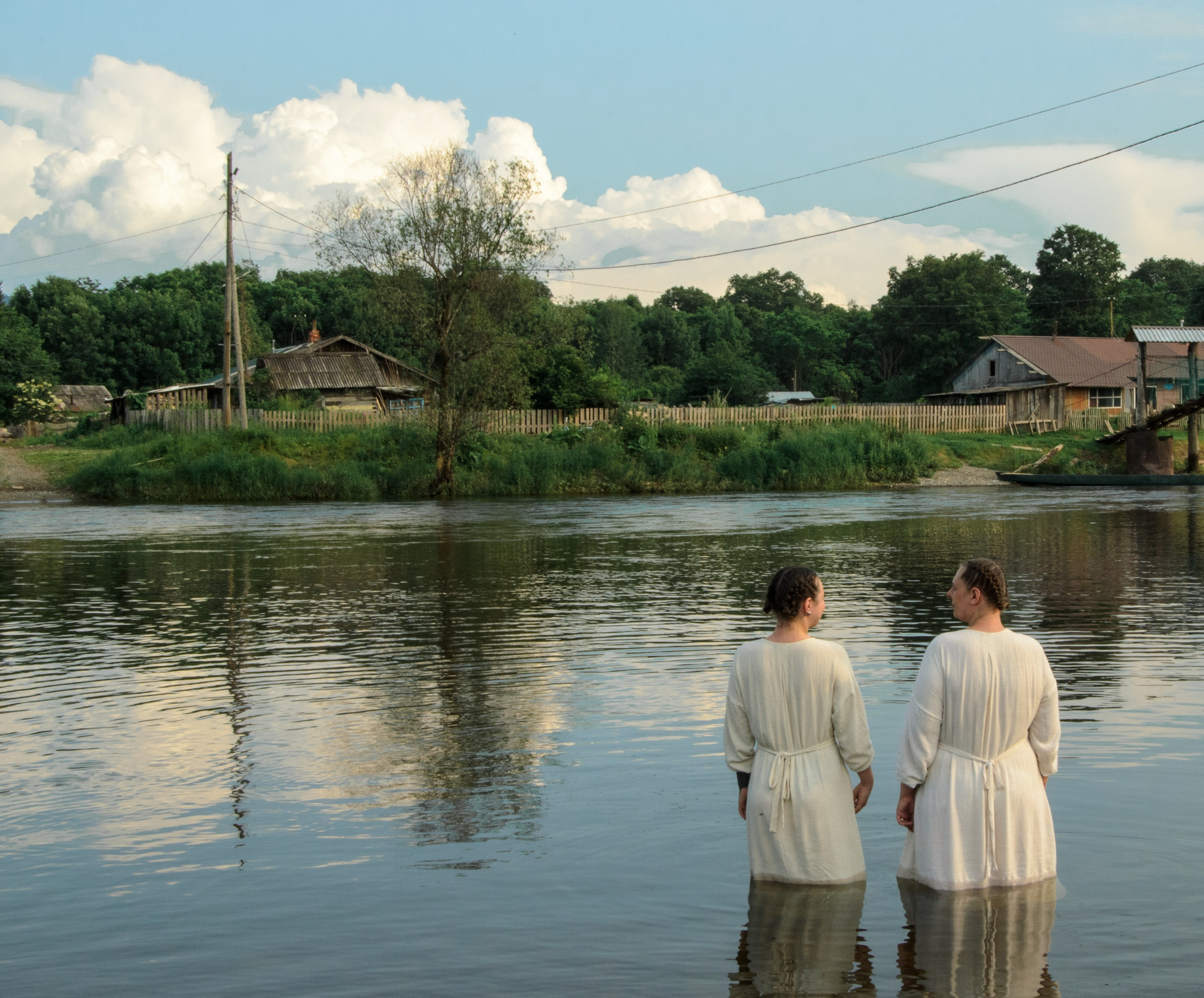
And I want,
So that the heritage of the Udege people may live. May it live, passed down from middle sister to middle sister. So that the melodious language may sound, may fly above the chorus. So that one day, an old Udege woman, smoking a long, Chinese-style pipe, may tell a tale, may sing a song.
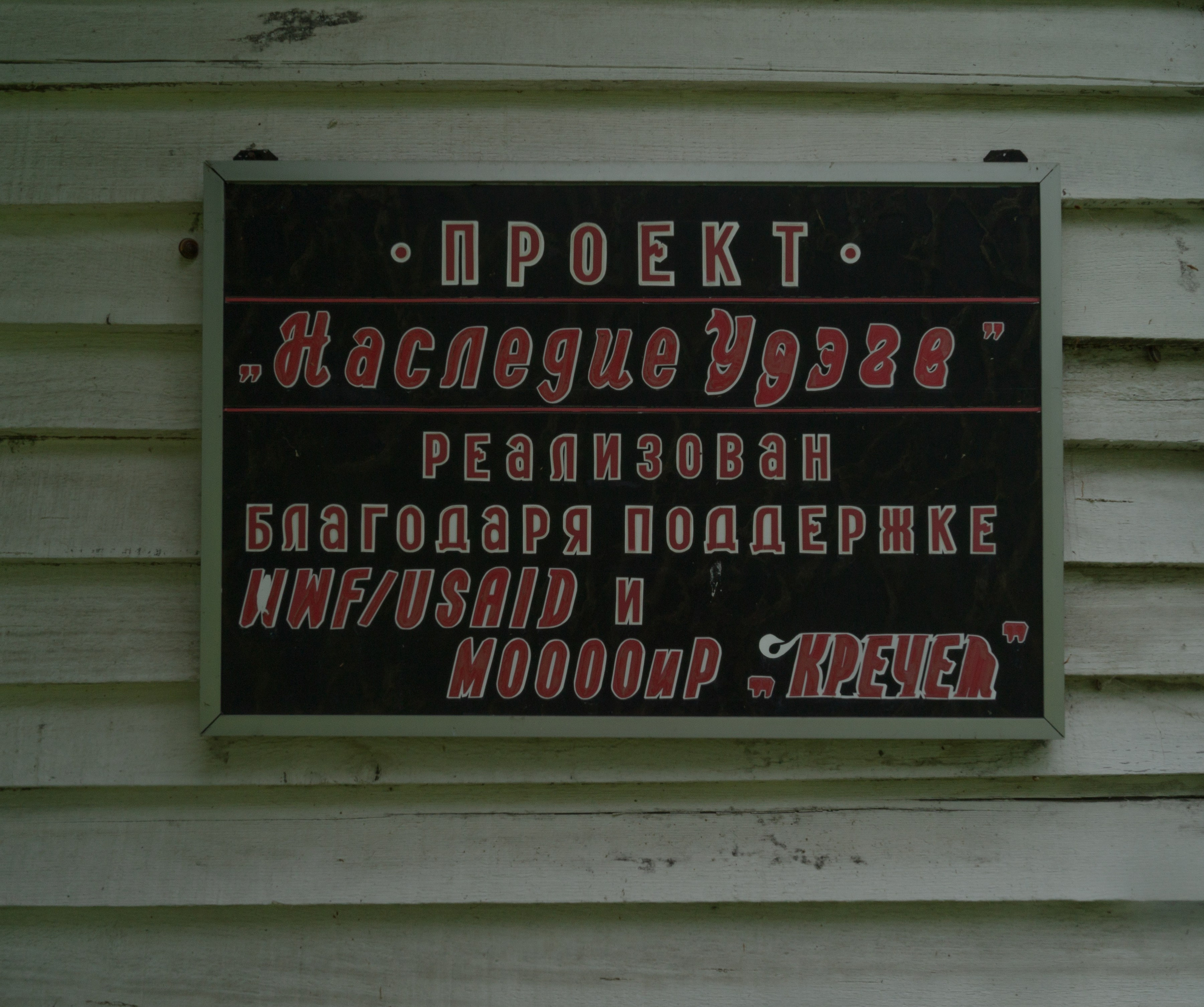
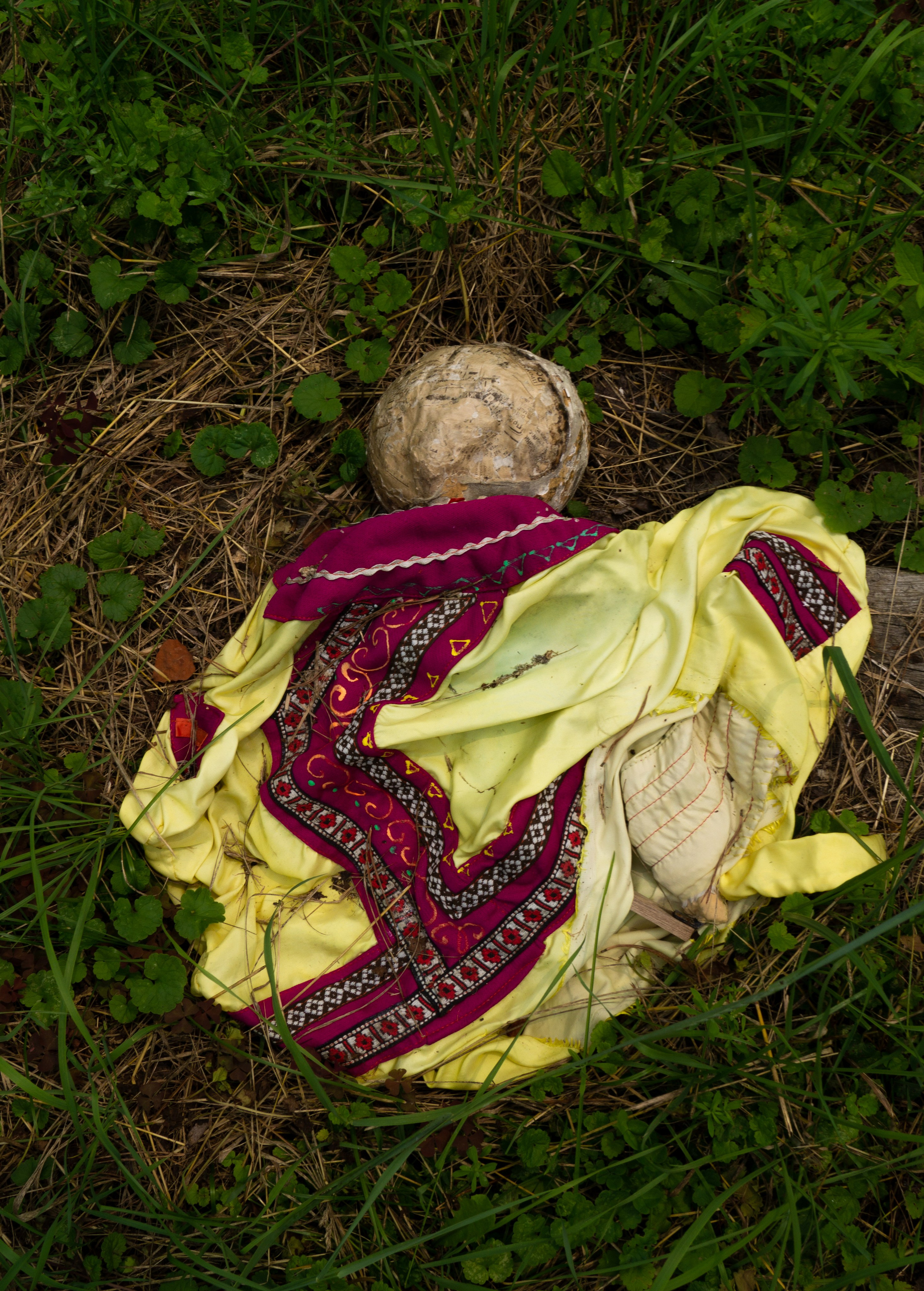
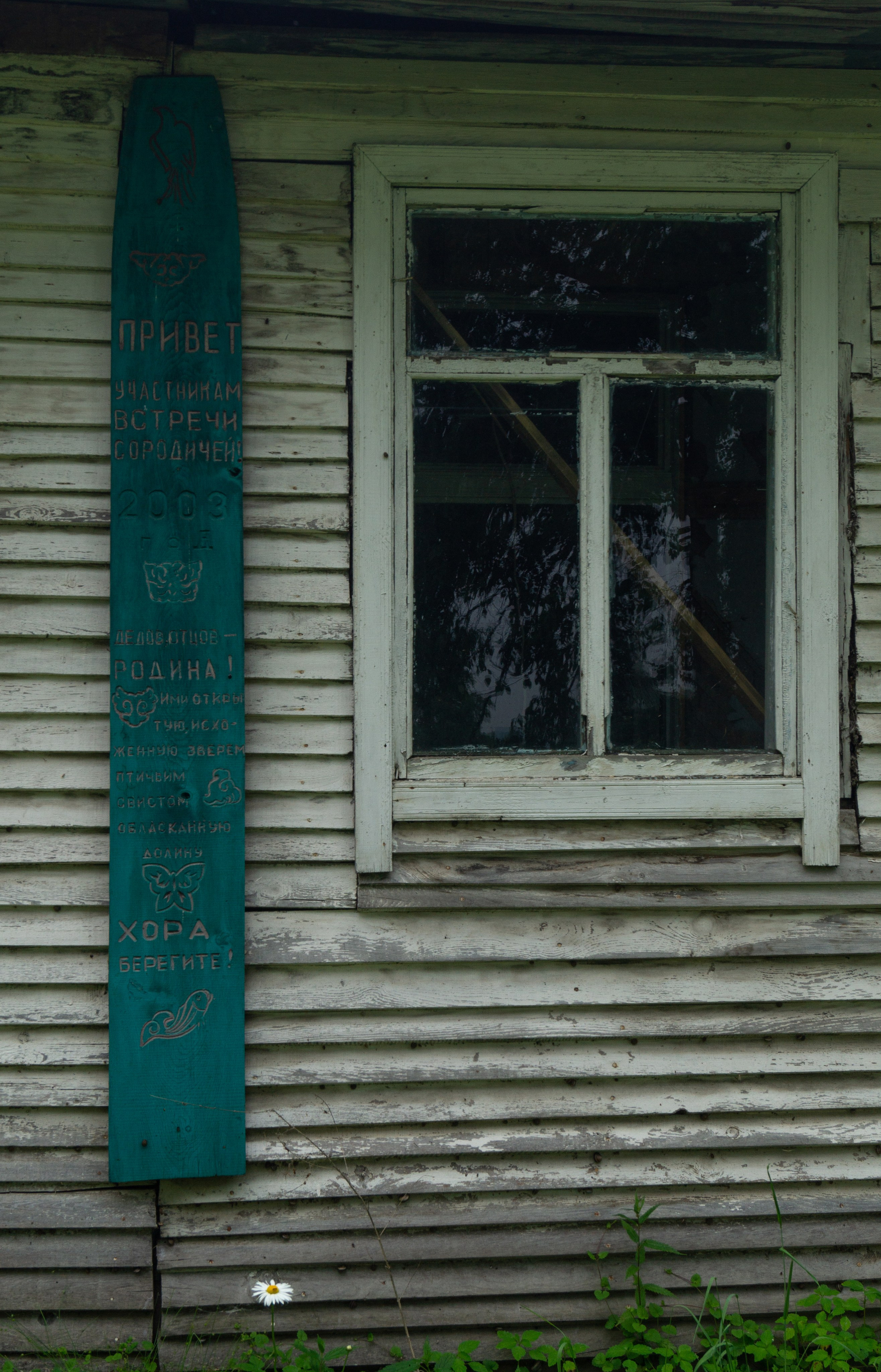
Thank you
To Nelly Ilyinichna, Larisa Ilyinichna, Onisiya Aleksandrovna, and my Dashka. Thank you for your trust, for this experience. Thank you for saying to me: “It’s strange, but you inspire trust and a desire to share.” I value this. And it’s scary not to live up to your trust.
I bow to you, women of the Udege.
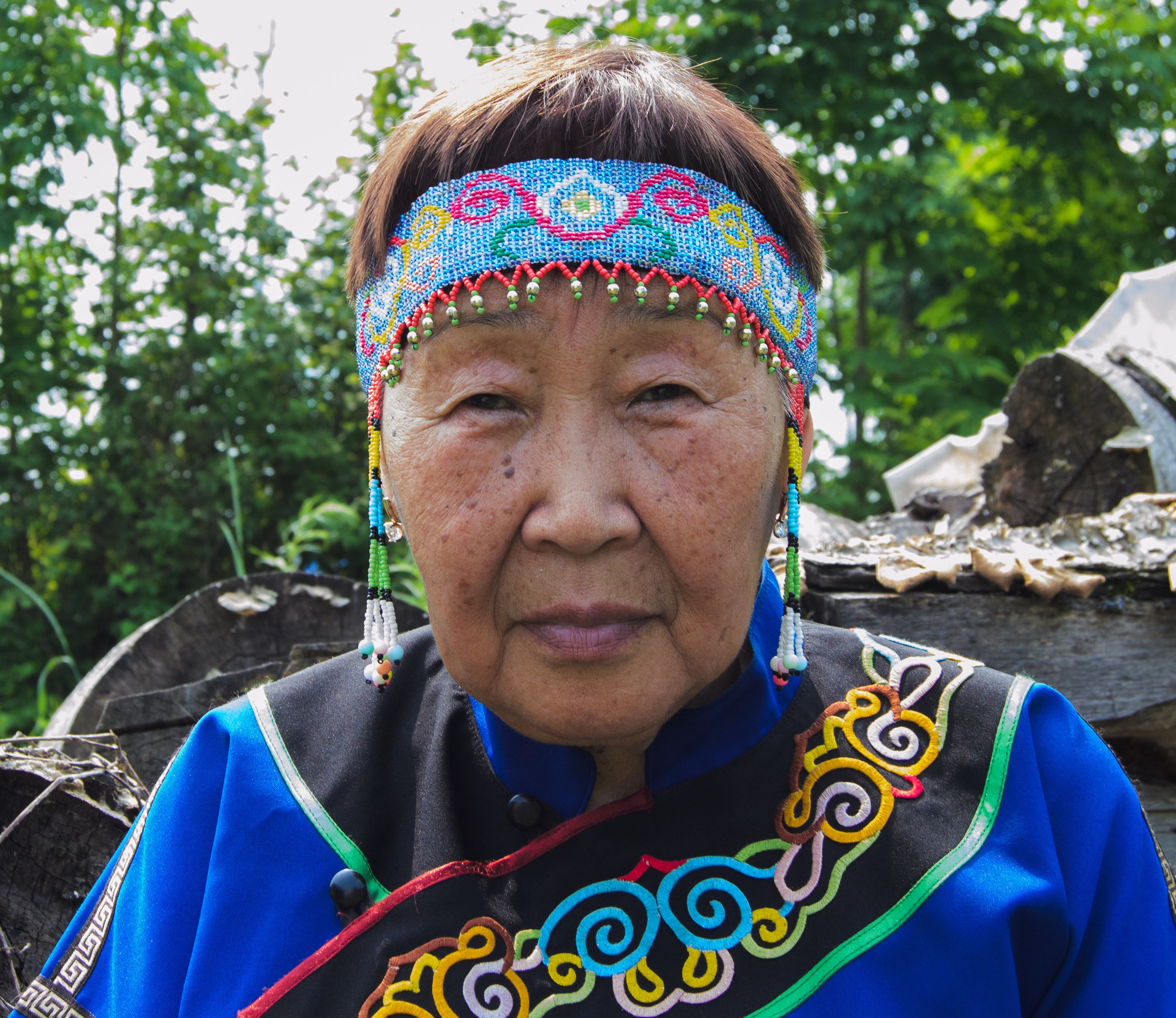
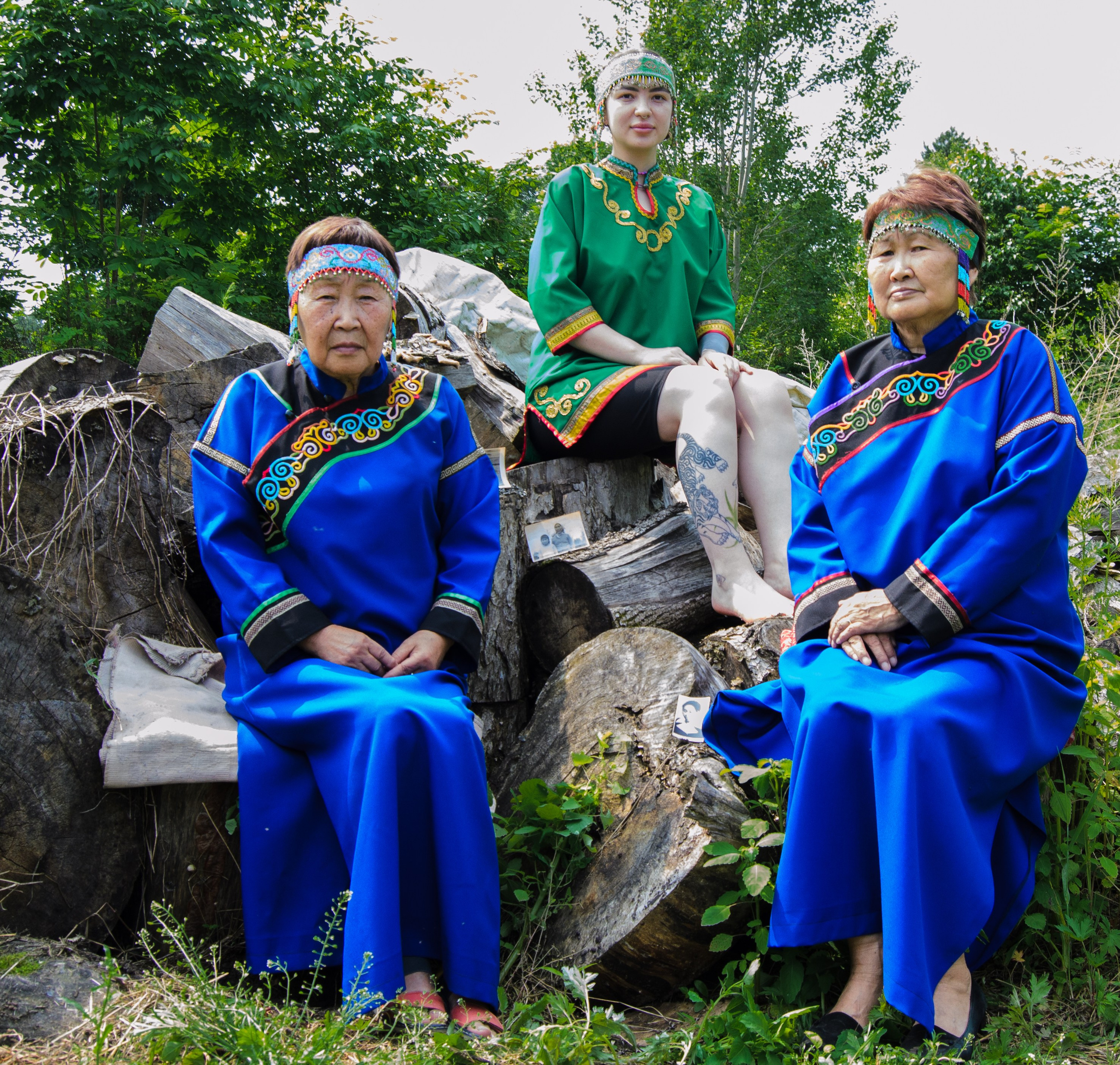
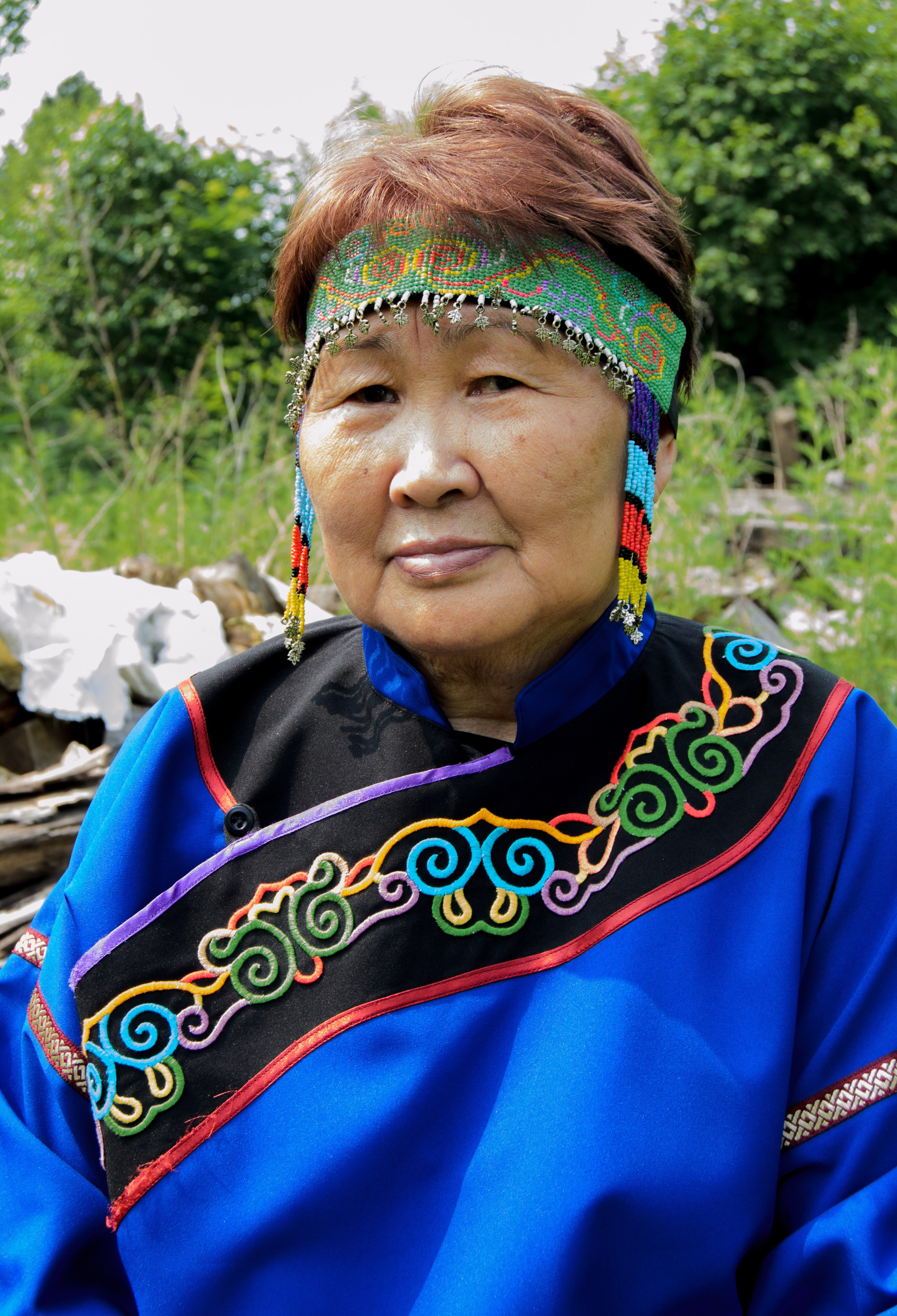
“The river of our birth waved us goodbye with a cheerful wave. White crests, like goose feathers, curled on the water. We looked ahead. Life led us along a bright road. The river was carving a new channel”
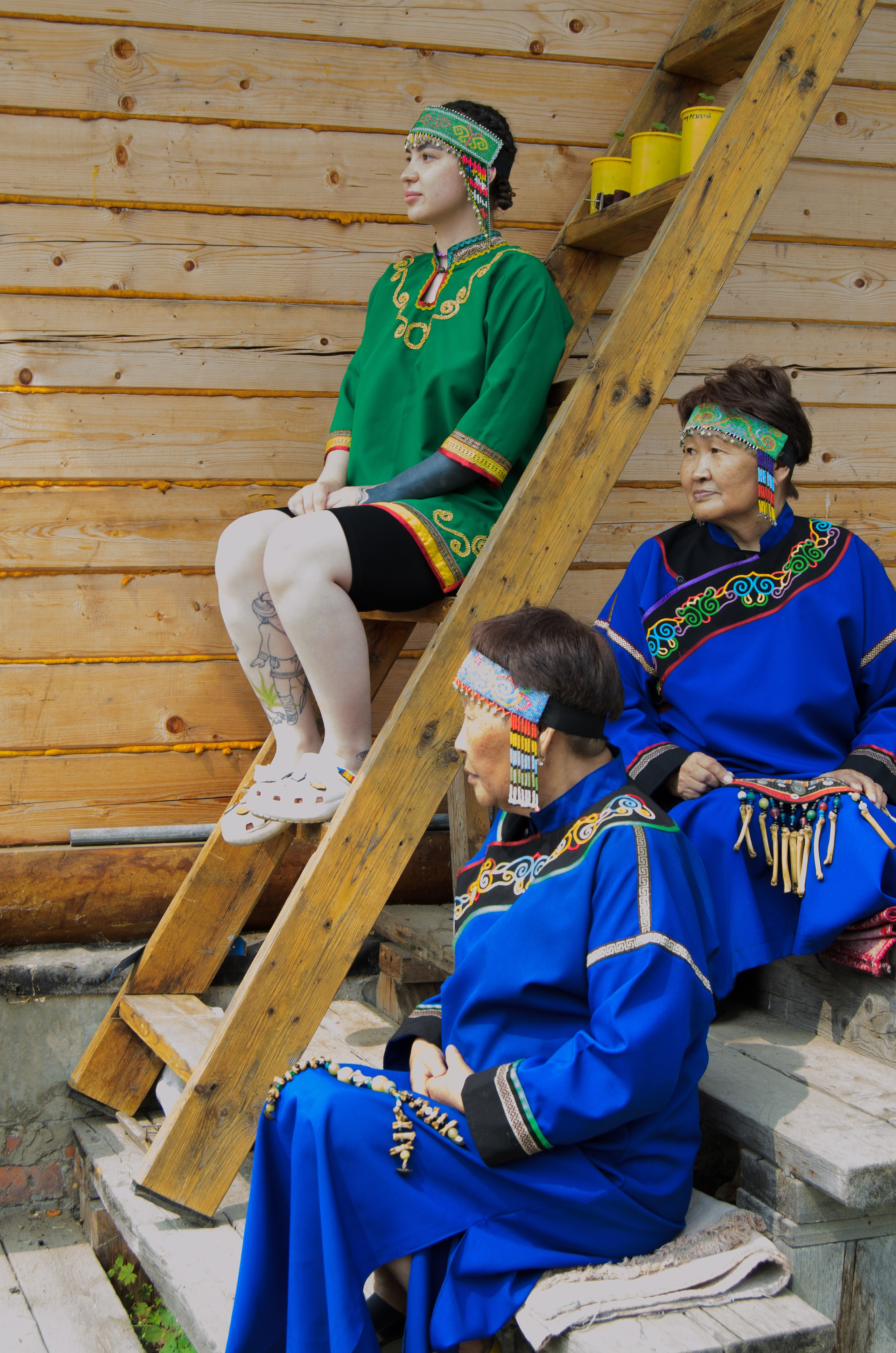
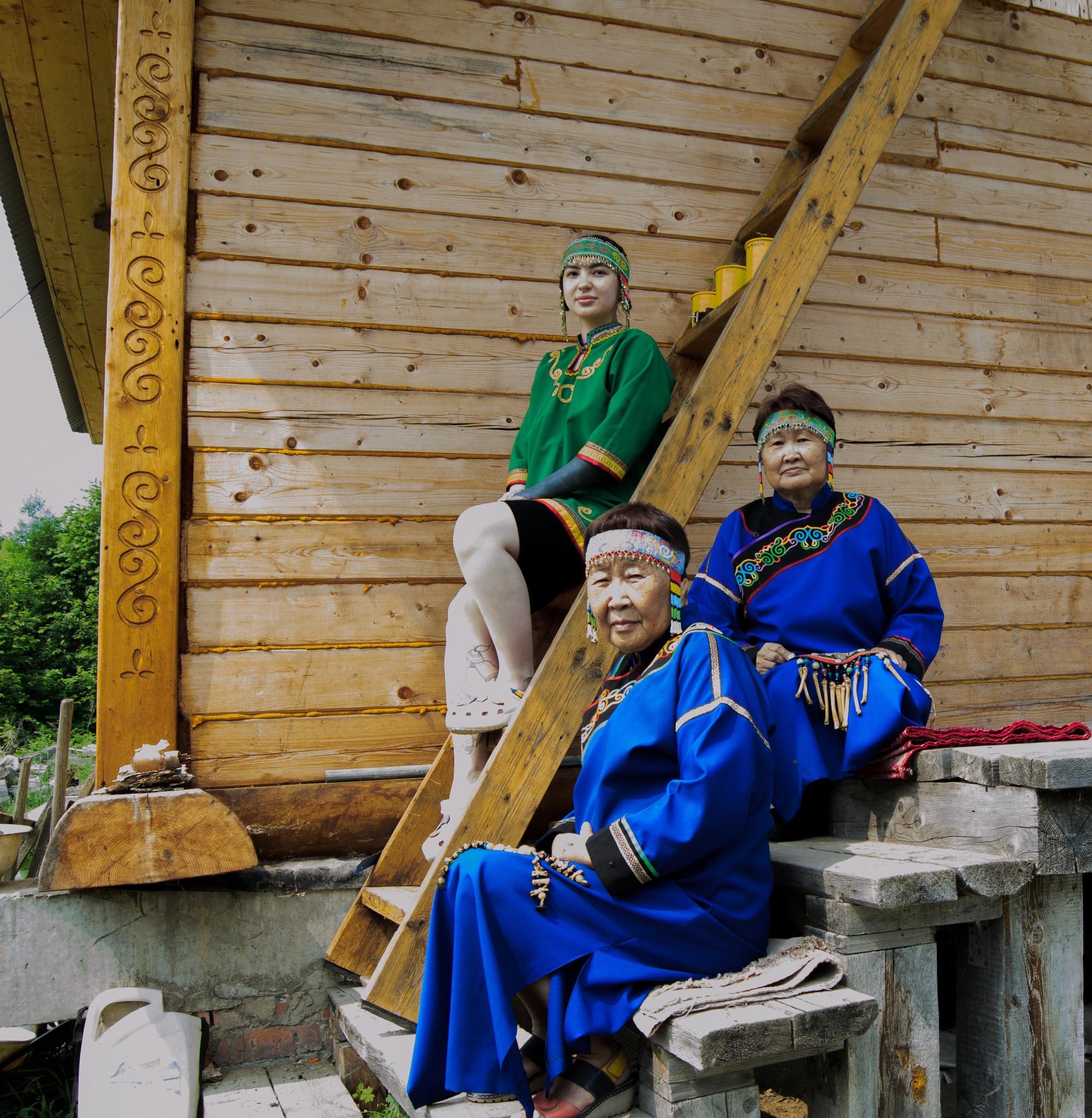
Фото проекты
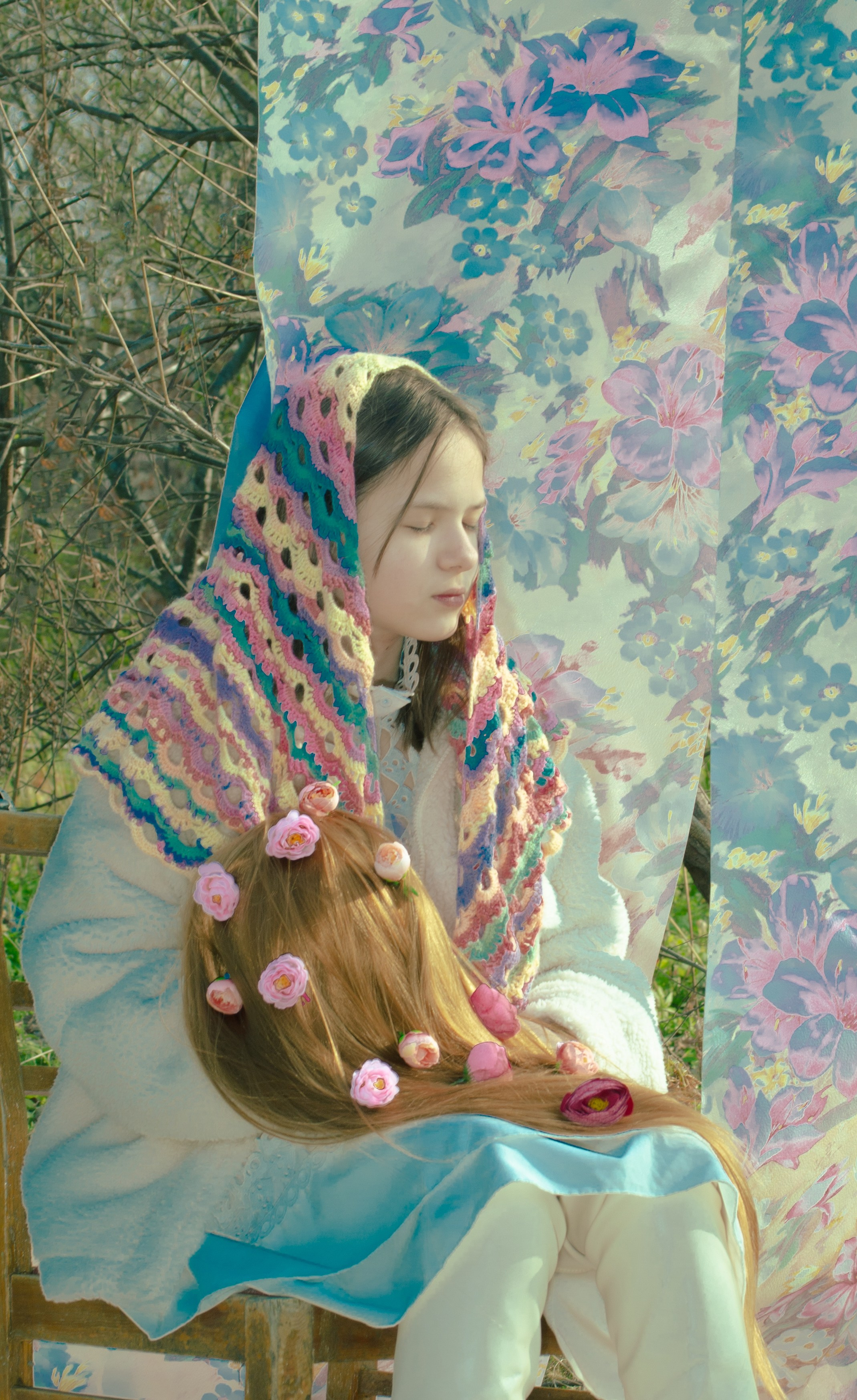
puberty
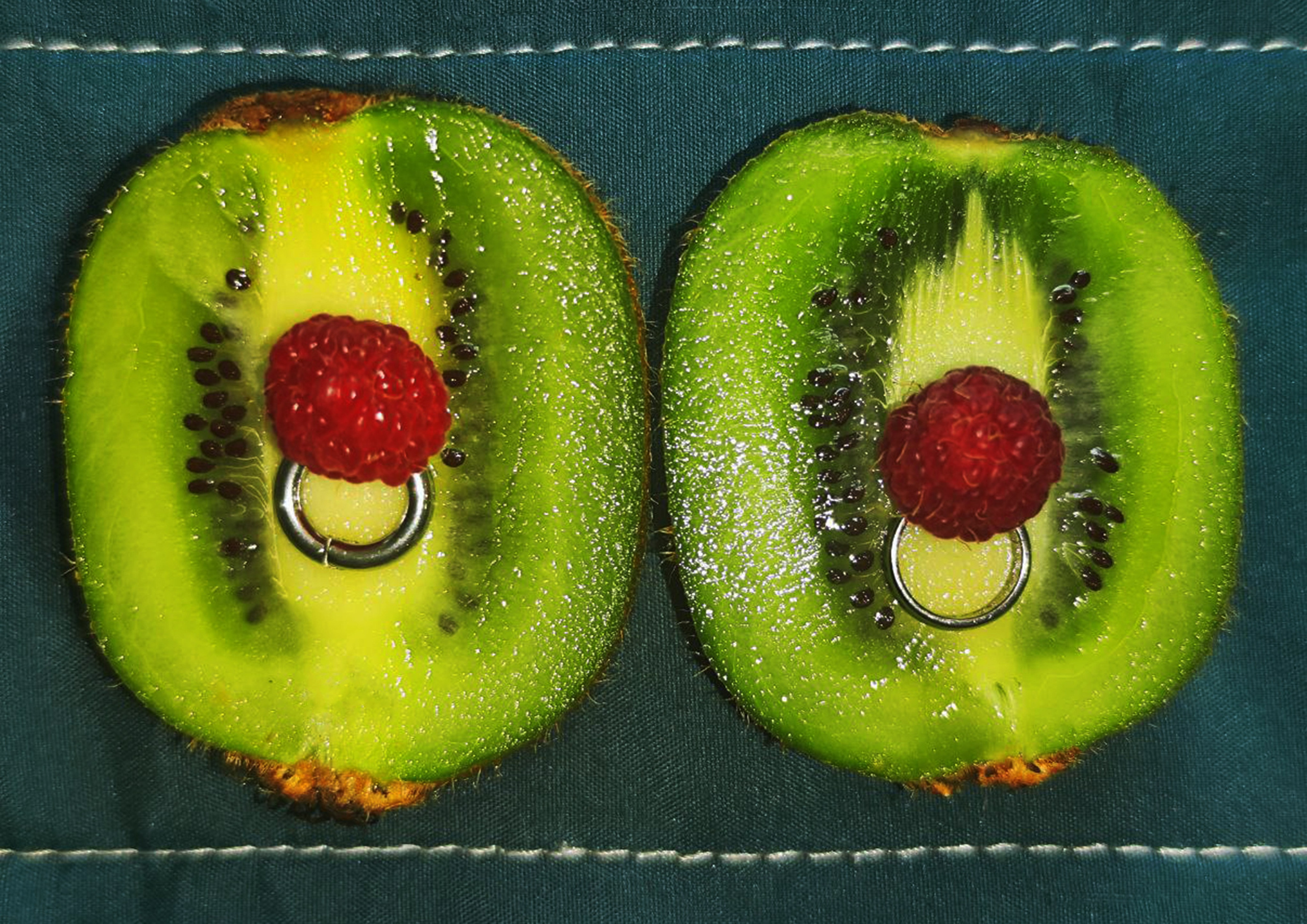
Guide for men
